https://www.blackgate.com/
Goth Chick News: The Hairy Problem of Werewolf Movies
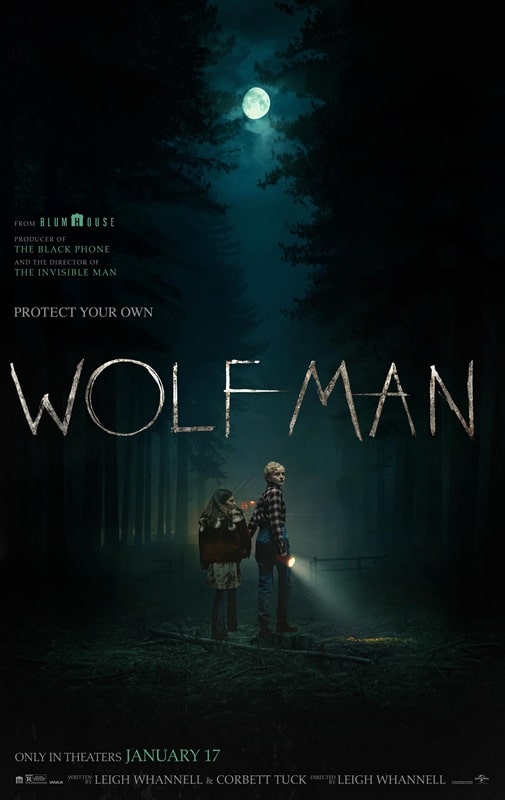 Wolf Man (Universal Pictures, January 17, 2025)
Wolf Man (Universal Pictures, January 17, 2025)
Why oh why can’t Hollywood produce a decent werewolf movie?
I’ve had my heart broken twice in the past few months, first by The Beast Within (2024) and most recently by Wolf Man (2025).
I first told you about The Beast Within starring Kit Harington, back in August. In summary, it was lousy. Though the trailer implied a suspenseful, cohesive tale, Beast was a rambling affair that didn’t seem to know what it wanted to be. As for an actual werewolf transformation, it was implied but never really materialized. Instead, director Alexander J. Farrell tried to distract us from this fact with a knee-jerking series of events that barely held together as a story. Even putting Harington half-naked in a dog collar wasn’t enough to make me forgive this mess.
So, if you tell me I should have known better when, with renewed hope, I ran off to the theater last weekend to see Wolf Man, I wouldn’t argue.
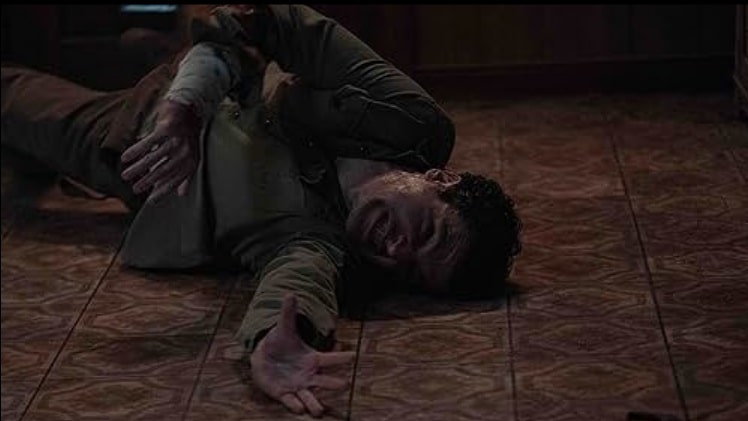 Wolf Man
Wolf Man
Making another attempt at revitalizing the classic monsters franchise ahead of opening its “Dark Universe” park in May, Universal Studios got behind this werewolf movie produced by Blumhouse, which made me think there was a chance it would be good. Afterall, it was Jason Blum who inspired Universal to give their Dark Universe movie franchise another go after Tom Cruise’s The Mummy was an unmitigated atrocity.
Universal had scrapped all the big-budget monster remakes they had teed up, which was more than fine with most fans, including me. Then here comes indie production company Blumhouse, hitting a home run with The Invisible Man (2020). Making nearly $145M on a $7M budget that’s a 20x return, meaning Hollywood couldn’t throw new projects at Jason Blum fast enough. When I heard Blumhouse had been handed the remake of Wolf Man (1941) I dared to be cautiously optimistic.
What a mistake.
I can count on one hand the number of times I’ve sat in a theater looking at my watch. I nearly always find something to love about most movies, but Wolf Man was so awful I would have got up and left had it not been for the tiny flame of hope I had that maybe the ending would redeem my two-hour investment.
It didn’t.
Here’s how Universal described Wolf Man:
Golden Globe nominee Christopher Abbott (Poor Things, It Comes at Night) stars as Blake, a San Francisco husband and father, who inherits his remote childhood home in rural Oregon after his own father vanishes and is presumed dead. With his marriage to his high-powered wife, Charlotte (Emmy winner Julia Garner; Ozark, Inventing Anna), fraying, Blake persuades Charlotte to take a break from the city and visit the property with their young daughter, Ginger.
But as the family approaches the farmhouse in the dead of night, they’re attacked by an unseen animal and, in a desperate escape, barricade themselves inside the home as the creature prowls the perimeter. As the night stretches on, however, Blake begins to behave strangely, transforming into something unrecognizable, and Charlotte will be forced to decide whether the terror within their house is more lethal than the danger without.
Sounds promising right? And for the first 20 minutes or so it kind of was. The dialog was lame, but the premise was interesting. En route to the childhood home in the middle of nowhere, the family gets into an accident and as they extricate themselves from the wreckage, the dad is bitten by an animal that runs off before they get a good look. Que the slow transformation of the dad into a werewolf which could have been awesome but instead was so drawn out and mind-numbingly boring it made me angry.
And come on – we had two fabulous werewolf movies back in the 80s in the form of The Howling (1981) and American Werewolf in London (1981), so someone in Hollywood must have kept the instructions on how to create a credible werewolf transformation with practical effects.
 Wolf Man
Wolf Man
But no. Wolf Man not only failed in its plot and dialog, but it utterly and completely defecated the mattress in creating an even remotely interesting werewolf.
So why does Hollywood keep getting werewolves wrong? The answer might lie in their complexity. Werewolves require nuance, and filmmakers seem allergic to it. Moreover, there are considerable technical challenges of depicting a werewolf convincingly. While CGI can be incredible, the extreme overuse of computer effects has resulted in a bit of audience backlash, causing filmmakers to go back to practical effects which clearly can’t keep pace with a modern audience’s expectations.
Finally, there’s a lack of fresh ideas. Perhaps it’s time for filmmakers to take inspiration from outside the box—or at least hire a scriptwriter who doesn’t think “lycanthropy” is just a fancy word for mood swings.
Despite these missteps, there’s still a tiny glimmer of hope for us werewolf fans. Enter Robert Eggers, the visionary director behind Nosferatu (which I’ve seen multiple times and absolutely loved – more on that next week). Eggers has announced his next project, Werwulf, will be a period horror film that promises to blend folklore, psychological terror, and meticulously crafted visuals into the ultimate werewolf tale.
Fans of Eggers know his penchant for historical authenticity and atmospheric storytelling, which could make Werwulf the fresh take that the genre desperately needs. With Eggers at the helm, there’s genuine hope that audiences will finally get a werewolf film that balances primal horror with emotional depth.
Hollywood, the ball’s in your court. But for now, maybe leave the werewolves alone for a bit. They deserve a better cinematic fate than what they’ve had recently.
The Sword and Planet of Edgar Rice Burroughs, Part I
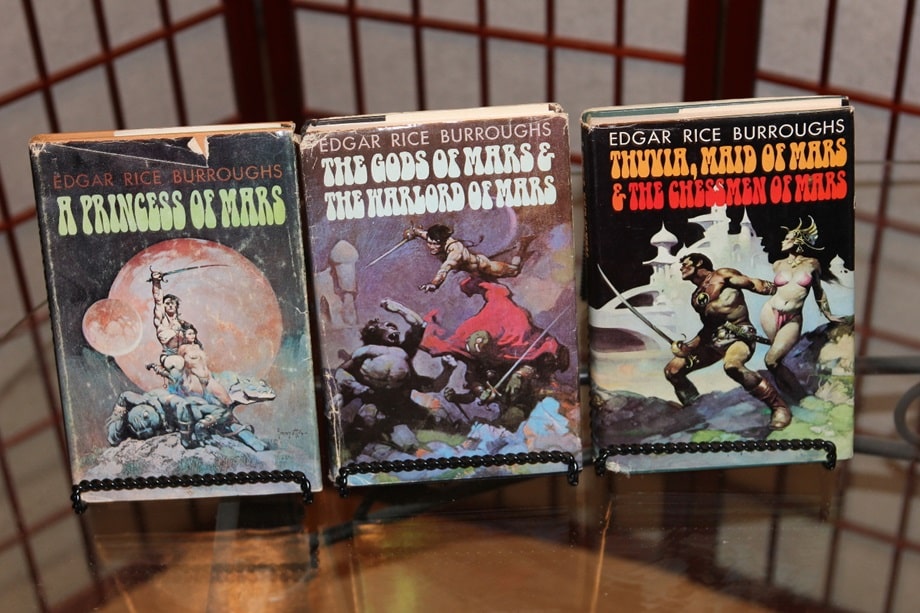 Edgar Rice Burroughs’ Barsoom novels: A Princess of Mars, The Gods of Mars and The Warlord of Mars, and Thuvia, Maid of Mars and The Chessmen of Mars (Science Fiction Books Club, July 1970, January 1971, and January 1973). Covers by Frank Frazetta
Edgar Rice Burroughs’ Barsoom novels: A Princess of Mars, The Gods of Mars and The Warlord of Mars, and Thuvia, Maid of Mars and The Chessmen of Mars (Science Fiction Books Club, July 1970, January 1971, and January 1973). Covers by Frank Frazetta
For sheer fun and adventure there’s nothing better in my opinion than Sword & Planet fiction (also called Interplanetary Adventure, Interplanetary Romance, or Planetary Romance). But exactly what is Sword & Planet fiction? Well, Edgar Rice Burroughs (ERB) created the prototype in 1911 with A Princess of Mars, which featured an Earthman named John Carter who is mysteriously transported to Mars, called Barsoom by its inhabitants.
The basic Sword & Planet story involves an earthman (rarely an earthwoman up to this point in time; 2025) on a strange world where he must use his wits, his muscles, and his sword against a host of human and nonhuman foes. The hero is generally chivalrous and the setting is an exotic alien world, often with multiple suns or multiple moons, populated by a variety of strange plants, animals, and intelligent beings. Magic is virtually non-existent, but there may be elements of “super-science,” such as open-decked flying ships or even ray-guns, although the latter take second billing to the blade. The emphasis is on swashbuckling sword fights, wild escapes, and desperate rescues.
[Click the images for Mars-sized versions.]
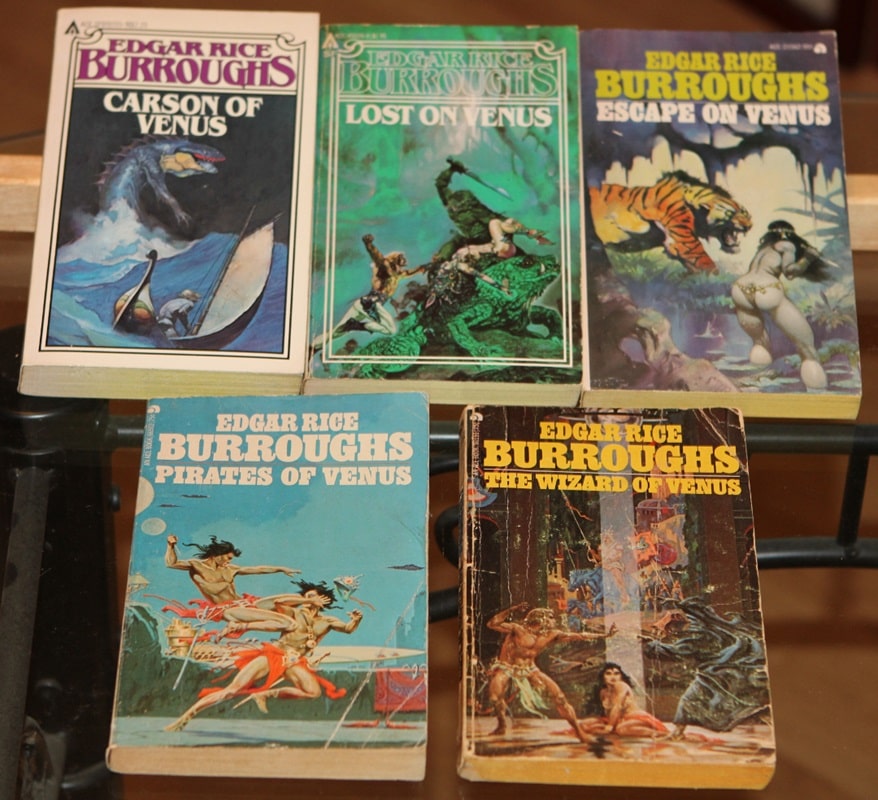 Edgar Rice Burroughs’ Venus novels: Carson of Venus, Lost on Venus, Escape on Venus, Pirates of Venus, and The Wizard of Venus (Ace Books, June 1979, June 1979, January 1974, March 1973, and January 1973). Covers by Frank Frazetta, Esteban Maroto, Frazetta, Roy G. Krenkel, and Roy G. Krenkel
Edgar Rice Burroughs’ Venus novels: Carson of Venus, Lost on Venus, Escape on Venus, Pirates of Venus, and The Wizard of Venus (Ace Books, June 1979, June 1979, January 1974, March 1973, and January 1973). Covers by Frank Frazetta, Esteban Maroto, Frazetta, Roy G. Krenkel, and Roy G. Krenkel
In addition to the Barsoom books, ERB also wrote a second Sword & Planet series, five books set on Venus (Amtor to the natives), featuring the earthman Carson Napier. Napier is intending to fly a rocket ship to Mars but ends up crashing on cloud-covered Venus.
He finds a world of giant trees and strange creatures, and, of course, a princess. Her name is Duare. Like Barsoom, Amtor mixes the primitive with super science, but the emphasis is on action, adventure, and personal combat with edged weapons.
 Escape on Venus, The Moon Men, Pirates of Venus, A Fighting Man of Mars, and The Chessmen of Mars (Ace Books, 1964, October 1962, January 1963, March 1963, and December 1962). Covers by Roy G. Krenkel, Ed Emshwiller, Krenkel, Krenkel, and Krenkel
Escape on Venus, The Moon Men, Pirates of Venus, A Fighting Man of Mars, and The Chessmen of Mars (Ace Books, 1964, October 1962, January 1963, March 1963, and December 1962). Covers by Roy G. Krenkel, Ed Emshwiller, Krenkel, Krenkel, and Krenkel
The five books in the series are:
1. Pirates of Venus
2. Lost on Venus
3. Carson of Venus
4. Escape on Venus
5. The Wizard of Venus
The Wizard of Venus is a novelette that wasn’t published until after ERB’s death. The book includes a second novelette called “Pirate Blood.”
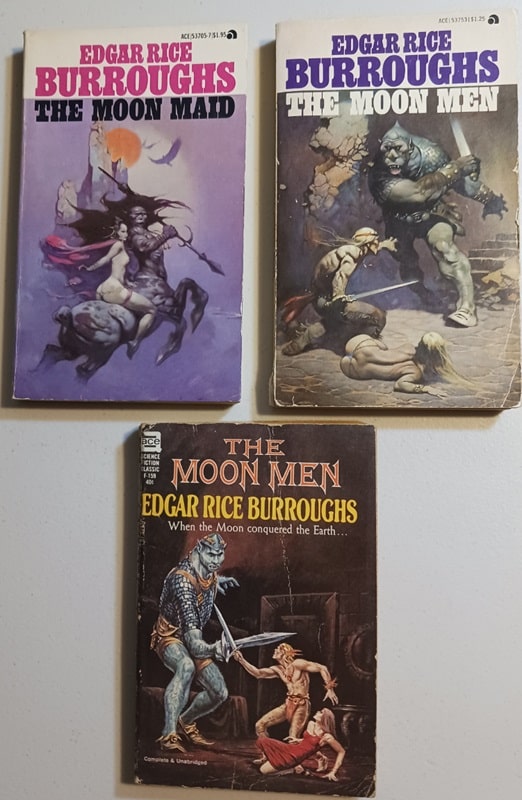 The Moon Maid, The Moon Men, and The Moon Men (Ace Books, January 1974, March 1974, and October 1962). Covers by Frank Frazetta, Frazetta, and Ed Emshwiller
The Moon Maid, The Moon Men, and The Moon Men (Ace Books, January 1974, March 1974, and October 1962). Covers by Frank Frazetta, Frazetta, and Ed Emshwiller
I enjoyed ERB’s Venus books a lot but they were not the equal of his Mars books — in my opinion. A lot of this has to do with Carson Napier. He’s no John Carter. He is a hero, and brave, but he makes plenty of mistakes and often needs to be rescued himself. He also uses more advanced weapons — essentially ray-guns — on many occasions. That means less “swashbuckling,” a minus for me. Certainly, though, if you’re interested in S&P fiction, the Venus books are a must.
The Venus books have been released in various editions. The pictures I have above mix older and newer editions. The older ERB books have covers and illustrations by Roy G. Krenkel, Jr, one of my favorite artists. Some of the newer ones have Frazetta images, and Frazetta was influenced by Krenkel.
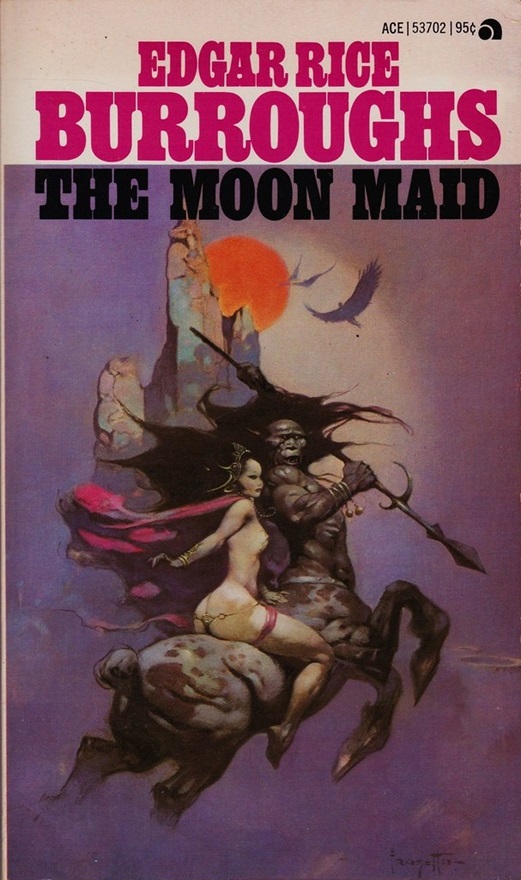 The Moon Maid (Ace Books, January 1974). Cover by Frank Frazetta
The Moon Maid (Ace Books, January 1974). Cover by Frank Frazetta
A series that I would have liked to see more of from ERB was his Moon Maid series. It’s sometimes described as a trilogy, but only the first book is full length. That’s The Moon Maid (copyright 1923). The sequels are novellas called The Moon Men and The Red Hawk (copyright 1925), which I first read combined in a later Ace book called The Moon Men. The novellas are reprinted from the pages of Argosy All-Story Weekly, where the tales were first serialized in 1925.
The Moon Maid has an awesome Frank Frazetta cover that is one of my favorites among his works. I have two copies of The Moon Men, one with a Frazetta cover and the other with a cover by Ed Emsh.
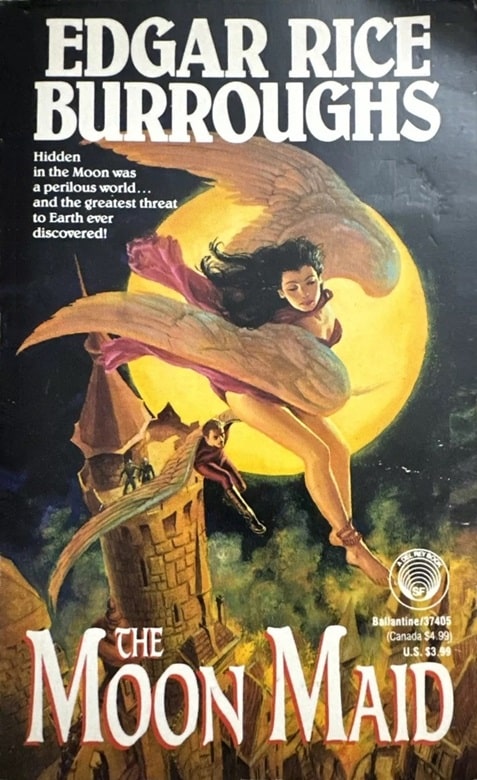
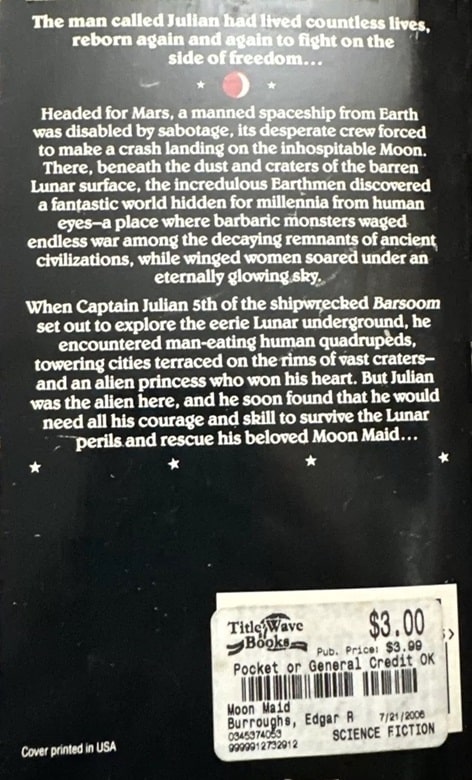
The Moon Maid (Del Rey Books, May 1992). Cover by Laurence Schwinger
The hero in The Moon Maid is Julian the 5th, an Earthman who has lived through many previous incarnations and remembers them. He is leading a rocket ship journey to Mars when the ship has to make a forced landing on the Moon.
They find an oxygen atmosphere inside the moon, and a wild land of strange creatures, including human-type and centaur-type intelligent races. Julian meets a princess of the human-type, Nah-ee-lah, and must rescue her. There’s lots of action and hand to hand combat, although not a lot of sword fighting. I would classify it as S&P.
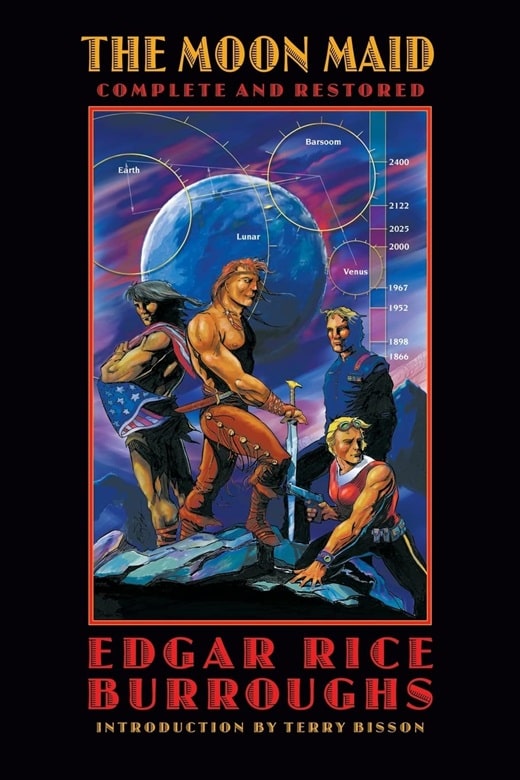
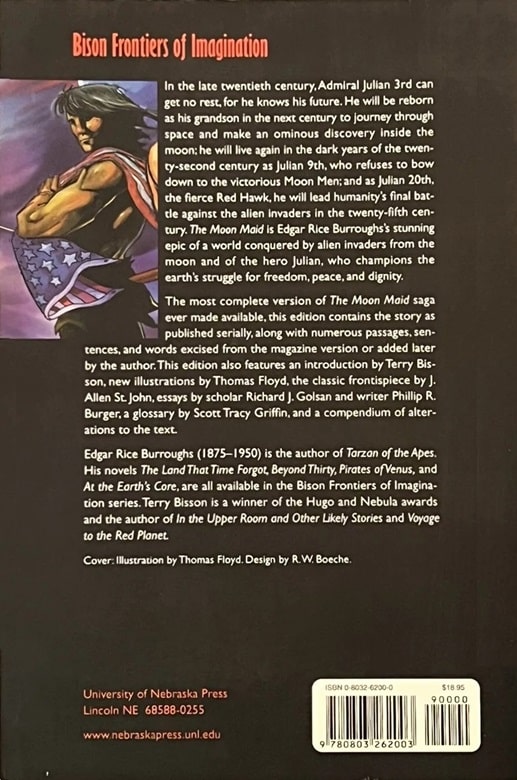
The Moon Maid: Complete and Restored (Bison Books, April 2002). Cover art by Thomas Floyd
The Moon Men and The Red Hawk are not — properly speaking — S&P fiction, because they take place on Earth. In The Moon Men, the Kalkar inhabitants of the Moon have conquered Earth. Julian the 9th, another reincarnation, leads a revolt, but it remains to “Red Hawk,” a descendent of Julian to finally free Earth from the Lunarians’ rule.
The three parts of the Moon trilogy have been published together by Bison books along with all kinds of extras (see above). I don’t have that copy yet but will get it for my collection. The series is one of ERB’s best.
More on Burroughs, including Tarzan and The Land that Time Forgot, in my next post.
Charles Gramlich administers The Swords & Planet League group on Facebook, where this post first appeared. His last article for Black Gate was The Masters of Narrative Drive.
Howard Andrew Jones, a Mentee’s Perspective
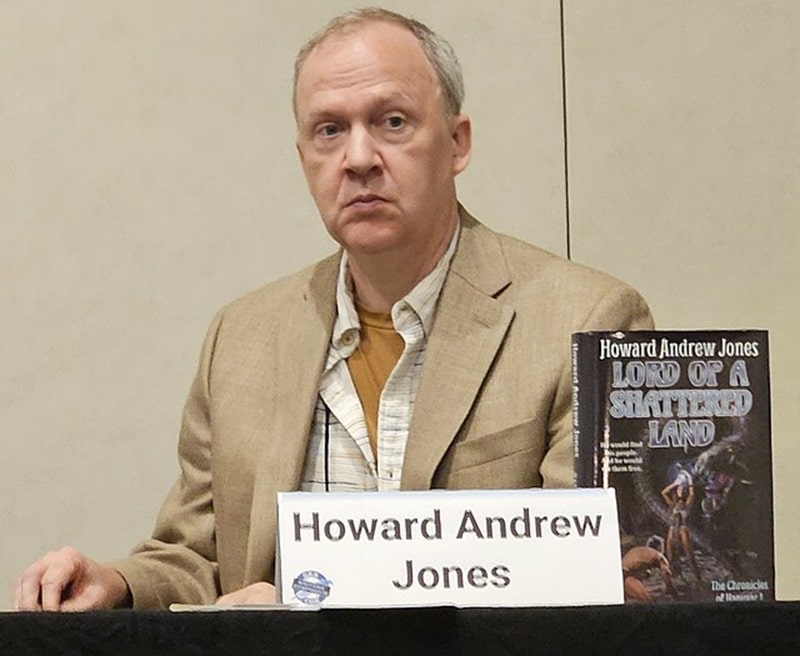 Howard Andrew Jones at GenCon, 2023
Howard Andrew Jones at GenCon, 2023
In 2019, I had an idea: a lot of my friends loved reading sword and sorcery fiction, but they didn’t write it. They would say, “One day.” Many of my undergraduates also expressed interest in writing fantasy, but they often felt discouraged by form rejection letters (genre magazine slush piles are epic). Having studied the history of genre fiction, I knew about the old tradition of “fanzines”— not-for-profit amateur publications that provided a low-stakes outlet for new writers. Just submitting work, collaborating with an editor, and seeing it in print can transform someone’s self-image from being just a reader to being a writer.
So, after some conversations with friends and a bit of encouragement, I started thinking seriously about launching my own zine.
As an academic, I’m deliberate by nature. I like to consult and take my time. Honestly, if I could have formed a committee for this, I probably would have. Instead, I decided to email someone: Howard Andrew Jones.
[Click the images for larger versions.]
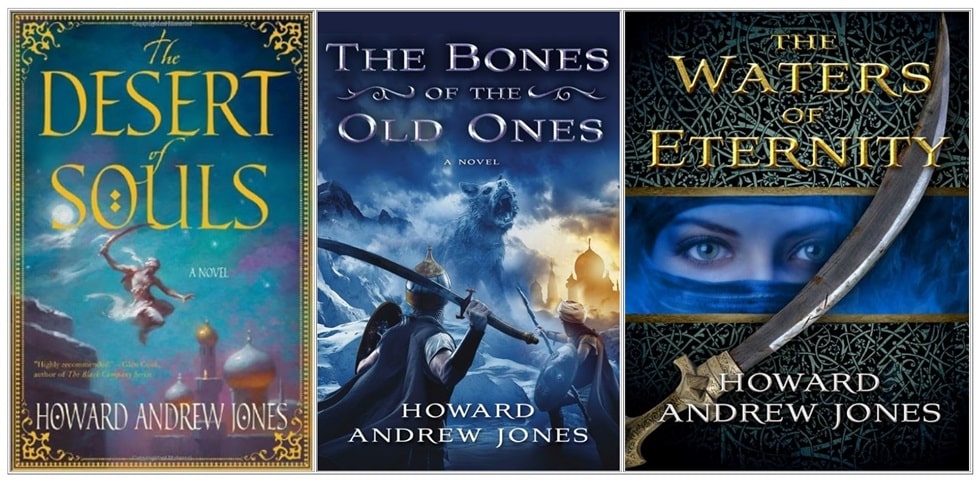 The three Dabir and Asim volumes: The Desert of Souls, The Bones of the Old Ones, and the collection The Waters of Eternity (Thomas Dunne Books, February 2011, December 2012, and November 2011). Covers by Charles Keegan, Steve Stone, uncredited
The three Dabir and Asim volumes: The Desert of Souls, The Bones of the Old Ones, and the collection The Waters of Eternity (Thomas Dunne Books, February 2011, December 2012, and November 2011). Covers by Charles Keegan, Steve Stone, uncredited
At the time, I didn’t know Howard personally, but I knew of him. He was a celebrated name in sword and sorcery. Howard had published an e-zine (Flashing Swords) in the genre, written essays and edited for Black Gate, and authored an incredible series of novels set in a sword-and-sorcery-inspired Arabia featuring Dabir and Asim (The Desert of Souls and The Bones of the Old Ones). He was also working on a new trilogy, The Ring-Sworn Trilogy, and I had already read the first book.
On top of all that, Howard had written several fun Pathfinder RPG novels, and he was editing Tales from the Magician’s Skull, the magazine for contemporary sword and sorcery fiction, published by Goodman Games. I loved that magazine. If anyone could give me advice on starting a zine, it was Howard.
I didn’t expect much when I emailed him. I wrote a long message, gushed a bit as a fanboy, and sent it off. Honestly, I wasn’t really expecting a response.
The next day, I was in my campus office grading papers when my office phone rang. My office phone never rings. In my ten years at CNU, maybe one student has ever called me. It’s practically an artifact – a dusty relic of a bygone era. My first instinct, as a millennial, was to let it go to voicemail. That’s what you do: let them leave a message and call back after some breathing exercises.
But for some reason, I picked it up.
“Hello?”
“Jason?”
“Yeah, this is Jason.”
The voice on the other end was calm, relaxed, with a kind of deliberate enunciation.
“Heeey, Jason! This is Howard.”
“Howard?” I said, not quite connecting the dots.
“Howard Andrew Jones. You emailed me about a magazine idea.”
I still get a little emotional thinking about that first call. Maybe I’m projecting, but I was immediately surprised, disarmed, and touched. Howard had gone out of his way to call me – call me! My office number isn’t even in my email signature, so he must have looked me up online to find my CNU contact info. I hadn’t even expected a reply, and here was this great author, taking the time to phone me.
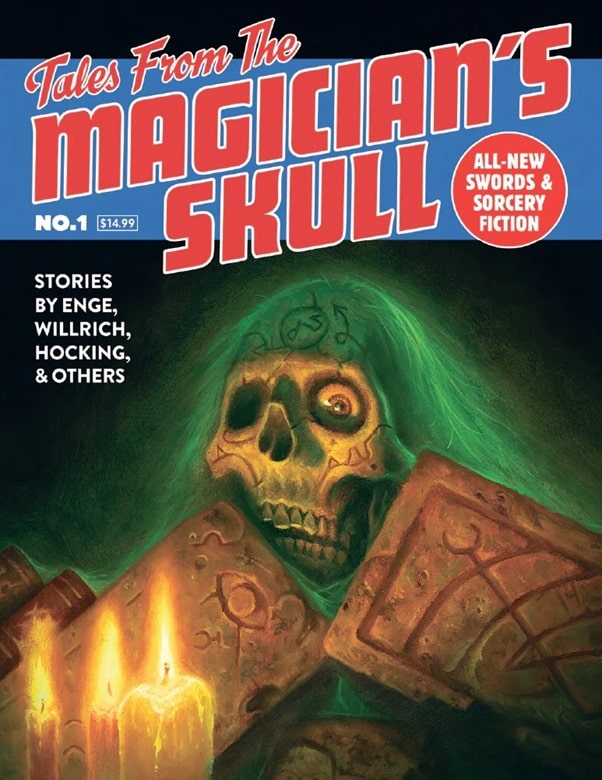
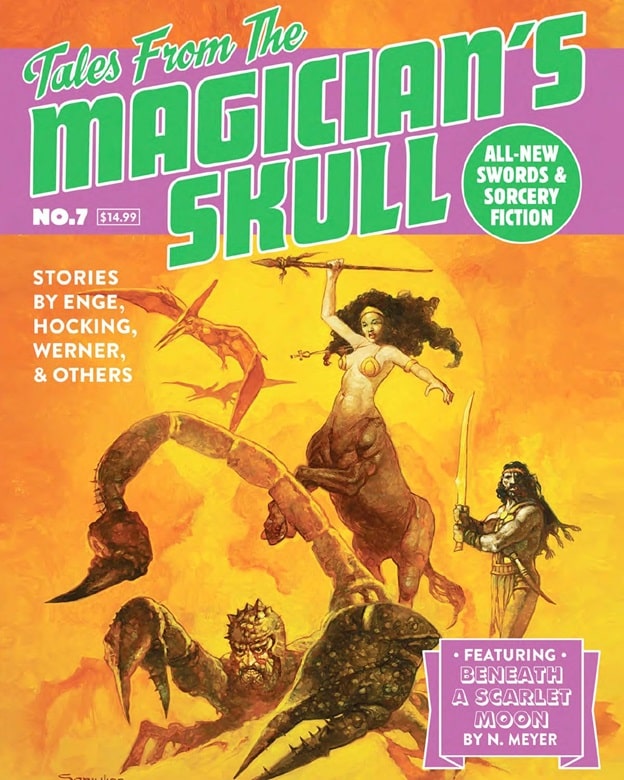
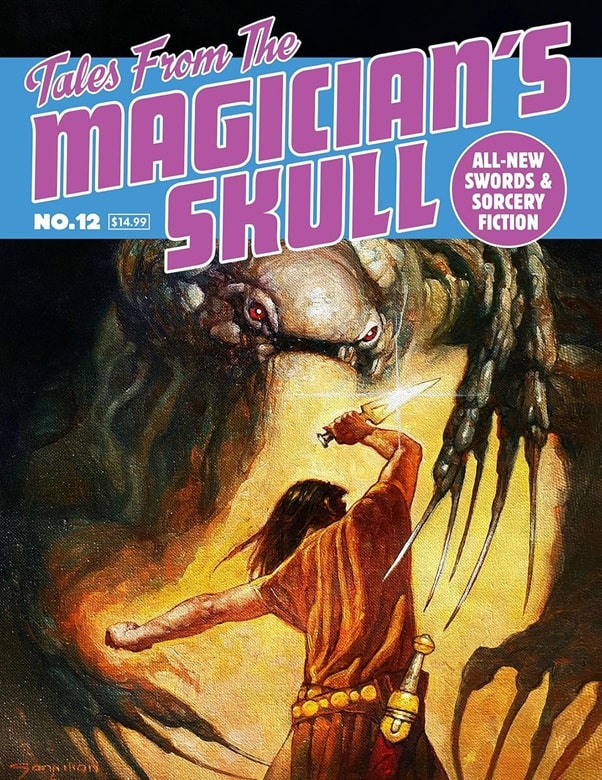
Tales of the Magician’s Skull, edited by Howard Andrew Jones. Issues 1, 7, and 12
(Goodman Games, 2017, 2022, and 2024). Cover art by Jim Pavelec and Sanjulian
I was a bit starstruck when we first talked. I’m already an awkward person, but the awkwardness was dialed up as I tried to gather my bearings. Howard, however, was so kind, calm, and genuinely enthusiastic about fiction, writing, and fantasy literature that I found myself speaking to him like an old friend. I’m pretty sure we talked for over an hour during that first conversation. I remember he was multitasking while on the phone – taking out the trash or doing yard work.
In the years that followed, whenever I spoke to Howard, he always seemed to be en route somewhere – driving to town, running errands, sometimes saying, “Hold on, I’ve got to grab this thing.” He felt real and grounded in a way that made people feel at ease. He gave off this sense of being completely unaware of how cool he was or how others saw him – or, if he did know, he just didn’t put much stock in it.
Over the next five years, Howard and I stayed in almost constant contact. We texted regularly. Often, he’d reply to a message with something like, “You free? Driving to town.” When I started my magazine and created an associated Discord server, he joined and became as active there as anyone, if not more so.
His comments were always supportive, kind, and encouraging. He shared favorite authors, thoughts on prose style, and a steady drip of wisdom for aspiring writers. Whenever anyone mentioned his work, he would chime in, “Thanks for reading it,” “Glad it worked for you,” “Really appreciate the kind words.”
Outside of Discord, we talked on the phone often. One thing I noticed was that Howard frequently mentioned his friends – not in a name-dropping way, like he wanted you to know he knew big authors, but in a way that made you feel like you were part of this collaborative effort, this network of fellow creatives. To him, it seemed, writing wasn’t a solitary pursuit but a shared craft. It was like Howard was always attending a seminar on fiction, and his calls were a way of touching base to see how your progress was going.
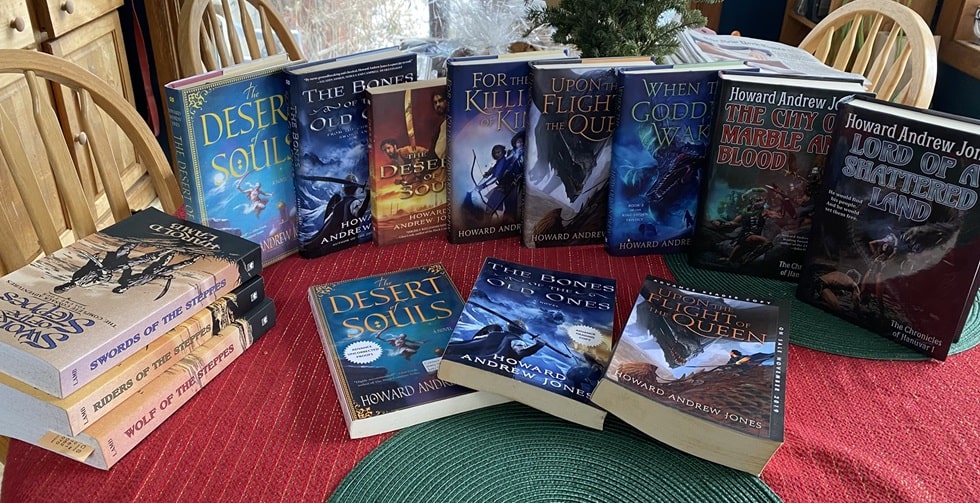 The books of Howard Andrew Jones
The books of Howard Andrew Jones
For instance, he’d say something like, “Hocking and I were talking about dialogue – how it needs to reveal character but economically, like in hardboiled detective fiction” (I’m paraphrasing). From the way he spoke, I got the sense that Howard had a lot of writer friends, and they talked about the craft of writing the way master carpenters might talk about solving technical problems with wood.
Fandom can get a little gossipy, but Howard never said a negative thing about anyone. He was almost stubbornly kind and assumed the best intentions from people. Being in touch with him felt like being welcomed into a very supportive club. Over time – without me even realizing it – Howard became something of a mentor or even a sensei in sword and sorcery writing.
At first, we just talked about sword and sorcery (a genre he was deeply opinionated about – he really didn’t like Tros of Samothrace (“Bounced right off it)), but our discussions evolved into broader topics: writing, work, heroism, and how storytelling affects people’s lives. I can honestly say I learned a lot about writing from him, at least an MFA’s worth, or more.
I met Howard in person three times over the six years I knew him. I saw him at GenCon, the big gaming convention that also includes a section for genre writers. We sat on several panels together discussing sword and sorcery fiction. He attended Howard Days, a celebration of Robert E. Howard, the pulp author who created sword and sorcery (yes, it gets confusing). And then I saw him again at GenCon this past August of 2024.
In August, aside from a persistent leg injury, Howard seemed… OK. I need to be honest and say he struck me as a little blue at GenCon, and he suspected it was due to the injury or the associated medication treating it. He had every reason to be happy. He had just published the first two books of his Hanuvar series. If I remember correctly, book three, Shadow of the Smoking Mountain, had just come out or was coming out. At the convention, he gave me an ARC and signed it with the words, “Find a way or make one.” I took this as a nod to the writer’s life, a reminder to persevere and create despite the challenges.
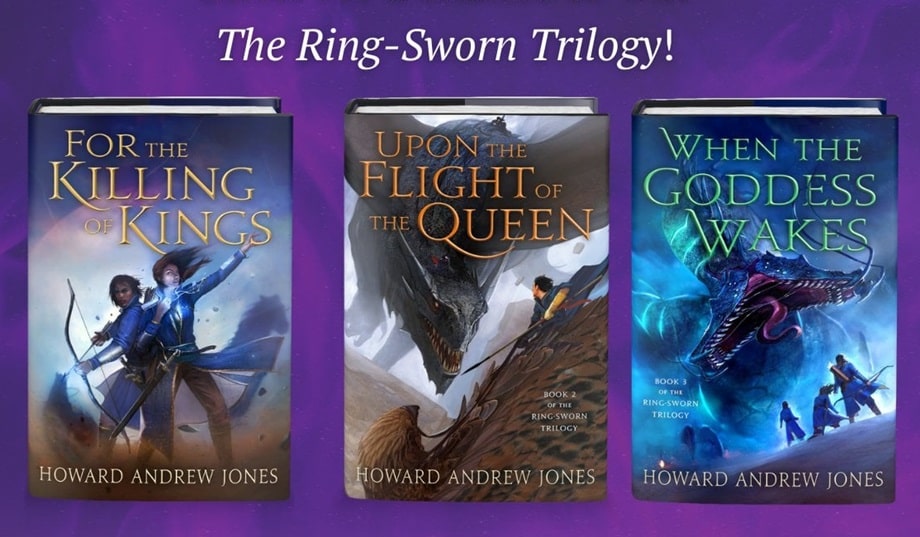 The Ring-Sworn Trilogy by Howard Andrew Jones (St. Martin’s Press, 2018-2021). Covers by Lauren Saint-Onge
The Ring-Sworn Trilogy by Howard Andrew Jones (St. Martin’s Press, 2018-2021). Covers by Lauren Saint-Onge
On the last day of GenCon, literally just before leaving, Howard, my wife Nicole, and I had lunch together. It was the first time Howard had met Nicole. She joked and referred to Howard as “my friend in my pocket” because I was always texting with him. I laughed and told her, “You don’t understand – this guy is so cool. He’s the nicest guy you’ll ever meet.”
That might sound like grief-motivated hyperbole now, but, in hindsight, it wasn’t. That’s exactly how I spoke about Howard before I knew anything was wrong.
Nicole and I had lunch with him, and of course, they hit it off. I can’t recall the details but Howard was fascinated with Nicole’s life growing up on a farm (did Howard come from a rural background?). After the meal, Howard said he was glad to have met her.
We left the restaurant. There were hundreds of people in the corridors at GenCon, a veritable sea of humanity, and Nicole and I were ready to leave, luggage in hand. So, we said our goodbyes. I had no idea it was the final goodbye. Howard gave me a hug and said, “Well, safe travels to you and your beautiful wife. And, keep writing.” Then he disappeared into the crowd.
A few weeks later, I learned he had gone to the hospital with acute symptoms.
I’m still in the anger phase of all this. Howard was such a good guy. It felt like, as a writer, he was hitting his peak. In my view, he had so much more to give the world – not just through his novels but through who he was as a person. I know my story is just one of many similar ones. That’s the kind of person Howard was: everyone who met him seemed to come away with a story about his kindness. This tragedy couldn’t have happened to a more undeserving person.
Howard, you’ll be missed, man. Thanks for being you.
Jason Ray Carney is a Lecturer in Popular Literature at Christopher Newport University. He is the author of the academic book, Weird Tales of Modernity (McFarland), and the fantasy anthology, Rakefire and Other Stories (Pulp Hero Press). He edited Savage Scrolls: Thrilling Tales of Sword and Sorcery for Pulp Hero Press and is an editor at The Dark Man: Journal of Robert E. Howard and Pulp Studies and Whetstone: Amateur Magazine of Sword and Sorcery. His last article for Black Gate was a review of Lord of a Shattered Land.
Savage Sword of Conan is Back
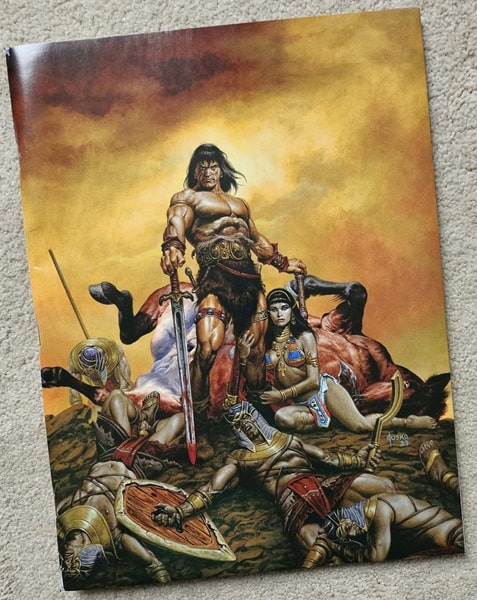


Savage Sword of Conan #1 (Titan Comics, February 2024). Cover art by Joe Jusko
Savage Sword of Conan, from Titan Comics, is the comic book that I have been waiting for. It is a thing of perfection: art, story, presentation, physical format – all unmatched.
The cover by Joe Jusko is brilliant, capturing some brutal imagery from the prose story within, penned by Jim Zub. I loved Joe’s work on the original SSoC run.
The introduction by Roy Thomas was a delight. Roy was the mastermind behind Conan the Barbarian and Savage Sword of Conan, but he’s also known for creating characters such as Wolverine, Vision, Werewolf by Night, Luke Cage, Iron Fist, Ultron, and scores more. Hearing that he had plans to contribute to this magazine filled me with joy.
[Click the images for savage-sized versions.]
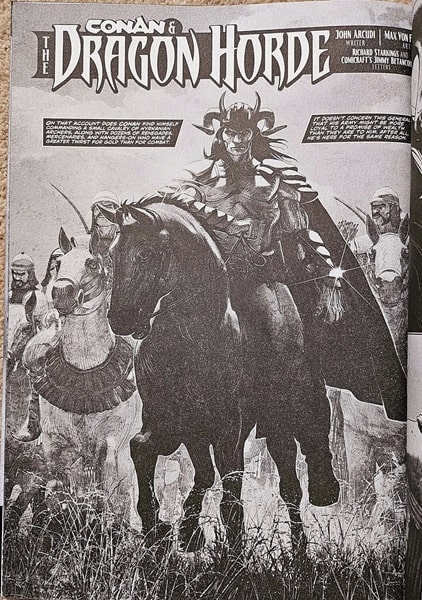
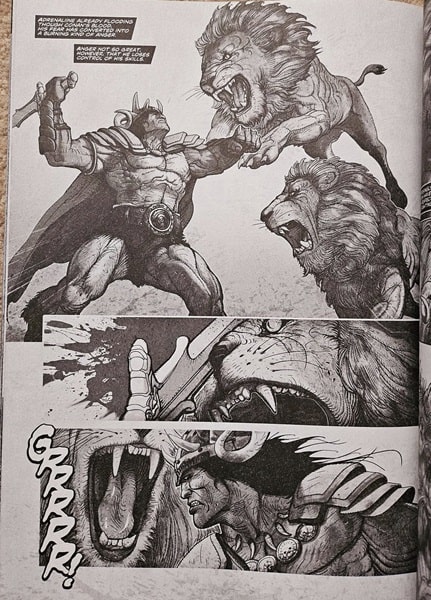
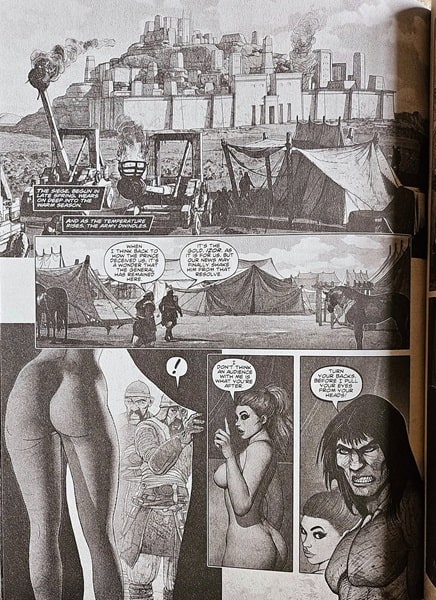
Interior pages from Savage Sword of Conan #1. Art by Max Von Fafner
The first story in SSoC #1 is called “Conan and the Dragon Horde,” written by John Arcudi, with art by Max Von Fafner. It has violence, bloodshed, nudity, sex, murder, betrayal, greed, superstition, intrigue, and horror. It is a classic Conan yarn that includes a fascinating female protagonist. Maybe she’ll stick around, or maybe she’ll go her own way, like Valeria. I can’t wait to see.
The prose story by Jim Zub, “Sacrifice in the Sand,” was a pleasant surprise. I have to admit to almost always feeling a sense of dread when someone other than REH writes Conan, but by Crom, this Zub guy gets it, much like his contemporary, John C. Hocking. The story was short, but the action was intense, realistic, and engaging, with a nice little twist at the end. Congrats, JZ.
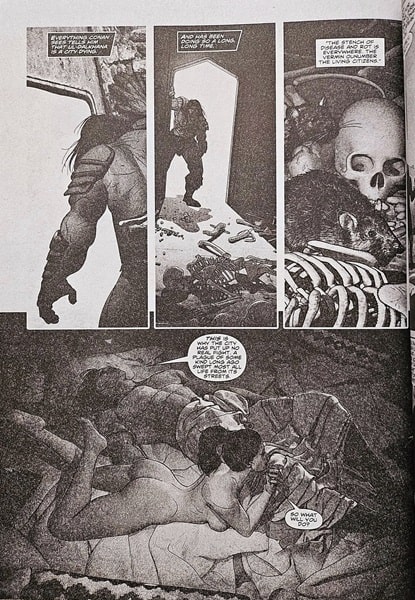
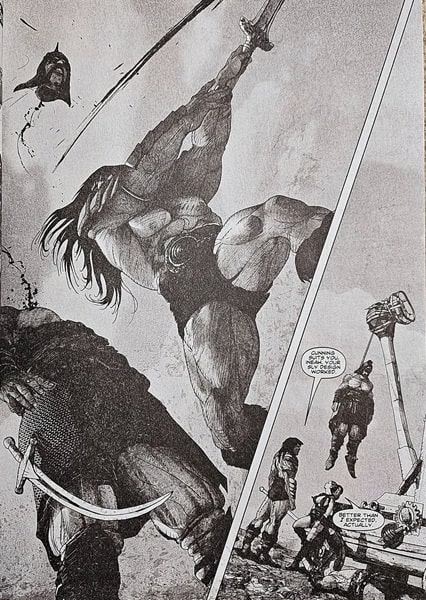

More interiors from Savage Sword of Conan #1. Art by Max Von Fafner
Next, we had a Solomon Kane yarn, “Master of the Hunt.” Placing an SK backup story in SSoC is chef’s kiss perfect. It brings back wonderful memories. Written and illustrated by Patrick Zircher, this was an excellent Gothic tale, with all that 1600s mood and tone. The Puritan gun-toting swashbuckler is one of REH’s finest creations, and he is well represented here.
The magazine closes with a piece by Jeffrey Shanks, who delves into the publishing history of Solomon Kane, which many readers will no doubt find fascinating. Jeff is a bona-fide REH scholar, much like my dog brothers, Mark Finn and Chris Gruber.
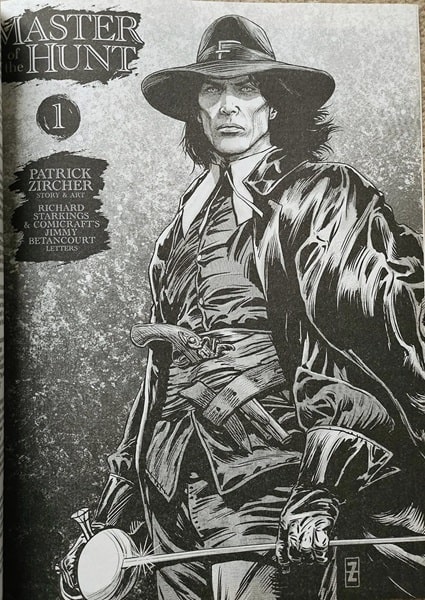


Interiors from Savage Sword of Conan #1. Art by Patrick Zircher and Howard Chaykin
This book was great. The husky offset paper is thick and opaque, yet has that newspaper quality to it, bringing back the nostalgia of the original run. You can smell the ink – it’s glorious.
One thing I would love to see in the future (and I know this is wishful thinking) is art by Val Semeiks in the pages of this series. I’ve been working with Val off and on for eight years on Hyperborea RPG content, and I think it would be a wonderful “full circle” event to see him back where he started – illustrating Kull in SSoC. I’d love to see that happen.
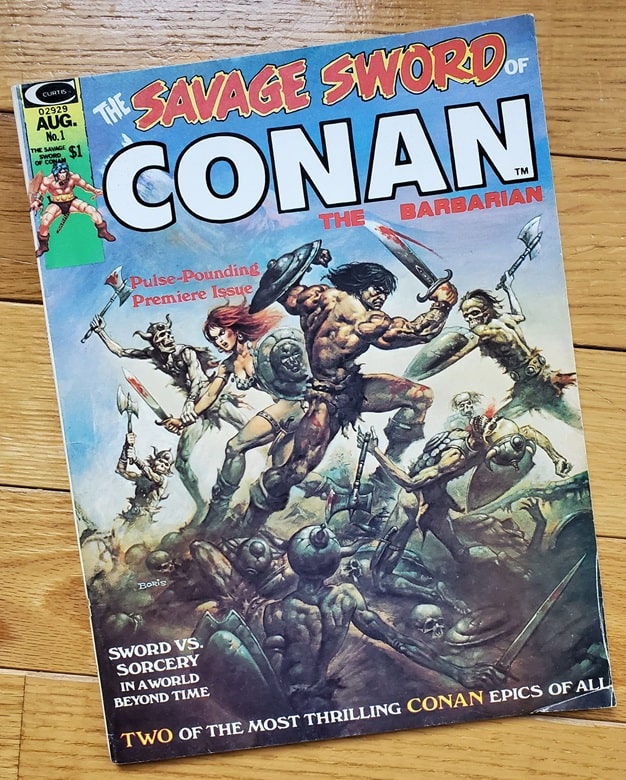
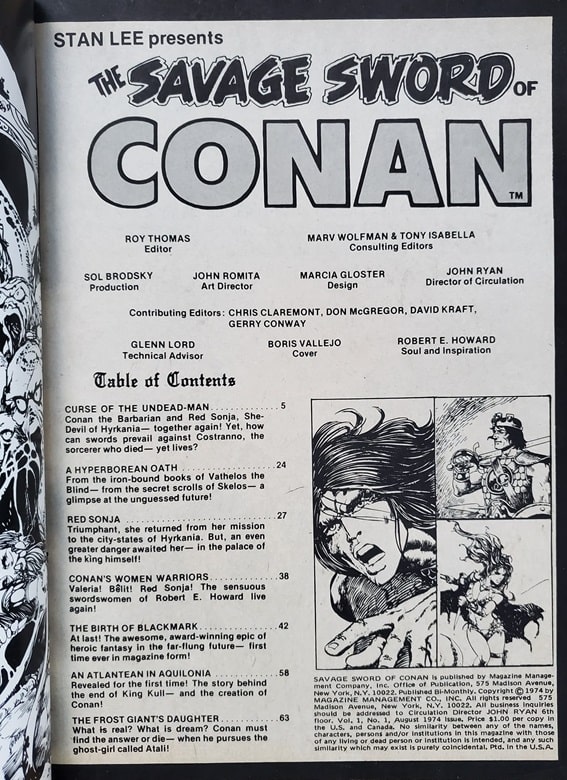
Savage Sword of Conan #1 (Marvel Comics, 1974). Cover by Boris Vallejo
The original Savage Sword of Conan #1 was published in 1974, featuring an incredible cover painting by Boris Vallejo (see above). It picked up where Savage Tales had left off, with Roy Thomas spearheading the efforts within.
The talent of the contributors is off the charts: John Buscema, Barry Smith, Alfredo Alcala, Gil Kane, Pablo Marcos, Esteban Maroto, Neal Adams, Ernie Chan, and a riveting article by Glenn Lord. All of it, as Roy Thomas states “… is dedicated to Conan and the other heroic-fantasy creations of the late Robert E. Howard (1906-1936).”
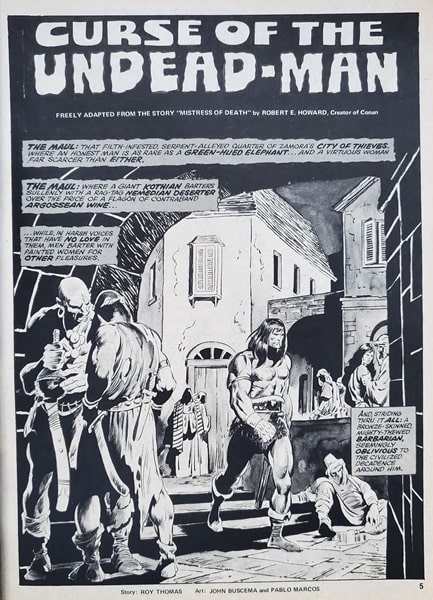


Interiors from Savage Sword of Conan #1 (Marvel Comics, 1974). Art by
John Buscema, Pablo Marcos, Esteban Maroto, Neal Adams, and John Chua
I already had a copy of this book, but I picked up this backup copy for $20 from my old pal, Chris, of Chris’s Comics.
For me, the most iconic Conan art was established by Frank Frazetta with his cover paintings on the Lancer paperbacks, and John Buscema with his cover and interior art in Marvel’s Conan the Barbarian and Savage Sword of Conan. When I was young, one of the things I always looked forward to was the next issue’s cover painting for SSoC.
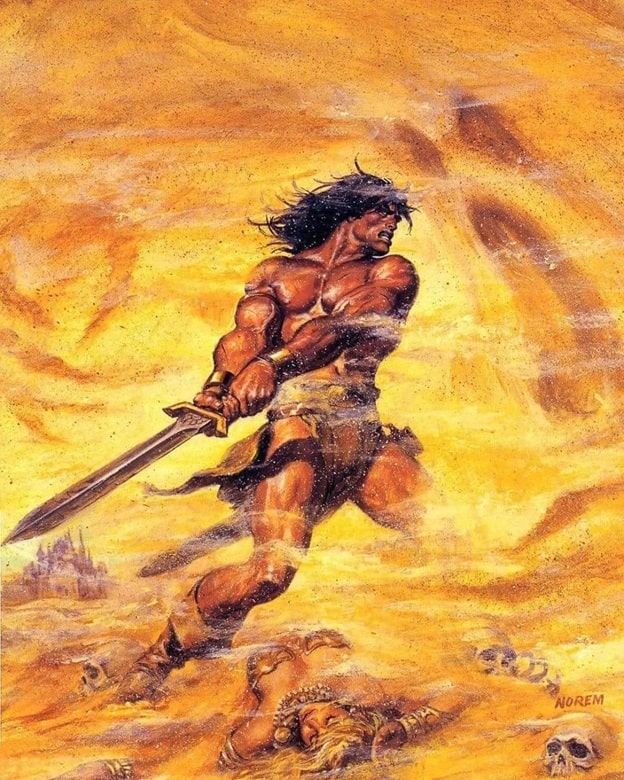 Cover art for The Savage Sword of Conan #54 (Marvel Comics, July 1980). Art by Earl Norem
Cover art for The Savage Sword of Conan #54 (Marvel Comics, July 1980). Art by Earl Norem
They rarely disappointed. Among those cover painting artists, one of my personal favorites was Earl Norem. I don’t believe he has received the attention he deserves for capturing incredibly dynamic scenes, such as the one pictured above, fighting a sand demon.
One of the prizes of my personal collection is the page below, purchased at a NY Comicon in the late 90s. This is an original page from Savage Sword of Conan #197, published in May, 1992.
 Original art from Savage Sword of Conan (Marvel Comics, May, 1992). Art by John Buscema and Ernie Chan
Original art from Savage Sword of Conan (Marvel Comics, May, 1992). Art by John Buscema and Ernie Chan
It features Roy Thomas writing, John Buscema pencils, and Ernie Chan inks. The ultimate creative dream team. On this page we see Conan, Belit, and Valeria. This is a one-of-a-kind piece that I will never part with!
One of the ultimate dream teams in comic book history was Roy Thomas, John Buscema, and Alfredo Alcala. The page below is from Savage Sword of Conan #20, adapting the Robert E. Howard story “The Slithering Shadow,” originally published in Weird Tales magazine in 1933. A sword-and-sorcery masterpiece.
 Splash page from Savage Sword of Conan #20, by Roy Thomas, John Buscema, and Alfredo Alcala (Marvel Comics, July, 1977)
Splash page from Savage Sword of Conan #20, by Roy Thomas, John Buscema, and Alfredo Alcala (Marvel Comics, July, 1977)
The third and final volume of Barbarian Life: A Literary Biography of Conan the Barbarian, by Roy Thomas, is a must-have for fans of Roy’s take on Robert E. Howard’s most famous character.
In thousands of four-color panels for Marvel Comics, Roy Thomas told the tale of Robert E. Howard’s greatest creation, Conan the Barbarian. Now, in this definitive biography and analysis, Roy chronicles Conan’s comic book life, issue by issue, plot by plot, and artist by artist.
For ten years, from October 1970 when Roy and artist Barry Smith assembled the first issue of Marvel’s Conan the Barbarian, to October 1980 when Roy and artist John Buscema completed their last issue together on the series, Thomas wrote of Conan’s gigantic melancholies and gigantic mirth — as well as the wars, the wenches, and the wizardry that bedeviled the Cimmerian from one issue to the next.
In this final volume of the series, Roy Thomas explains the creative process behind his final few issues of Conan the Barbarian, his run on King Conan, and selected stories published in Savage Sword of Conan. Additional features include a full-length interview with Roy, a short history of sword-and-sorcery in the comics, and the tale of Conan’s battles with the Comics Code.
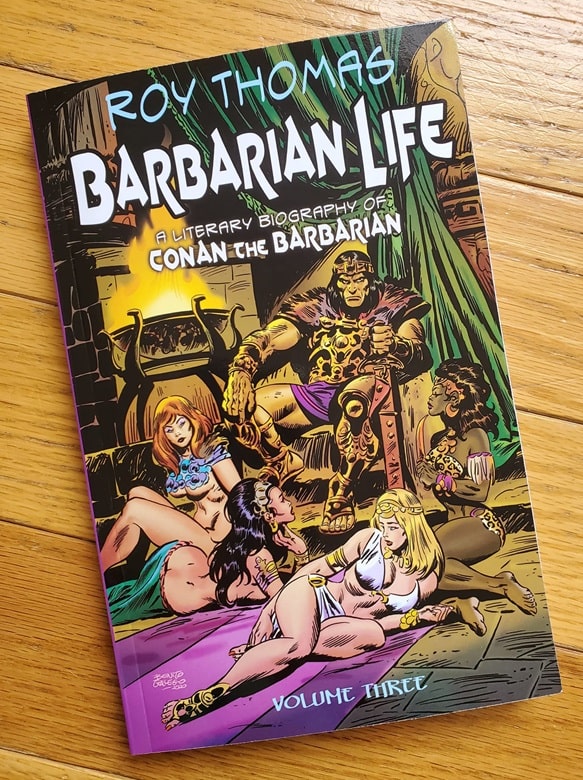 Barbarian Life: Volume Three: A Literary Biography of Conan the Barbarian by Roy Thomas (Pulp Hero Press, April 26, 2021)
Barbarian Life: Volume Three: A Literary Biography of Conan the Barbarian by Roy Thomas (Pulp Hero Press, April 26, 2021)
Now, I do want to preface what I am about to say by noting that my thoughts may be clouded by the nostalgia of my youth: lying on my bedroom floor, poring over my Conan comics and studying the words and art with rapt interest.
That being said, of all the pastiche authors who have developed new, original Conan tales, Roy Thomas may be my favorite — and he did it with the accompaniment of a brilliant visual medium, working with some of the finest artists of the day, such as the aforementioned Barry Smith and John Buscema, and also greats such as Alfredo Alcala, Gil Kane, and Ernie Chan.
Unfortunately, one of my favorite Conan artists, the incredible Val Semeiks, didn’t cross paths with Roy, but he deserves mentioning nonetheless for his breathtaking art.
Jeffrey P. Talanian’s last article for Black Gate was The Dreams in Gary’s Basement: Gary Gygax and the Creation of Dungeons & Dragons. He is the creator and publisher of the Hyperborea sword-and-sorcery and weird science-fantasy RPG from North Wind Adventures. He was the co-author, with E. Gary Gygax, of the Castle Zagyg releases, including several Yggsburgh city supplements, Castle Zagyg: The East Mark Gazetteer, and Castle Zagyg: The Upper Works. Read Gabe Gybing’s interview with Jeffrey here, and follow his latest projects on Facebook and at www.hyperborea.tv.
An Important Life – Howard Andrew Jones (1968 – 2025)
A LIFE IS NOT IMPORTANT EXCEPT IN THE IMPACT IT HAS ON OTHER LIVES – Jackie Robinson’s epitaph
 Mark Rigney, Howard Andrew Jones, Bob Byrne
Mark Rigney, Howard Andrew Jones, Bob Byrne
I did an interview last week with Jason Waltz for his ’24 in 42′ podcast (Yeah, I know: You just can’t wait to hear that one…).
One of the questions was about my favorite quote/lyric/poem/motivational thought. Some of you who know me probably figure it’s a Bible verse. And there are a couple that are right up there.
But it’s the epitaph on Jackie Robinson’s gravestone, which leads off this post.
My buddy Howard Andrew Jones has passed away from brain cancer. You’re going to see a LOT of people singing his praises in the coming weeks. All of it deserved. If I can stop crying long enough, my Monday morning post will be on Howard.
But you’re gonna see a common thread in the talk about Howard. The impact he had on other people’s lives. Especially in encouraging and helping writers – mostly in the sword and sorcery field.
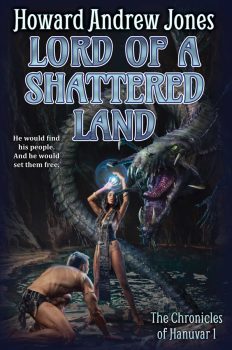 Measured by impact, Howard’s may well be the most important life in the past three-plus decades in the genre. He was relentless in being kind, helpful, encouraging, engaging – just fucking NICE – in an era when nice isn’t all that common anymore.
Measured by impact, Howard’s may well be the most important life in the past three-plus decades in the genre. He was relentless in being kind, helpful, encouraging, engaging – just fucking NICE – in an era when nice isn’t all that common anymore.
My favorite memories of Howard are our phone talks about hardboiled private eye fiction: not what you’d guess of one of the brightest lights in the sword and sorcery genre.
But as you read the posts about Howard here on FB, just keep noting how many people thank him for helping them. For impacting their lives and careers.
Howard totally lived that quote on Robinson’s headstone. More than most of us do. A good man who lived an important life.
The world’s light is a little less bright this wintry day. A star has gone out.
That was my response to seeing John O’Neill’s post on Friday, announcing that Howard had lost his battle with brain cancer. Facebook has been full of fond memories and sorrows from his many friends.
There are two people I’ve gotten to know somewhat through my writing/blogging, who were liked by everyone who knew them. No one had a bad word for mystery writer Bill Crider, or for Howard. He did not suffer bullshit well, but if you knew him, you were his friend. And you felt fortunate to be one.
I only met him once, at a Windy City Pulp Fest, but we talked on the phone, emailed, and FB messaged. I always enjoyed talking to him. We often compared the aches and pains of trying to remain physically active as we grew older. And suddenly, he won’t grow any older. Life can suck.
Regarding his work, my favorites are his Dabir and Asim Arabian stories. The two novels are epic Arabian fantasies – ‘swords and sandals’. But the short stories are really mysteries in an Arabian fantasy setting, and I love that! If you don’t at least have Waters of Eternity in digital, you totally should.
I liked his Pathfinder novels. The Ring-Sworn trilogy was good, but not one of my favorites.
I had not yet started his most recent trilogy, The Chronicles of Hanuvar, though I had read a couple short stories, which he incorporated into the first novel, ala Raymond Chandler (Howard was a hardboiled PI Pulp expert). I sat down Friday night, and I spent a chunk of my weekend working through Lord of A Shattered Land.
This is Howard’s best work. He had moved to another level. I assume books two and three will only drive that home. He had signed a five-book deal with Baen. They liked it so much, they added two more books to his contract.
 Howard was a year younger than me, and he had a lot of great writing years ahead of him. He was taken far too soon – I feel the same about Carl Wilson of the Beach Boys.
Howard was a year younger than me, and he had a lot of great writing years ahead of him. He was taken far too soon – I feel the same about Carl Wilson of the Beach Boys.
As I said in my FB post, Howard was nice. He was a genuinely good guy. He was fun to talk to, and he really was committed to helping people in the field. If you saw his FB updates on the chicks (he operated a farm) in winter, you got a sense of what a neat guy he was.
I got to visit him once after the news of his illness came out. That’s the pic above, with three of us Black Gaters together. He was still the gentle, soft-spoken soul I knew.
I hope the plaudits and the accolades keep coming. And I hope there’s something in his memory at 2025 Windy City.
Howard will be missed by many, for many years to come. The following is from his first Hanuvar novel, and it’s become the Howard quote for many of us, with his passing:
“Why are you crying? Warrior’s don’t cry.”
“They do when a hero dies.”
We lost a hero. I’m one of many who will miss you greatly, friend.
And if you’re looking for some modern fantasy to read, you really ought to grab that first book and check out one of the finest sword and sorcery writers of this century:
The Chronicles of HanuvarLord of a Shattered Land
The City of Marble and Blood
Shadow of the Smoking Mountain

Bob Byrne’s ‘A (Black) Gat in the Hand’ made its Black Gate debut in 2018 and has returned every summer since.
His ‘The Public Life of Sherlock Holmes’ column ran every Monday morning at Black Gate from March, 2014 through March, 2017. And he irregularly posts on Rex Stout’s gargantuan detective in ‘Nero Wolfe’s Brownstone.’ He is a member of the Praed Street Irregulars, founded www.SolarPons.com (the only website dedicated to the ‘Sherlock Holmes of Praed Street’).
He organized Black Gate’s award-nominated ‘Discovering Robert E. Howard’ series, as well as the award-winning ‘Hither Came Conan’ series. Which is now part of THE Definitive guide to Conan. He also organized 2023’s ‘Talking Tolkien.’
He has contributed stories to The MX Book of New Sherlock Holmes Stories — Parts III, IV, V, VI, XXI, and XXXIII.
He has written introductions for Steeger Books, and appeared in several magazines, including Black Mask, Sherlock Holmes Mystery Magazine, The Strand Magazine, and Sherlock Magazine.
In Dreams: David Lynch: 1946 — 2025
David Lynch is gone; he died Wednesday at the age of seventy-eight, bringing one of the strangest careers in American film to an end and leaving the rest of us to try to reach a conclusion as to what it all meant.
He never made a western. He never made a romcom or a workplace comedy. He never made a “prestige” period picture. He never made a buddy movie or an action movie or a heist movie or a (straightforward) crime movie. Not for him was getting hold of a franchise and riding it until it died of thirst in the desert; he wasn’t interested in making Mission Impossible 6 and 7/8. The only things he made were David Lynch movies (as the producers of Dune found to their dismay), and those were about as far out of the mainstream of American cinematic entertainment as it is possible to get and still be permitted within the city limits of Hollywood.
I resist calling him an “experimental filmmaker” — though there is a grain of truth in the description (in the effect of his work more than in its intent) — because I don’t think he was experimenting at all; I think he had a cement-solid vision of what film was and what it could do, and he knew precisely what he was up to every single minute.
For much of the past fifty years, people have spent countless hours burning up mental calories trying to “figure out” Eraserhead, Mulholland Drive, Fire Walk with Me, and Lost Highway, which seems to me to be a waste of time (though there are worse things to do with your idle hours). David Lynch’s films aren’t Sudokus, nor are they housing tract prospectuses or blueprints for can openers or toaster ovens; they’re dreams, and if his career illustrates anything, it’s how literal and flatfooted the vast majority of films are, and how very few filmmakers utilize to any degree the extraordinary power of the medium to dissolve and reconfigure the walls of reality. (In this a goof like Ed Wood beats most of today’s A-List directors, though Wood’s surrealism was the result of ineptness rather than art.)
Lynch’s most puzzling visions stubbornly resist dissection or definitive explanation, but most of the difficulty results from seeing them as puzzles in the first place. Instead, they’re spiritual weather reports; David Lynch was a meteorologist of the soul, and though he was American to the core, his movies have more in common with European films like Alain Resnais’ Last Year at Marienbad or Ingemar Bergman’s Persona or Hour of the Wolf than they do with the more commercial work of his American contemporaries.
The first Lynch film I saw was The Elephant Man (1980), which was (along with 1999’s The Straight Story) as “normal” a movie as he ever made. Even then, though, I knew that this was about as far from being a conventional, heartwarming, “disease-of-the-week” weepie as you could get. The difference becomes clear when you compare the film to the box-office winners of 1980 and imagine how the directors of The Empire Strikes Back, Private Benjamin, 9 to 5, or Coal Miner’s Daughter would have handled the story of John Merrick.
Not everyone responded positively to Lynch’s oblique, uncompromisingly interior approach, especially at first. It royally ticked off Roger Ebert, for instance, who was presumably upset that The Elephant Man wasn’t the sort of thing Sydney Pollack would have given us. Ebert also hated Wild at Heart (1990), Lynch’s off-kilter, violent, Wizard of Oz-inflected love story, though how the man who wrote Beyond the Valley of the Dolls could disdain “sophomoric humor” or criticize anyone for indulging in the “cop-out” of “pop satire” is beyond me.
As time went by, though, Lynch gathered more and more approval, but many critics praised him because of the attack they believed he was mounting on the values of what used to be called “Middle America.” What else could a movie like Blue Velvet be but a savage repudiation, an unqualified exposure of the wormy rot underneath the shiny linoleum?
However, in seeing Lynch as an unqualified celebrator of subversion, these critics were missing half the boat. Lynch didn’t believe that the “real truth” of the world was a hidden corruption that was bound to come out sooner or later and overwhelm everything, or that the scrubbed, brightly-polished surface of “normality” was nothing but a lie or a hypocritical sham.
He believed in the reality and power of both the decency and the corruption. You cannot accuse David Lynch of cynicism (Ebert’s mistake), but he was certainly as Manichean as they come, seeing as he did a world poised on the razor’s-edge between darkness and light, with each constantly trying to encroach on the other’s domain. It’s his acknowledgement of both aspects of life and his rapt love of their battle, and his belief that the balance between them is subject to the merest breath, that make him such a complex — and divisive — artist.
Certainly, a man who could make both Blue Velvet, in which the placid surfaces of ordinary life conceal a subterranean hell of twisted desire and violence, and The Straight Story, where the only perversion is the decision to ride a lawn mower across the state to visit an estranged brother, is a one-of-a-kind visionary. Those two films may be Lynch’s most emblematic ones, and they are not opposites, as may appear at first glance; they are fraternal twins, one light, one dark, but standing shoulder-to-shoulder and hand-in-hand. That they both issued from the same mind and are the products of the same sensibility may be the most disturbing thing of all — they are, in fact, both the work of an Eagle Scout.
He is irreplaceable. We have other great directors — Paul Thomas Anderson, David Fincher, Kathryn Bigelow, Martin Scorsese, Quentin Tarantino, to name just a few. But even the most adventuresome of them rarely do more than occasionally edge a toe into the territory that David Lynch spent his whole career traversing from corner to corner. He was fearlessly committed to going ever farther, digging ever deeper. He was like a legendary explorer, again and again plunging into trackless, unknown territory where anything might happen. Every film was a Lewis and Clark expedition into the wild unconscious, and the reports he brought back from those brave forays into the void revealed unbelievable terrors and awe-inspiring beauties.
Probably like many others, when I heard of Lynch’s death the first film I though of was Eraserhead. Back in the Pleistocene (the early 1980’s, that is), if you heard about an interesting movie and wanted to see it, you pretty much had only one recourse — your local video store, and so I rented a VHS cassette of Eraserhead from the Blockbuster down the street. Then, late one night, while my wife slept peacefully in our bedroom, I turned off the lights in my living room, put the movie in the player, and was instantly plunged into an eerie, repulsive, frightening, baffling, disorienting world that was also undeniably comic and even, at times, darkly beautiful. I was clearly watching something that was not made for me — or against me, for that matter. It wasn’t made with reference to me at all, or to anyone or anything else in the world. It was wholly itself, and came to me like an artifact from another universe.
No movie has ever given me the creeps like Eraserhead did — or made me think like it did. When it was over, I sat alone in the darkness and wondered what the hell had just happened.
Old movie posters often used to be emblazoned with a cheesy boast — “Like Nothing You’ve Ever Seen Before!!” The silly slogan came true in Eraserhead; it came true again and again in everything that the enormously gifted, magnificently weird, profoundly divided David Lynch gave us. I’m sorry that he is gone, but I’m so grateful that he was here. There was only one of him, and considering the disquieting nature of his unique vision, I’m glad for that, too. I can only take so many nights like the one when I watched Eraserhead.
Thomas Parker is a native Southern Californian and a lifelong science fiction, fantasy, and mystery fan. When not corrupting the next generation as a fourth grade teacher, he collects Roger Corman movies, Silver Age comic books, Ace doubles, and despairing looks from his wife. His last article for us was A Singular Success: Fat City
Prehistrionics, Part III
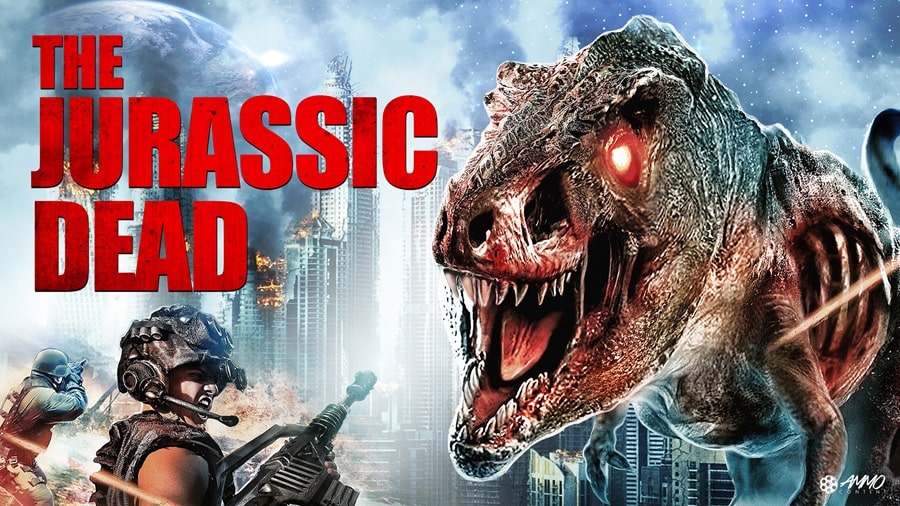 The Jurassic Dead (Wild Eye Releasing, 2017)
The Jurassic Dead (Wild Eye Releasing, 2017)
We’re off on another adventure filled to the brim with disappointment. 20 films I’ve never seen before, all free to stream, all dinosaur-based.
Oh God.
The Jurassic Dead (2017) TubiJust how bad is the CG? Rubbish.
Sexy scientist? Nope.
Mumbo jumbo? Reanimation, dinosaurs, zombies, asteroids.
Just in case you thought I might try to start the year on a high note, might I present this tripe. The premise is simple: a Herbert West type (complete with glowing green reanimating fluid and dead cat) loses his job and decides to destroy the world. Somehow he has a T-Rex, which he zombifies, and then he turns into Immortan Joe and sets off an EMP just as asteroids wipe out some cities. A crack, sorry crap, team of commandos based on 80s action figures must team up with a group of hugely unlikeable civilians to survive.
Everything ends in nuclear devastation. Effects-wise, the dinosaur is a cute, Walking with Dinosaurs puppet, but everything else is shockingly awful green screen composites. Just terrible.
3/10
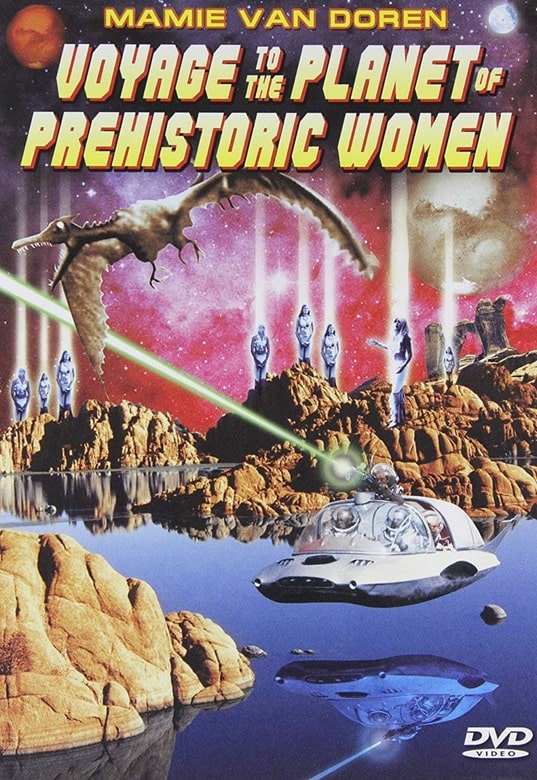

Voyage to the Planet of Prehistoric Women (AIP-TV, 1968), and Monsters of War (Jagged Edge Productions, 2021)
Just how bad is the CG? There is none.
Sexy scientist? Nope.
Mumbo jumbo? Venus, dinosaurs, telepathy
There’s a Russian sci-fi movie called Planeta Bur that got cannibalized twice by AIP under the eye of Roger Corman. One version was Voyage to the Prehistoric Planet, which I have seen, and the other is this one, identical except for 10 minutes of footage of blond ladies telepathically moaning about their dead pterodactyl.
This was made by Peter Bogdanovich and, a day after his death, I’ll let him explain:
Planeta Bur was a Russian science-fiction film that Roger had called Storm Clouds of Venus that he had dubbed into English. And he came to me and said, “Would you shoot some footage with some women? AIP won’t buy it unless we stick some women in it.” So I figured out a way to work some women in it and shot for five days, and we cut it in. I narrated it, because nobody could make heads or tails of it. Roger wouldn’t let me add any sound. It was just a little cheap thing we did, and people think I directed it when I really only directed 10 minutes of it.
It’s barking mad, best watched stoned, and strangely charming.
I was actually watching Voyage to the Planet of Prehistoric Women as part of the Prehistrionics project when I heard Peter Bogdanovich died. So sad.
5/10
Monsters of War (2021) TubiJust how bad is the CG? Rubbish.
Sexy scientist? Nope.
Mumbo jumbo? Monster pick n’ mix.
In a first for me, I recognized a cave in the opening shot, then a bunch of trees. Then most of the cast. Then a big house. Oh my God, the folks who made Dinosaur Hotel (covered in Part I) had apparently booked the location for two weeks, because they made a second movie there.
Chrissie Wunna is once again the anguished mother of two terrible child actors, and she once again has to survive in a big house surrounded by rando monsters (including T-Rexes, Kong-lite and other B.S.), and must try to get along with rando fodder (including a miserable nun and some of the ladies that got eaten in the last film).
I actually like Chrissie Wunna, she does anguished mum quite well, but it’s not enough to save this dull exercise in bad effects mixed with ill-considered decisions.
3/10

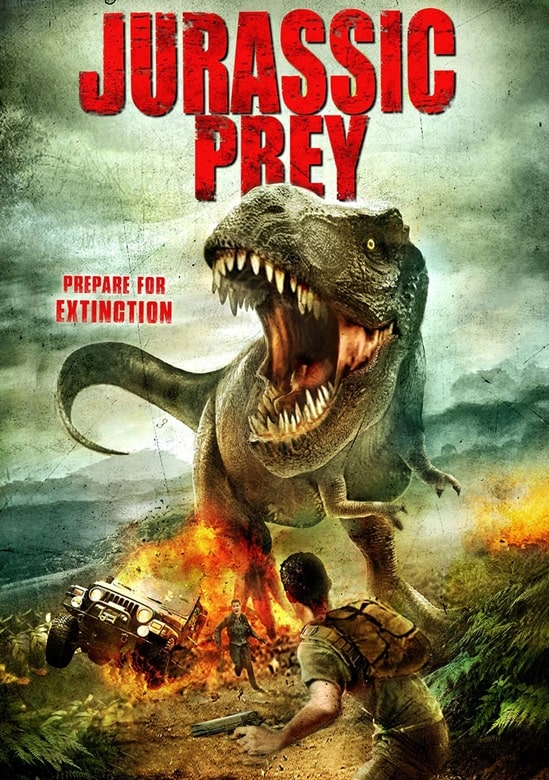
The Dinosaur Project (StudioCanal, 2012), and Jurassic Prey (Polonia Brothers Entertainment, 2015)
Just how bad is the CG? Passable.
Sexy scientist? Almost.
Mumbo jumbo? Hidden African dinosaur valley.
The film began with a shock as the StudioCanal logo popped up — what? You mean this might be half decent?
Almost. Coming off as a Lost World-lite, this had the makings of a decent yarn as a bunch of Brits descend into the African bush in search of Mokele-mbembe, the Congo’s own Nessie. A pterodactyl-tinged helicopter crash dumps them in the Dino-dollops, and the rest of the film is the team trying to survive/being killed one-by-one, all in fantastically annoying ’found footage’ fashion. It’s not terribly exciting, but it’s refreshing to get some real actors and the CG isn’t cringeworthy.
Mostly harmless.
6/10
Jurassic Prey (2015) TubiJust how bad is the CG? The only CG is blood, and it’s rubbish.
Sexy scientist? Nope.
Mumbo jumbo? Mining explosion wakes up a thick T-Rex.
There’s only one phrase worse than ‘A Polonia Brothers Film’, and that’s ’anal seepage’, but I’d take the latter over the former any day of the week.
Everything about this film — the plot, the direction, the editing, the acting, the music, the effects — is hot garbage. The only things I enjoyed were the cankles on the ludicrous dinosaur puppet.
Avoid.
1/10
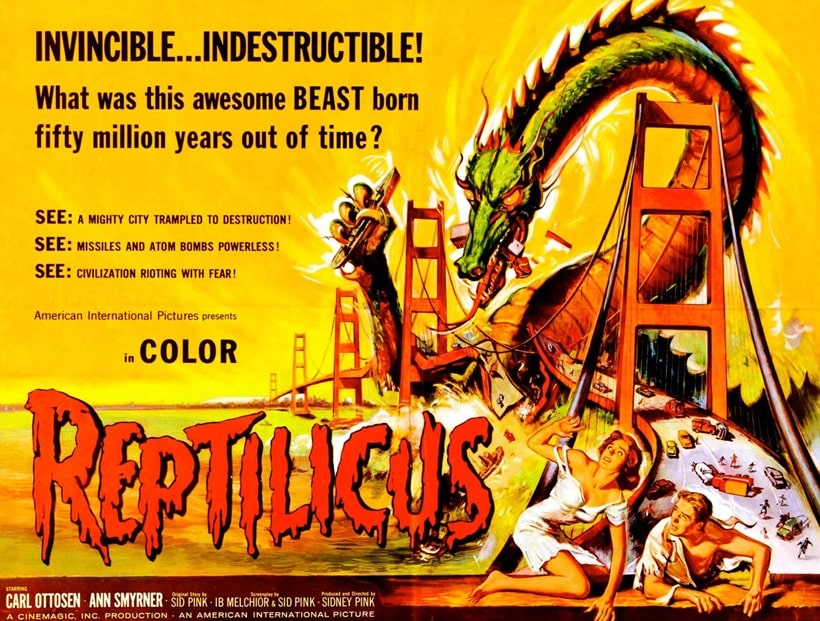 Reptilicus (American International Pictures, 1961)
Reptilicus (1957 or 1961) Tubi
Reptilicus (American International Pictures, 1961)
Reptilicus (1957 or 1961) Tubi
Just how bad is the CG? No CG, but some laughable compositing in the US version.
Sexy scientist? Yep.
Mumbo jumbo? Copper mining digs up a regenerating monster.
And so we reach the end of this miserable excursion with an old one that somehow managed to slip by me, Reptilicus, the first and last Danish/US co-op monster movie. There are two versions, and I would love to find the Danish one, because the AIP US production is pretty awful. They shot the film twice, once in Danish and once in English, but smothered the latter in V.O., and it sounds like the dubbing was done by actors whacked out on cough syrup.
Reptilicus itself is less dinosaur, more Chinese dragon puppet, and it rampages around Denmark laying waste to some nice miniatures of tourist attractions. We know what they are because a couple of characters go on an extended sightseeing trip. All the familiar tropes are in place, including Dr. Frosty McDemiwave, and I enjoyed myself. It’s rubbish, but it’s nostalgic rubbish, and that makes it great.
6/10
Previous Murkey Movie surveys from Neil Baker include:
Prehistrionics, Part I
Prehistrionics, Part II
Jumping the Shark
Alien Overlords
Biggus Footus
I Like Big Bugs and I Cannot Lie
The Weird, Weird West
Warrior Women Watch-a-thon
Neil Baker’s last article for us was Prehistrionics, Part II. Neil spends his days watching dodgy movies, most of them terrible, in the hope that you might be inspired to watch them too. He is often asked why he doesn’t watch ‘proper’ films, and he honestly doesn’t have a good answer. He is an author, illustrator, outdoor educator and owner of April Moon Books (AprilMoonBooks.com).
RIP Howard Andrew Jones
 John O’Neill and Howard Andrew Jones at the World Science Fiction Convention, Washington DC, December 19, 2021
John O’Neill and Howard Andrew Jones at the World Science Fiction Convention, Washington DC, December 19, 2021
Howard Andrew Jones is dead.
It’s hard to write those words. Howard has been a huge part of my personal and professional life since 2002, when I opened a submission to Black Gate magazine and found a long, rambling, and extremely enthusiastic cover letter from him, expressing his delight at finding a quality magazine devoted to heroic fantasy. The letter ended with “I want in, bad,” and was attached to a terrific tale featuring two adventurers named Dabir and Asim.
We eventually published three Dabir and Asim tales in Black Gate, and within a few years Howard’s editorial contributions had become so essential to the magazine that we named him our first Managing Editor. He ran our non-fiction department, single-handedly recruiting and managing over a dozen contributors to fill some 80 pages every issue with thoughtful essays, book reviews, gaming coverage, and much more.
 The Ring-Sworn Trilogy by Howard Andrew Jones (St. Martin’s Press, 2018-2021). Covers by Lauren Saint-Onge
The Ring-Sworn Trilogy by Howard Andrew Jones (St. Martin’s Press, 2018-2021). Covers by Lauren Saint-Onge
In November 2008 Howard told me he wanted to remake our website, and post new articles every single day, instead of a few times a month. I told him he was crazy. How in the world could we produce that much content, especially without a budget?
Undaunted, Howard put together a top-notch team of writers, and committed to putting daily content on the Black Gate blog. It was his vision, and he executed it magnificently, with a little help from Bill Ward, David Soyka, Scott Oden, James Enge, EE Knight, Ryan Harvey, and others. Eight years later, the website won a World Fantasy Award — an honor that I still believe should have been presented to Howard.
Before long Howard’s own writing career had taken off with such magnitude that he had to step back from day-to-day duties at the magazine. Over the next fifteen years he released fifteen books, including three featuring Dabir and Asim, four novels in the Pathfinder universe, the Ring-Sworn Trilogy, three volumes in The Chronicles of Hanuvar, and the Harold Lamb collections Swords from the East and Swords from the West.
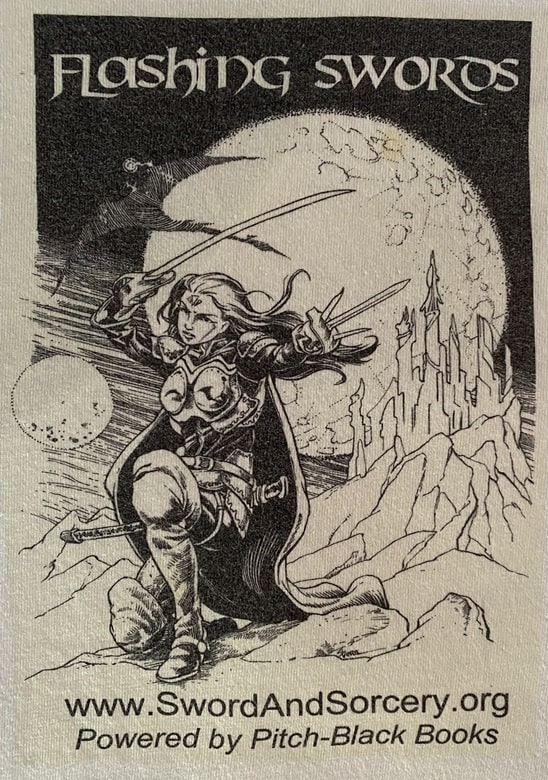 The Flashing Sword sZine, edited by Howard Andrew Jones (2006-2007)
The Flashing Sword sZine, edited by Howard Andrew Jones (2006-2007)
Howard was a wonderful writer. He believed in heroes, and that steadfast conviction informed all of his writing. But despite all his success Howard never lost touch with his other major talent — finding and nurturing new writers. Howard was an enormously gifted editor, and a tireless champion of underappreciated writers. It was a gift that led to his first editing gig in 2005, running Flashing Swords ezine for Daniel Blackston at Pitch-Black Books, an underfunded online magazine that produced six excellent issues in 2005 and 2006.
Howard’s accelerating career brought him countless additional opportunities, but the ones he seized were usually the ones that gave him the chance to find and publish new talent. Joseph Goodman brought Howard onboard to launch Tales From the Magician’s Skull at Goodman Games in 2017, and with Howard at the helm the magazine quickly became the premiere outlet for modern sword & sorcery and heroic fantasy. Howard got the band back together for the Skull, recruiting much of the same talent he’d called upon at Black Gate — including Bill Ward, John C. Hocking, James Enge, Chris Willrich, Mark Rigney, and many others.
 Tales From the Magician’s Skull #11, edited by Howard Andrew Jones (Goodman Games, October 1, 2022). Cover by Sanjulian
Tales From the Magician’s Skull #11, edited by Howard Andrew Jones (Goodman Games, October 1, 2022). Cover by Sanjulian
Back in 2011 Howard sent me the draft of a new story he was working on. It featured a new hero, the last general of a defeated people. His name was Hanuvar, and he was consciously modeled on one of Howard’s heroes, the great Carthaginian general Hannibal, whom Howard has first encountered in a Harold Lamb novel. The story was both more sober and more ambitious than anything Howard had sent previously, and I knew instantly that I wanted to publish it in Black Gate.
Alas, I never got the chance. Black Gate magazine folded in 2011, and that was the end of my editing career. Howard found a home for his Hanuvar stories in magazines like Adrian Simmons’ Heroic Fantasy Quarterly, and Tales from the Magician’s Skull, and fine anthologies like Jason Waltz’s Neither Beg Nor Yield. Eventually they were collected in 2023 in Lord of a Shattered Land, a volume that relaunched Howard’s career and put him in front of countless new fantasy fans.
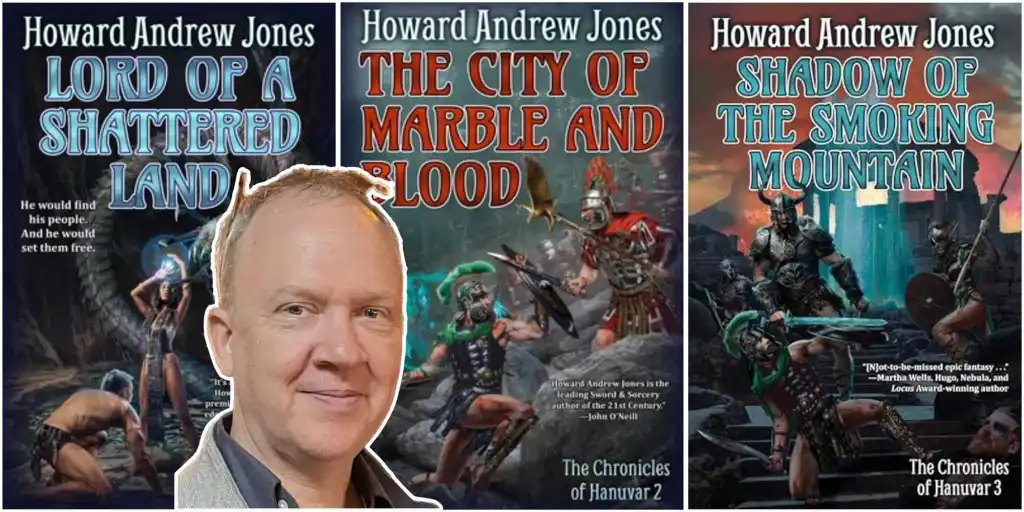 The Chronicles of Hanuvar by Howard Andrew Jones (Baen Books, 2023-2024). Covers by Dave Seeley
The Chronicles of Hanuvar by Howard Andrew Jones (Baen Books, 2023-2024). Covers by Dave Seeley
Baen Books signed Howard to a five-book contract for Hanuvar, and on his way home from Gen Con this summer, Howard called to let me know that Baen had agreed to extend his contract for an additional two volumes. Howard had nearly finished book four, and had grand plans to extend the series to add in several new storylines. He was as upbeat about his writing career as I’d ever heard him, and I was overjoyed to hear it. Howard had found his audience at last, and a publisher who could help him reach it. The world was finally starting to notice just what a talented writer he was.
Just a few weeks later, Howard called to tell me that he was experiencing a strange leg pain. He blamed it on not doing morning stretches before long writing bouts on the kitchen stool. The ailments spread over the next month, and in late September Howard was diagnosed with glioblastoma. Terminal brain cancer. He passed away at home in Evanston, Indiana, at 12:15 am yesterday night.
It’s hard for me to understand that I won’t talk to Howard again. That I won’t get eight-minute phone calls from him as he’s dashing to pick up groceries. That we won’t talk about writing and pulp fiction and Star Trek for long hours. That he won’t be at the center of our raucous annual dinner gatherings at Windy City Pulp & Paper. That I won’t sit on the porch and gossip about whose book series just got canceled, who’s making waves in the industry, who’s the best fantasy writer not named Howard Andrew Jones.
I loved him. And now he’s gone. I don’t understand. The world isn’t fair, but I know exactly what Howard would tell me. Keep writing. And don’t let it get you down.
Here’s to you, Howard. You were the best of us, and you’ve been taken away. You fought tirelessly to make sure the world didn’t cruelly forget the writers you respected, like Harold Lamb, Leigh Brackett, and Roger Zelazny. Now it’s time to lay down your pen, douse the lamps in your wind-swept tower, and let others take up the fight.
Rest well, my friend. You’ve earned it.
Goth Chick News: Hitting the Show Circuit Hard in 2025
 This is why BLACK GATE gives out press passes
This is why BLACK GATE gives out press passes
And so this happened last week…
John O (the big cheese): People probably imagined you lot (Photog Chris Z and I presumably) are just hunkered down there in the subterranean offices of Black Gate sequestered with a blender, several bottles of adult beverages and the Roku horror channels.
Me: So…?
John O: So – that’s not the image we want to portray here at Black Gate.
Me: We have an image?
John O: OF COURSE WE HAVE AN IMAGE! Why can’t you be more like Bob Byrne?
Me: Bob? Oh… you mean Sherlock. Right. Wait, what was that first thing again?
John O: [insert unpublishable adult language] Would you please just go be visible somewhere? Be a reporter – get out in the field and report. That’s what Bob does. He reports… on detectives… for Black Gate.
Me: The ice machine is broken again.
John O: ARG! [insert more adult language and stomping up the stairs]
What John O doesn’t know but what — and I’m just guessing here — he wants to know, is the following.
About the time “the season” has officially concluded for Goth Chick News (and the season runs from March through November), we have a short holiday break before plunging headfirst into a new annual show circuit: hell bent on bringing you the warmest, moistest, gooiest news from the underside of pop culture.
This year the 2025 circuit kicks off with the Halloween & Attractions Show, followed by Days of the Dead’s first trip through Chicago. From that point forward it’s all go here at Goth Chick News, with a couple of new events thrown in this year.
The Halloween & Attractions Show: Feb 27-Mar 2 (Industry only)
Days of the Dead Convention Chicago: Mar 28-30
Chicago Comic and Entertainment Expo (C2E2): April 11-13
Nightmare Weekend: May 2-4
The Midwest Haunter’s Convention: June 6- 8
American Hauntings Conference: June 26-29
Fan Expo: Aug 15-17
Days of the Dead Convention Chicago: November TBD
So photog Chris Z and I do get out of the office. Okay, it is mostly at night and mostly with people carrying around body parts and stuff, but that shouldn’t matter.
We can’t all be Bob.
The Masters of Narrative Drive
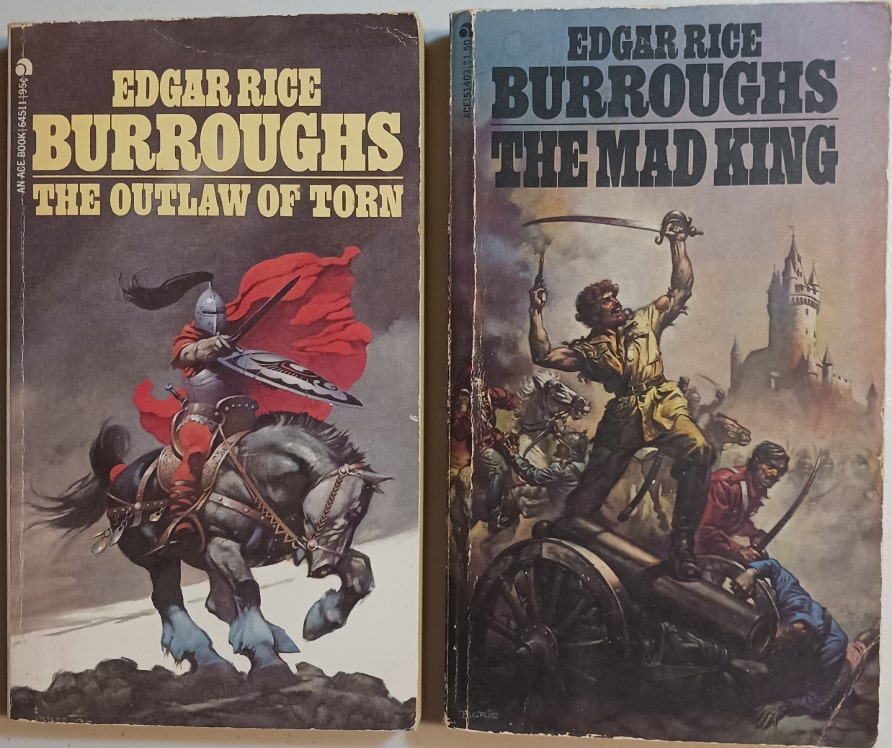 The Outlaw of Torn and The Mad King by Edgar Rice Burroughs (Ace Books, January 1973 and February 1979). Covers by Frank Frazetta and Boris Vallejo
The Outlaw of Torn and The Mad King by Edgar Rice Burroughs (Ace Books, January 1973 and February 1979). Covers by Frank Frazetta and Boris Vallejo
An author friend of 70+ books told me that a novel is just “one damned thing after another.” This is a layman’s way of saying that a book needs “narrative drive.” Narrative drive keeps readers turning the pages. It exerts a pull that drags the reader along. Edgar Rice Burroughs was the master of narrative drive. Things are happening on every page of his books that keep you wanting to know more.
There are two primary kinds of “wanting to know more.” One is, more information about the story’s plot. This is based on intellectual curiosity, and mystery stories illustrate this most clearly. Who committed the murder? Why? How? Etc. This is the primary type of drive that good nonfiction has.
The second kind of “wanting to know more” is based on emotion and character. What is going to happen to a particular character or characters the reader is attached to? The strongest narrative drive combines these.
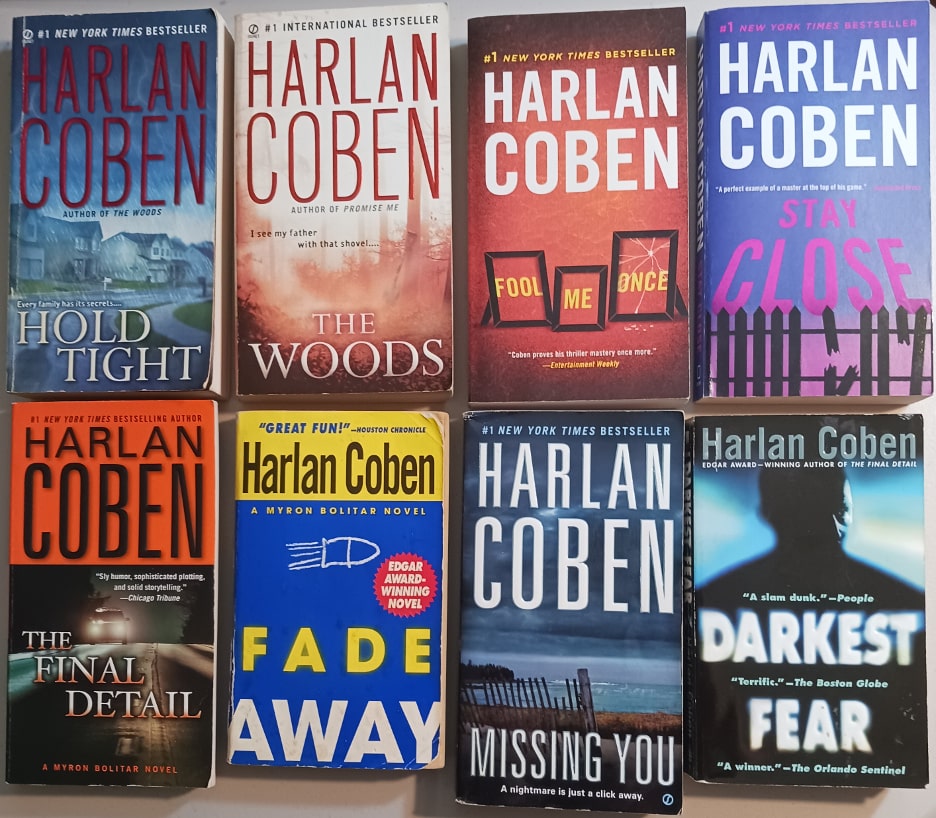 The Novels of Harlan Coben, a master of Narrative Drive
The Novels of Harlan Coben, a master of Narrative Drive
A modern author who captures both qualities — in my opinion — is Harlan Coben. Coben sets up a mystery early. Say, a character’s young brother or sister disappeared many years ago and is believed dead. But now something happens that suggests they may still be alive. This engages intellectual curiosity? How could that be? What happened to them? Where have they been?
As the story goes on, however, Coben works to get you to care about the main characters, to feel their pain. And now you want the mystery to be solved for their sake too.
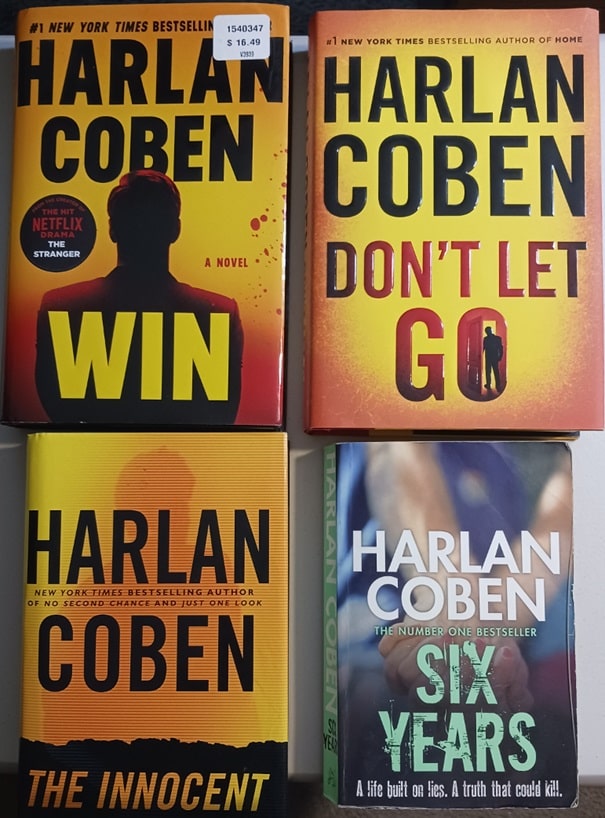 More books by Harlan Coben
More books by Harlan Coben
Such authors as Edgar Rice Burroughs and Robert E. Howard were generally able to create both types of narrative drive in their stories as well. As a young man reading about John Carter or Conan, I identified with these characters. I pictured myself in their shoes so whatever happened to them evoked emotions — fear, anger, desire, joy, melancholy. I wanted them to be successful in the story because I wanted to be successful myself.
At the same time, when these characters discovered a lost city, I wanted to know who’d built it? And why? Were any of them still around? What kind of dangers lurked in the ruins?
At age sixty-five, I find it less easy to identify with characters like Carter and Conan. They’re so different from me. I’m no sword slinging hero. Often, these days, I find myself very interested in the supporting characters, like “Sola,” the female green Martian from A Princess of Mars, or “Woola,” who becomes John Carter’s loyal animal companion.
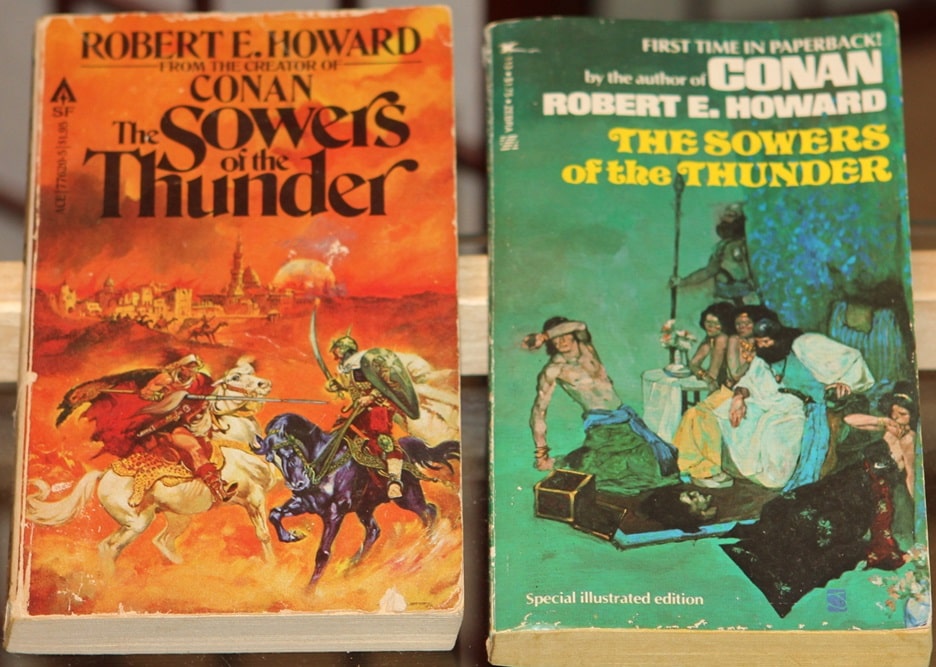 Two editions of The Sowers of the Thunder by Robert E. Howard (Ace Books, July 1979 and Zebra Books, March 1975). Covers by Esteban Maroto and Jeff Jones
Two editions of The Sowers of the Thunder by Robert E. Howard (Ace Books, July 1979 and Zebra Books, March 1975). Covers by Esteban Maroto and Jeff Jones
But I’ve never lost my intellectual curiosity about lost cities and lost worlds. Maybe I’m grown up, but there’s still a lot of “boy” in me, and good Sword & Planet fiction sure entertains that boy.
Above are some books filled with narrative drive, a few of the many Harlan Coben books I’ve read, Outlaw of Torn and The Mad King by ERB, with covers by Frazetta and Boris respectively, and my favorite REH collection, The Sowers of the Thunder, a collection of his crusader stories. Both are full of Roy Krenkel illustrations but the green cover is by Jeff Jones and the orange cover by Esteban Moroto.
Charles Gramlich administers The Swords & Planet League group on Facebook, where this post first appeared. His last article for Black Gate was a look at William R. Forstchen’s The Lost Regiment.
The Dreams in Gary’s Basement: Gary Gygax and the Creation of Dungeons & Dragons
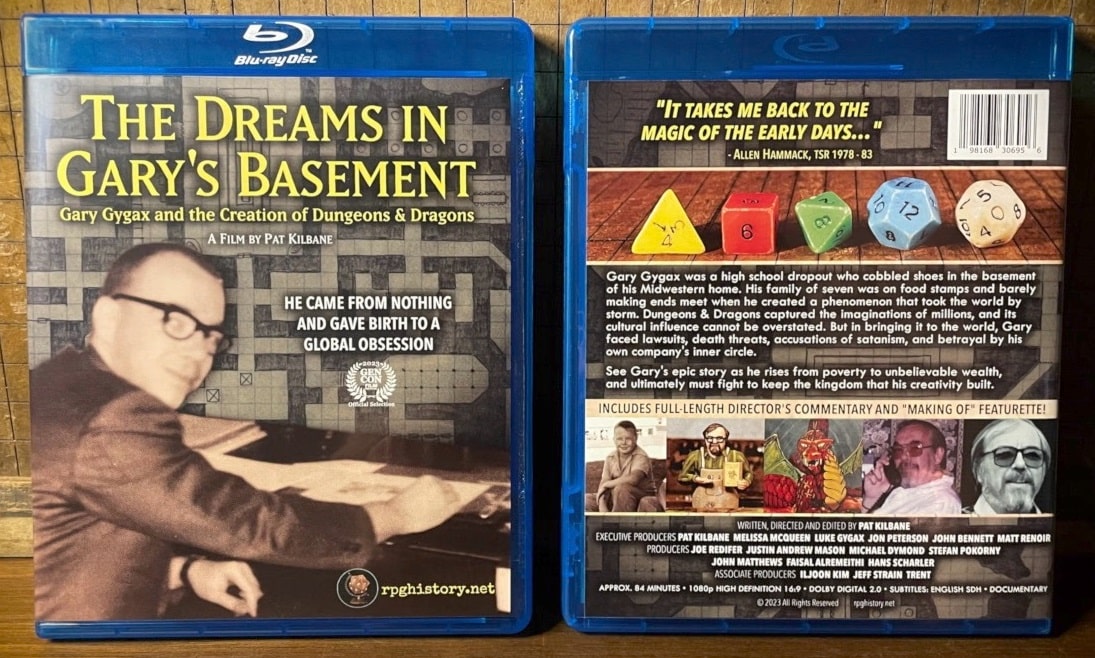 The Dreams in Gary’s Basement, Blu Ray version (rpghistory.net, 2023)
The Dreams in Gary’s Basement, Blu Ray version (rpghistory.net, 2023)
On the eve of Gary’s Gygax’s birthday, July 26, 2019, I was in sunny California getting ready to be interviewed by the Dorks of Yore for their documentary, The Dreams in Gary’s Basement: Gary Gygax and the Creation of Dungeons & Dragons.
The interview touched on my experiences working with Gary from 2005–2008, a time that I will always cherish. Gary was so generous with me — a friend and a mentor who not only showed me the ropes, but also put trust in me. It was such an honor and a privilege to get to work with one of my childhood idols.
 Getting ready for the interview
Getting ready for the interview
Here I am a few years ago at the filming. The interview was conducted by Pat Kilbane and his crew, who reorganized my room at the Marriott just outside of Hollywood. Stephen Chenault of Troll Lord Games was scheduled to be interviewed before me. It was a lot of fun!
It was an incredible honor to be included in this discussion on the history of Dungeons & Dragons, and Gary Gygax’s role in vaulting his co-creation to the stratosphere. My joy is evident in this photo. I had the privilege to work as Gary’s co-author in his final years (2005 – 2008), and I was so happy to share my appreciation of his genius.
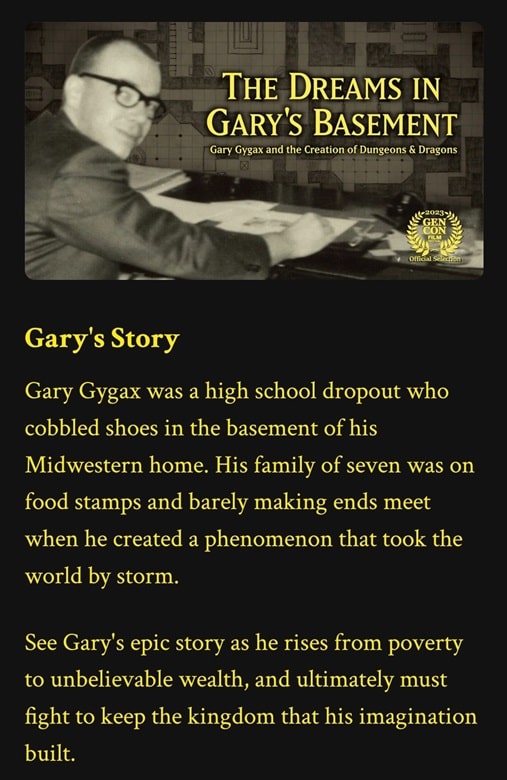 The Dreams in Gary’s Basement
The Dreams in Gary’s Basement
The Dreams in Gary’s Basement is very well done, and if you are a fan of D&D, including the history of its creation and meteoric rise to popularity and fame, then I urge you to check it out at rpghistory.net.
Gary, as many of you know, was the co-creator of Dungeons & Dragons, a game that has enjoyed 50 years of success. Gary taught me a lot, even when he wasn’t actively teaching or instructing me on the development of Castle Zagyg (or Castle Greyhawk, to those who know). I recently relayed the story of Gen Con in 2007, when Gary was signing autographs at the Troll Lord Games booth.
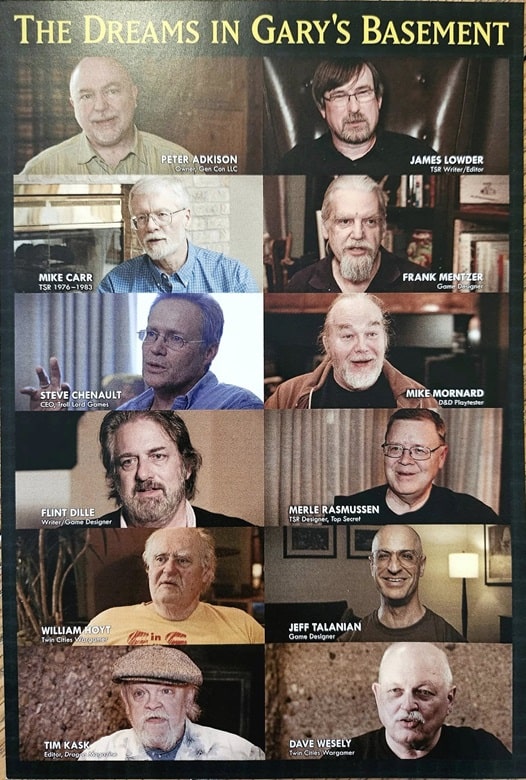
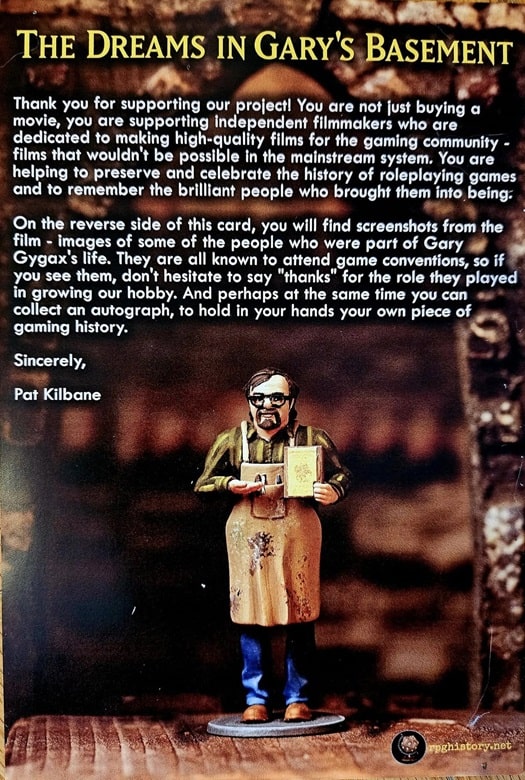
Bonus card included with the Kickstarter version
The line snaked through the halls, filled with fans who wanted to have something signed, or to shake his hand, take a photo, or to tell him how much his creations meant to them or changed their lives. It was inspiring for me to see how he handled his enthusiastic fandom. He listened to and spoke with every one of them. He treated them like fellow gamers, like peers, and he was humble and thankful for their kind words.
It was really nice to see. Gary was more than just a genius creator of games. He was a good guy.
Cheers, Gary!
Jeffrey P. Talanian’s last article for Black Gate was Hal Clement Helped Launch My Writing Career. He is the creator and publisher of the Hyperborea sword-and-sorcery and weird science-fantasy RPG from North Wind Adventures. He was the co-author, with E. Gary Gygax, of the Castle Zagyg releases, including several Yggsburgh city supplements, Castle Zagyg: The East Mark Gazetteer, and Castle Zagyg: The Upper Works. Read Gabe Gybing’s interview with Jeffrey here, and follow his latest projects on Facebook and at www.hyperborea.tv.
A Locked Tomb Mystery in Space: Gideon the Ninth by Tamsyn Muir
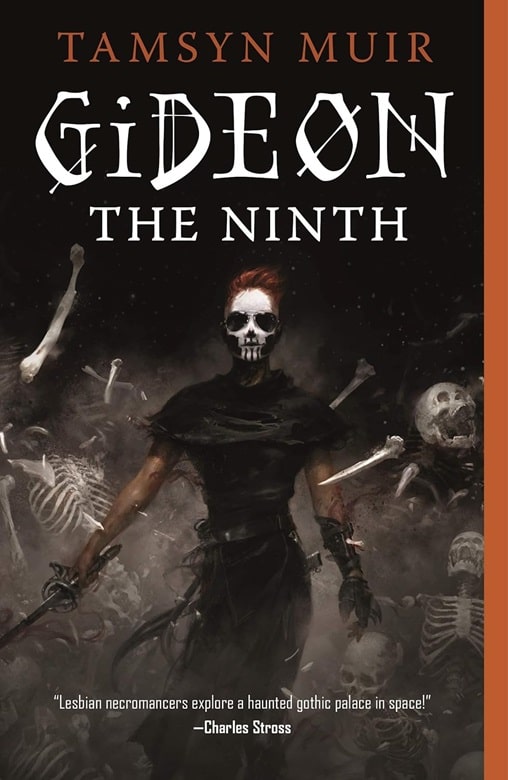
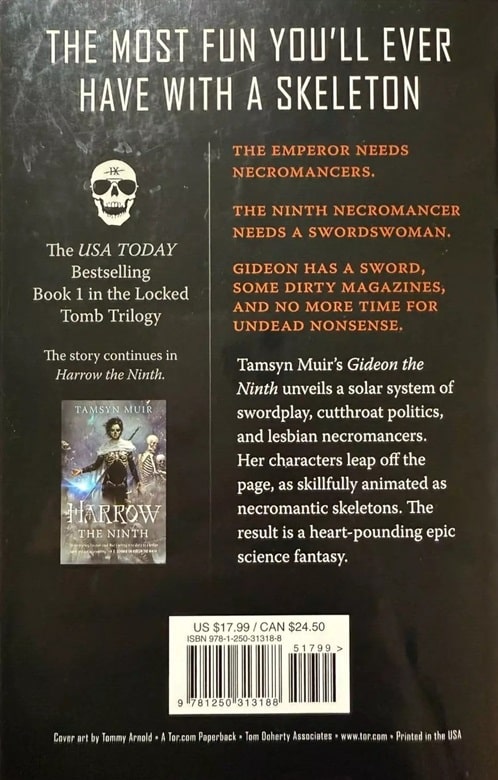
Gideon the Ninth (Tor Books, September 10, 2019). Cover by Tommy Arnold
The back cover of the hardcover edition of Gideon the Ninth features this assessment from writer Warren Ellis: “The author is clearly insane.”
Three things made me shunt Gideon the Ninth to the front of my TBR stack. First, both my older son and his girlfriend read it, and, once finished, they promptly named their cat Harrow after one of the two main characters. Second, the cover art jumped out like an All Hallows spotlight. Third, that Ellis quote grabbed me by the frontal lobes. A novel featuring skeletons and sword-wielding necromancers written by a writer five cans short of a six-pack? Sign me up, buttercup.
Finally, in the interests of truth-telling or perhaps over-sharing, I must add that a fourth element convinced me to delve into Gideon the Ninth, and that was when I spotted a copy on the shelves at Chaucer’s Books in California, and cracked the cover to explore the opening paragraph. It reads as follows:
In the myriadic year of our Lord –– the ten thousandth year of the King Undying, the kindly Prince of Death! –– Gideon Nav packed her sword, her shoes, and her dirty magazines, and she escaped from the House of the Ninth.
I was hooked. There’s nothing like a practical protagonist. Sword and shoes, check. Dirty magazines? Clearly a must. Next stop, adventure!
Gideon’s author, Tamsyn Muir, hails from New Zealand, land of the flightless kiwi, and perhaps her nation’s geographic (indeed, geologic) isolation is what prompted her to cast the requisite bones to write this dark but often hilarious tale. (The dialogue, in particular, is a hoot.)
Without going into a dull, useless, and surely uninspiring plot summary, let’s just say that Muir begins on a haunted planet where necromancy is the norm, and where just about nobody alive seems to live –– except for Gideon, who is training to be the galaxy’s best sword-arm, and her much-hated nemesis, Harrowhark Nonagesimus.
Harrow, after all, commits daily sacrilege by referring to proud Gideon as Griddle.
Griddle’s –– sorry, Gideon’s –– daily goal: to get off-planet. Anyplace elsewhere will do. Harrowhark’s goal: to foil Gideon, because –– well, Harrow knows what Gideon does not, that in the very near future, the Nine Houses will convene for a lethal tournament, and Harrow will need Gideon to become her right-hand girl, her one and only cavalier, in order to…
Dag-nabbit, I said I wouldn’t do a plot summary, and look what just happened. Plot! Summarized.
At rock bottom, the hook is that Gideon and Harrow are going to have to work together, because if they don’t, the really nasty side of all things necromantic will seize control of the Emperor’s depleted band of revenant Lyctors, and Lyctors are –– no, sorry, you’ll have to figure that out for yourself.
This could be disastrously simplistic in another writer’s hands. Long-time rivals, forced to work together? Yawn.
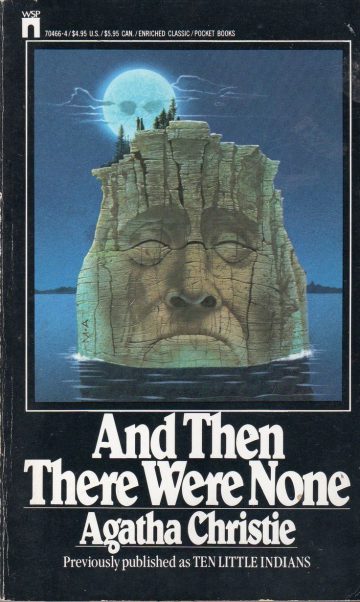 And Then There Were None by Agatha Christie (WSP/Pocket Books, 1979)
And Then There Were None by Agatha Christie (WSP/Pocket Books, 1979)
But Muir has read her Dame Agatha, a la And Then There Were None, and she takes flight from there, bending the tropes of the “locked room mystery” into a “locked tomb mystery.” Sounds cheesy? It isn’t. Muir leavens the super-sharp, bite-me dialogue with creepy grossness straight out of Clive Barker. The action sequences are top-notch, with swords and magic and tricks and traps and self-sacrifice of the highest order. The climactic battle rages for no less than thirty-five pages, and it never flags, not once.
Speaking as a writer, that’s a particularly impressive high-wire act. Action sequences force their authors to forgo most of the tricks in the creative writing toolbox. Asides have to be strictly limited; musings and recollections even more so. Metaphors must be kept to a tidy minimum. Basically, combat scenes are a tight, focused series of “And then, and then, and then, and then!” No letting up allowed, and the ultra-efficient description required has to be vivid, dead-accurate, and electrifying. A great many very well-known authors can’t keep this particular kind of balloon aloft for long, but Muir can, and does. It’s frankly thrilling.
For those ready to frown on yet another book featuring necromancy, never fear. Muir trades in specifics. Each of the Nine Houses has its own specialty. Harrowhark’s particular focus is bones, such that skeletal material is, for her, plastic, expandable, shrinkable. At her will, bones animate. Her Sixth House rival, Sextus (who claims to be the greatest necromancer of his generation) brings a skill set more akin to a D&D cleric, allowing him to impact flesh, living, dead, and in between. The Eighth House channels (and sometimes siphons) departed souls. And so on.
The tournament commences. Each house couplet, necromancer and attendant cavalier, sets out to discover the path to becoming a Lyctor. Their hosts claim not to know the answer. We the readers certainly don’t know the answer. But Muir does. Even when the book leaves a few dangling questions at story’s end, I never had the sense that I was in the hands of, say, the makers of Lost, where in fact nobody knew what was going on.


The second and third books in The Locked Tomb series: Harrow the Ninth and Nona the Ninth
(Tor Books, August 4, 2020 and September 13, 2022). Covers by Tommy Arnold
By choice, I treated Gideon the Ninth as a highly enjoyable one-off, but in fact it’s a quartet, with Harrow the Ninth following next, then Nona the Ninth, to be rounded off by Alecto the Ninth (coming, we are told, soon). The evidence so far suggests that Muir has her universe knitted together and under control, and the fact that she’s still exploring it is a bonus round, not a charlatan’s dodge.
Meanwhile, I suppose it’s only mete and proper to address the front-cover quote, from Charles Stross:
Lesbian necromancers explore a haunted gothic palace in space!
This is all factual enough, but a tad gratuitous, since Gideon never pursues either long-term romance or specific sex scenes. True, Gideon’s particular predilections influence how she interacts with a handful of her fellow tournament contestants, but mostly, her preferences matter about as much as her shoe size. Honestly, this is a relief. How pleasant to discover a book where sexuality, of whatever type, is just one part of the larger whole, and not something to be exploited for the sake of titillation, bodice-ripping or otherwise.
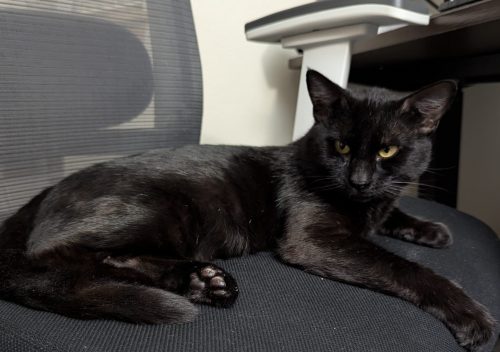 Harrow the Cat
Harrow the Cat
I expect I’ll catch up with Harrow (the book, not the cat) later in the year. Although come to think of it, perhaps I’ll visit my son, too, in which case, I’ll have the opportunity to read Harrow the Ninth with Harrow the Cat purring on my lap.
Now that’s a sequel worth anticipating.
Onward.
Mark Rigney is a writer and long-time Black Gate blogger. His work on this site includes original fiction and perennially popular posts like “Adventures in Spellcraft: Rope Trick.” His new novel, Vinyl Wonderland, dropped on June 25th, 2024. Reviewer Rich Horton said of Vinyl Wonderland, “I was brought to tears, tears I trusted. A lovely work.” His favorite review quote so far comes from Instagram: “Holy crap on a cracker, it’s so good.” A preview post can be found HERE, while his website lives over THERE.
The Public Life of Sherlock Holmes: Poirot on the Radio
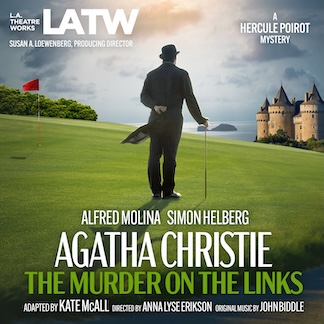 I enjoy radio plays, and frequently listen to them on my phone while I drive, work, or drift off to sleep. I only recently noticed Audible’s sleep timer feature, which is certainly useful for the latter.
I enjoy radio plays, and frequently listen to them on my phone while I drive, work, or drift off to sleep. I only recently noticed Audible’s sleep timer feature, which is certainly useful for the latter.
This includes The New Adventures of Mike Hammer, Nero Wolfe (on the CBC), Terry Pratchett’s Discworld, Clive Merrison and John Stanley as Sherlock Holmes, Dirk Gently’s Holistic Detective Agency, The Caine Mutiny Court Martial, Mistletoe Murders: And Hercule Poirot.
I enjoy audiobooks and listen to them all year long. They let me get to books I wouldn’t have time to sit down and read. And lets me re-visit favorites, easily.
But I quite like listening to a radio play. I’m fortunate that there are a couple dozen good Poirot ones. And John Moffatt’s are in my rotation all year long.
Of course, I wrote about David Suchet’s masterful performance on British TV. It was Suchet’s Poirot, and Maury Chaykin’s Nero Wolfe, which led me to read the stories they were based on. I cannot possibly imagine a better Poirot, ever.
I have gone in-depth on radio Poriot, here and here: I’ll talk about them below. But first, a bit of a surprisingly good radio Poirot.
Murder on the Links – Alfred MolinaI think Molina is most recognizable among the younger crowd (which I am NOT a part of), as Doc Ock in the Spider Man movies. He recently played Inspector Gamache in Three Pines – a very good Canadian miniseries which ABSOLUTELY deserved a second season.
There are eighteen novels by Louise Penny, and I’m still bummed it was canned after only one eight-episode story arc. It quite liked it. After watching it, I would really like to see Molina take a shot at Georges Simenon’s Inspector Maigret. I think Molina would do well in the part. I wrote about Rowan Atkinson’s (yeah, that guy!) solid Maigret, here.
Molina starred in a contemporary made-for-television version of Murder on the Orient Express, set in 2001. It’s not very well thought of. I don’t think the attempt to set it in current day worked at all. But a few decades later, Molina would get another shot at Poirot.
LA Theater Works produces wonderful radio plays, featuring some well-known, excellent actors. I have their 2008 version The Caine Mutiny Court Martial and listen to it multiple times a year (I mention the play in my post about one of Bogie’s best movies).
In 2021 they produced a version of Christie’s novel, The Murder on the Links. Surprisingly to me, Molina was cast as Poirot. The Big Bang Theory’s Howard Wolowitz (Simon Helberg) is Captain Hastings.
In this novel, Poriot is summoned to France, and arrives to find his prospective client, murdered. The body was found on an unfinished golf course – thus, the title. This isn’t particularly one of my favorite Poirot stories. I do like the relationship between Suchet’s Poirot and snooty French Inspector Giraud. The TV show escalated what’s in the book, but it improved the story for me.
I think Molina is good as Poirot. I like John Moffatt better (though that is a VERY high bar). And I do think he could well be a better Maigret. But if you’ve only seen his Orient Express movie, I think you’ll have a higher opinion of him if you listen to this radio play. I like him.
I did not recognize Helberg, with his diction and British accent. Once I knew it was him, and I focused, I could hear it. But it’s not obvious. To me, at least.
Production values for LA Theater Works are top flight. They have produced some excellent plays. I’m a week late with this post, as this was the free weekly broadcast, last week!
I listen to this through Audible, and I like it. Give it a try.
ORSON WELLES
Yeah, that guy. You might think he’d be more suitable for Nero Wolfe than for Poirot. But Sydney Greenstreet was also gargantuan (you got that reference, if you’re a Wolfe fan) and he was a bad radio Wolfe.
Welles did a live radio drama series from 1938-1940, with one-hour adaptations of plays, novels, and movies. The Campbell Playhouse was a successor to his The Mercury Theater on the Air.
The Murder of Roger Ackroyd aired November 12, 1939, produced by, and starring, Welles (he starred in every episode). Welles played Dr. James Sheppard, as well. Since he’s the narrator, this one really is all about Orson. It also featured Alan Napier, who played Sherlock Holmes on TV, but is best known as Alfred the Butler, to Adam West’s Batman.
There is an intro with the radio announcer talking with a grumpy Poirot. Then it moves into the story. This novel is considered one of her very best, and it certainly has some surprises in it. The script was written by Herman Mankiewicz, who in just a few years would co-write Citizen Kane, with Welles.
I find Welles annoying as heck as Poriot. He definitely has a Belgian/French accent. But I don’t enjoy listening to him. Which kinda ruins the play.
I recommend that people check out stuff I like. Including the other three radio plays/series, in this post. As for Welles – it’s worth listening to for a Poirot fan. But I don’t repeat this one.
JOHN MOFFATT
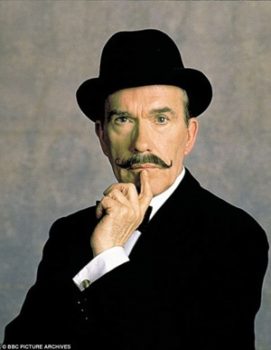 John Moffatt appeared in several episodes of Merrison’s Holmes series (the efforts of the talented Bert Coules), and had played Holmes himself in a BBC radio play. He was even Watson for twenty-four radio shows opposite Roy Marsden’s Holmes.
John Moffatt appeared in several episodes of Merrison’s Holmes series (the efforts of the talented Bert Coules), and had played Holmes himself in a BBC radio play. He was even Watson for twenty-four radio shows opposite Roy Marsden’s Holmes.
The BBC did a Poriot radio play with Maurice Denham, then one with Peter Sallis. But they struck gold when Moffatt took on the part for twenty-five of the original stories, and he is to the radio what Suchet is to the screen. He is a definitive Poirot. There a few different Hastings’; none particularly memorable. Philip Jackson, Suchet’s Inspector Japp, played the part on some of the shows, and I always like to hear him.
I prefer Hugh Fraser (Suchet’s onscreen Hastings) reading the audiobooks, to Suchet doing so. But I’d rather listen to a Moffatt radio play. All twenty-five are available, and I listen to them throughout the year. Mofatt also narrated the audiobook to Black Coffee, a novelization, based on a Poirot play written by Agatha Christie.
Peter Moffatt and Clive Merrison have brought us definitive radio versions of two great detectives. Would that someone would do the same for Nero Wolfe. The Mayer Moore Canadian series wasn’t bad, but not in this league. And Sidney Greenstreet? Not even remotely.
HAROLD HUBER
Huber, an American actor and entertainment entrepreneur, obtained the rights to Poirot for an American radio show. Agatha Christie’s Poirot debuted on February 2, 1945, featuring a live introduction from Christie, across the sea. Except, after about thirty seconds of silence, the announcer for the Mutual Broadcasting System explained that atmospheric conditions prevented the connection.
MBS did have the foresight to record a short-wave transmission from Christie earlier that day, and played that in place of her live appearance. Having Christie explain that Poirot was busy, so she would introduce the series, was a pretty neat move in those times LONG before cell phones and podcasts.
In the premiere, The Careless Victim, Poirot is looking for an apartment. An apartment in New York City, that is! Captain Hastings, Inspector Japp, Miss Lemon, and the other recurring characters in the stories didn’t make the ocean voyage, apparently. Inspector Stevens would serve as the police department’s primary character. Poirot makes the acquaintance of a Miss Abigail Thresher, at the same time he finds a body. He finds her intriguing, and she becomes his assistant at the end of the first show, filling the Hastings and Lemon roles. She’s kind of a feisty older lady, and she calls Poirot ‘chief.’
It’s not Canon, obviously. But it works. Poirot doesn’t go to Flatbush and fake a Brooklyn accent. Poirot still acts like Poirot. You don’t get Poirot at a country estate. Or walking through the mews. But I still feel like it’s Poirot while I listen to an episode. And that’s the point.
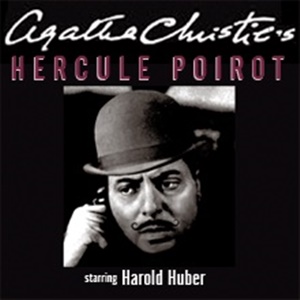 And what about Huber as Poirot? I’m a big Nero Wolfe fan. It took almost fifty years for a decent radio Wolfe. And that was a Canadian production starring Maver Moore. To this day, it’s not particularly well known. A few early attempts, including one starring Sidney Greenstreet (whose Wolfe was more Casper Gutman more than Rex Stout’s printed version), bore little resemblance to the character.
And what about Huber as Poirot? I’m a big Nero Wolfe fan. It took almost fifty years for a decent radio Wolfe. And that was a Canadian production starring Maver Moore. To this day, it’s not particularly well known. A few early attempts, including one starring Sidney Greenstreet (whose Wolfe was more Casper Gutman more than Rex Stout’s printed version), bore little resemblance to the character.
Such was not the case with Poirot. Huber’s impersonation is quite good, and I think he is much better than Albert Finney. His accent is spot on, and he conveys well the detective’s mannerisms and amusing ego. Listening to Huber is listening to Poirot, for me.
I wrote a lot more about the series, so click on over to that prior post. I find this an enjoyable listen.
TWO MORE POIROTS
In November of last year, Audible produced a new version of the first Poirot novel, The Mysterious Affair at Styles. Peter Dinklage (Game of Thrones) plays the great detective. I’ve only listened to part of it so far, thus, it didn’t make this entry. At almost four hours, it’s a pretty long radio play. But I will do a post on it.
Might try to run down Audible’s 2017 Murder on the Orient Express, with Tom Conti starring.
Prior Poirot Posts (PPP!)John Malkovich’s Poirot
Poirot’s The Hollow & Holmes
Talking About Poirot
Branagh’s Murder on the Orient Express
John Moffatt as Poirot
Harold Huber as Poirot

Bob Byrne’s ‘A (Black) Gat in the Hand’ made its Black Gate debut in 2018 and has returned every summer since.
His ‘The Public Life of Sherlock Holmes’ column ran every Monday morning at Black Gate from March, 2014 through March, 2017. And he irregularly posts on Rex Stout’s gargantuan detective in ‘Nero Wolfe’s Brownstone.’ He is a member of the Praed Street Irregulars, founded www.SolarPons.com (the only website dedicated to the ‘Sherlock Holmes of Praed Street’).
He organized Black Gate’s award-nominated ‘Discovering Robert E. Howard’ series, as well as the award-winning ‘Hither Came Conan’ series. Which is now part of THE Definitive guide to Conan. He also organized 2023’s ‘Talking Tolkien.’
He has contributed stories to The MX Book of New Sherlock Holmes Stories — Parts III, IV, V, VI, XXI, and XXXIII.
He has written introductions for Steeger Books, and appeared in several magazines, including Black Mask, Sherlock Holmes Mystery Magazine, The Strand Magazine, and Sherlock Magazine.
You Will Know—Singularity! Singularity Sky by Charles Stross
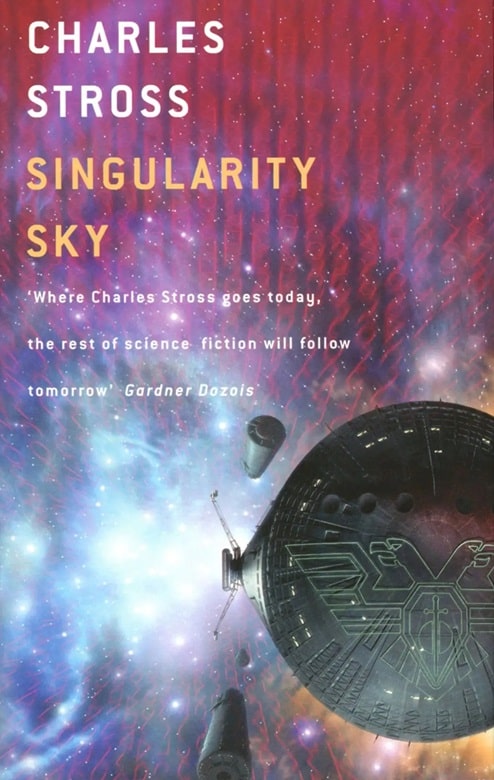 Singularity Sky UK edition (Orbit, 2005). Cover by Lee Gibbons
Singularity Sky UK edition (Orbit, 2005). Cover by Lee Gibbons
There’s a backstory to my reviewing Singularity Sky. Its 2003 publication date made it chronologically eligible for the 2004 Prometheus Award for Best Novel. But it was Stross’s first book publication, and none of the Libertarian Futurist Society’s members happened to read it until that year’s finalists had already been chosen.
However, there was a campaign to write it in, and in fact it received a substantial number of votes, though not quite enough to win; had it been nominated, it might well have won. Now, much later, it’s eligible for the Hall of Fame Award, which can go to works at least twenty years old — and it’s been nominated for that award. As the chair of the committee that chooses Hall of Fame finalists, I’ve just finished rereading it.
[Click images for singular versions.]
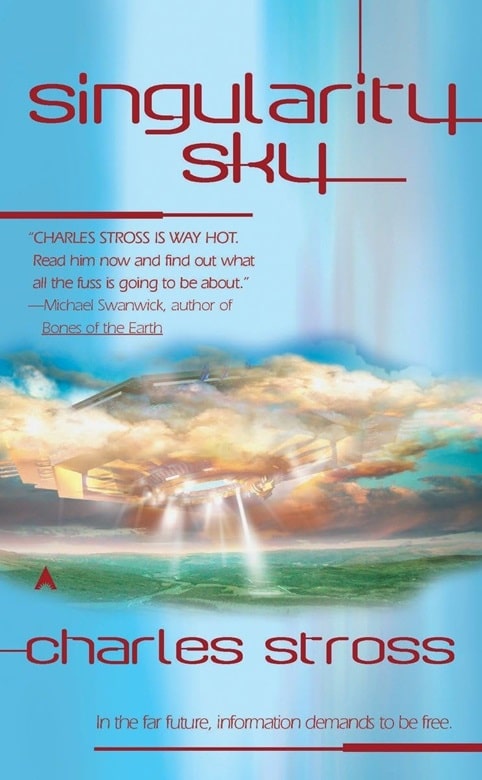
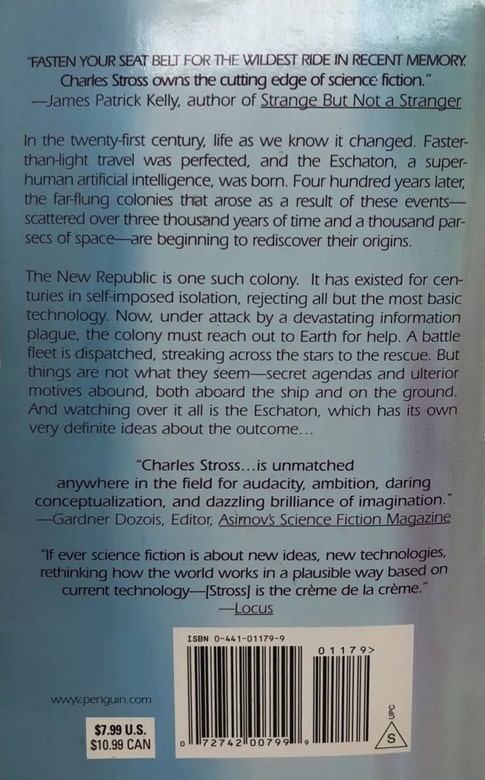
Singularity Sky (Ace Books reprint edition, July 2004). Cover by Danilo Ducak
Singularity Sky seems kind of marginal as libertarian science fiction. Two of the characters, Martin Springfield and Rachel Mansour, say that Earth, their native planet, has an anarchocapitalist legal system (one based on private law enforcement firms competing for customers); early on, Martin tells a police officer,
“For legislation and insurance, I use Pinkertons, with a backup strategic infringement policy from the New Model Air Force… For reasons of nostalgia, I am a registered citizen of the People’s Republic of West Yorkshire, although I haven’t been back there for twenty years. But I wouldn’t say I was answerable to any of these, except my contractual partners — and they’re equally answerable to me.
But none of the story takes place on Earth, and there are no scenes showing how things actually work there (as there were, for example, in Heinlein’s The Moon Is a Harsh Mistress or Vinge’s “The Ungoverned”). What we get seems to be a bit of surface ornamentation rather than a load-bearing speculative element.

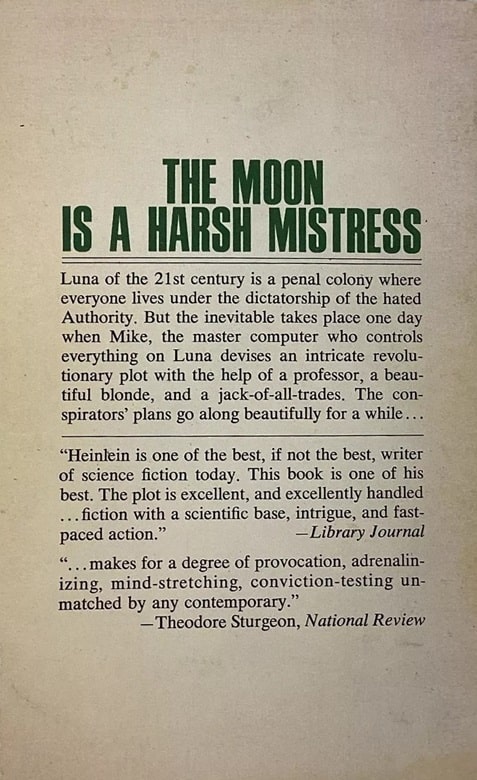
The Moon is a Harsh Mistress by Robert A. Heinlein (Berkley Medallion, September 1968). Cover by Paul Lehr
The actual setting of the story is the New Republic, which, despite its name, seems to be modeled culturally on Tsarist Russia. More precisely, it’s a colony of the New Republic in another solar system, Novy Petrograd, and a New Republican space fleet sent there, with Martin on board as an engineering consultant and Rachel as a diplomatic representative.
We see a great deal about naval operations and naval protocol, and about the New Republic’s security forces and the bureaucratic culture that supports them. It gradually emerges that some time in the past, a cosmic entity from the distant future, the Eschaton, reached back in time and scattered most of Earth’s population across multiple solar systems, where they created new societies largely influenced by historical cultures.
In the course of the novel, the New Republic has to deal with three different versions of liberation that undermine its institutions and customs. First is the Marxist – Gilderist underground on Novy Petrograd (the juxtaposition seems like a hat tip to Ken MacLeod’s early novels), which aims at the overthrow of the established regime through conventional revolutionary politics. Second is Earth, a source of subversive ideas such as “the concept of tax is no different from extortion” that the security forces class as “nonsense verging on sedition.”
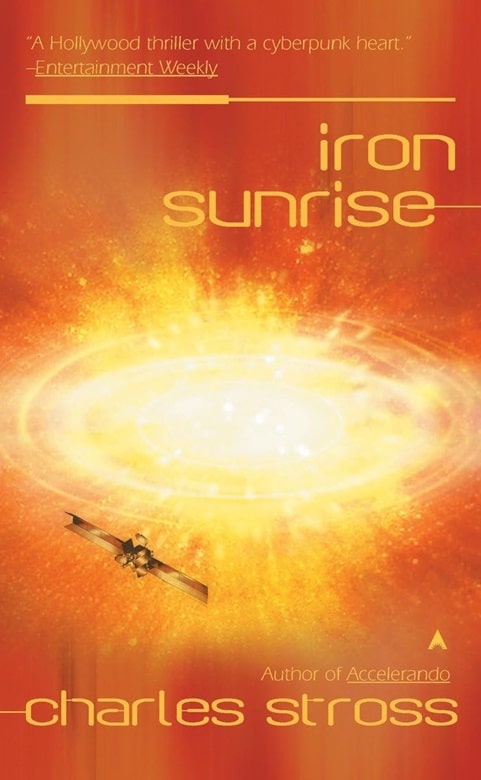

The sequels to Singularity Sky: Iron Sunrise and Accelerando (Ace Books,
July 2005 and July 2006). Covers by Danilo Ducak and Digital Vision
Third, and most powerful, is the Festival, an interstellar fleet of artificial intelligences that goes from star to star opening up communications channels based on quantum entanglement. The Festival’s first step is to bombard Novy Petrograd with telephones, which can be used to speak with it; as a result of these conversations, it grants wishes in exchange for stories and other cultural material. These three intersect in complicated ways in the course of the novel.
One of the important speculative elements in Singularity Sky is the cornucopia machine. The revolutionary leaders have theories about them; in the Prologue they offer to give the Festival a manuscript discussing such a theory in exchange for a cornucopia machine. Rachel Mansour brought a cornucopia seed from Earth, intended to subvert the New Republic’s control of Novy Petrograd. However, the Festival makes her project redundant by flooding the planet with cornucopia machines in trade for folktales and other cultural artifacts. Thus, the concept ties together all three major plot threads.
 Singularity Sky audio edition (Recorded Books)
Singularity Sky audio edition (Recorded Books)
The obvious interpretation of the cornucopia machine is as a basis for a post-scarcity society. But in Stross’s narrative, it’s more like a wish-granting genie or fairy godmother — one that will grant exactly what you wish for, without protecting you against the implications of your wish! The result is that Novy Petrograd turns into a posthuman chaos filled with elements from Russian folklore (for example, an alien who arrived with the Festival travels about in a vehicle remarkably like Baba Yaga’s hut with chicken legs). The whole story thus has the flavor of a fairy tale with a cautionary moral. Indeed it’s a bit like the Brothers Grimm’s story of “The Fisherman and His Wife” in a science fictional setting.
The other major element is an exploration of the implications of superluminal travel. Stross makes a point of the conclusion from relativistic physics that going faster than light is potentially equivalent to time travel; the New Republic’s fleet sets out to exploit this as a basis for naval strategy, by sending an invading fleet back in time to before the Festival is ready for it.
 The Fisherman and His Wife (from the Brothers Grimm)
The Fisherman and His Wife (from the Brothers Grimm)
This turns out to be exactly the sort of thing that gets the Eschaton’s attention: not wanting to see anyone change the past to prevent its coming to be, it takes steps when anyone engages in time travel — and Martin is one of its agents. However, a deeper point is Stross’s skepticism about the idea that interstellar navies will also encounter other interstellar navies at the same point of development technologically; Stross has written about the Battle of Tsushima Straits as an example of what can happen when there’s even a modest technological gap between two fleets. The gap between the New Republic and the Festival is far greater. The possibility of time travel also provides an explanation for the presence of the Eschaton.
Putting all this together gives us a book that’s rich in ideas and story elements — maybe just a little too rich; the effect is sometimes confusing. Science fiction is often described as a literature of ideas; like a literary Stakhanovite, Stross seems to be overfulfilling his quota!
On the other hand, it does a very good job of the bombarding-the-reader-with-ideas effect of classic SF writers such as A.E. Van Vogt. I can certainly see why it made a big splash when Stross was starting his career.
William H. Stoddard is a professional copy editor specializing in scholarly and scientific publications. As a secondary career, he has written more than two dozen books for Steve Jackson Games, starting in 2000 with GURPS Steampunk. He lives in Lawrence, Kansas with his wife, their cat (a ginger tabby), and a hundred shelf feet of books, including large amounts of science fiction, fantasy, and graphic novels. His last article for us was a review of St Trinian’s: The Entire Appalling Business by Ronald Searle.
Prehistrionics, Part II
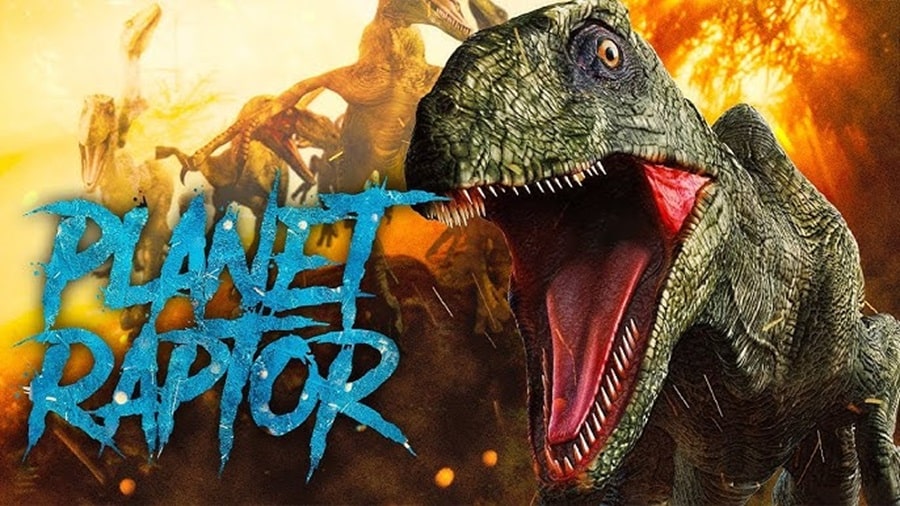 Planet Raptor (Syfy/Apollo Media, 2007)
Planet Raptor (Syfy/Apollo Media, 2007)
We’re off on another adventure filled to the brim with disappointment. 20 films I’ve never seen before, all free to stream, all dinosaur-based.
Oh god.
Planet Raptor (2007) TubiJust how bad is the CG? Horrendous.
Sexy scientist? Yep.
Mumbo jumbo? Alien termite Ren fair raptors.
I got tricked by seeing a couple of names I recognized (Steven Bauer, Ted Raimi, Vanessa Angel) and ended up hate-watching this exercise in dull stupidity. A sequel to the possibly worse Raptor Island, this one pits a platoon of inept space marines against a medieval planet full of dinosaurs, lovingly rendered using PS2 graphics.
There’s some practical gore and a couple of puppet raptor close-ups that aren’t terrible, but the plot is as dumb as a wasp enema and the acting is limper than a Taco Bell lettuce shred. Angel, as Dr. Zipper McBlankstare, does nothing, and Raimi skulks around as suspiciously as he can muster. The rest of the red shirts make poor decisions and die by being nudged to death with rubber snouts.
Rubbish.
3/10
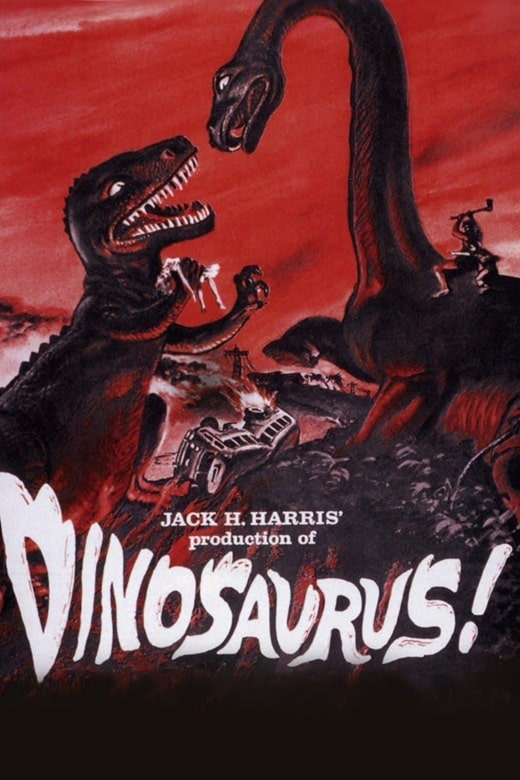
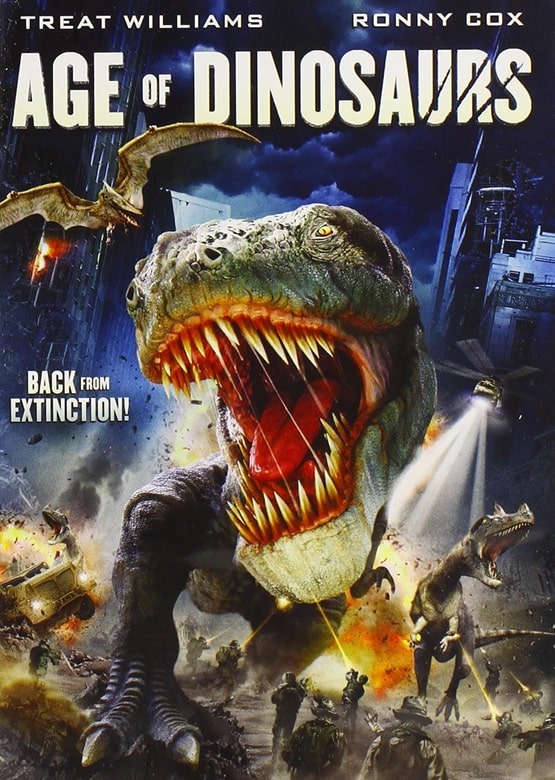
Dinosaurus! (Universal International, 1960), and Age of Dinosaurs (The Asylum, 2013)
Just how bad is the CG? No CG.
Sexy scientist? Nope.
Mumbo jumbo? Reanimated dinosaurs, caveman.
A gently bonkers entry in the ‘small child befriends giant monster’ genre, Dinosaurus! tells a simple story (island construction wakes up some beasts and a caveman) and liberally sprinkles in every racial stereotype you could imagine. Par for the course for a sixty year old flick, so I’m not complaining. The caveman is played fully for comic relief and the dinosaurs, a wrongly named Brontosaurus and a T-Rex, are charming puppets for some of the film, and charming stop-motion for the rest. It’s all rather charming. 60% daft, 40% dull, 100% perfect rubbish.
6/10
Age of Dinosaurs (2013) YouTubeJust how bad is the CG? A couple of half decent shots.
Sexy scientist? Nope.
Mumbo jumbo? Genetic clones.
Treat Williams and Ronny Cox are the genre veterans that might have possibly saved this, but the dodgy dinosaurs, spotty acting and clunky direction relegate it to the C-list. The multitudes of monsters are mostly rendered in weightless CG, but there are a couple of puppets used early on that are not at all bad, and the filmmakers certainly had some bronto-balls to try to pull off some bold set pieces. Ultimately, it’s not great but it’s loud and daft, and that’s all I’m asking for at this point.
6/10
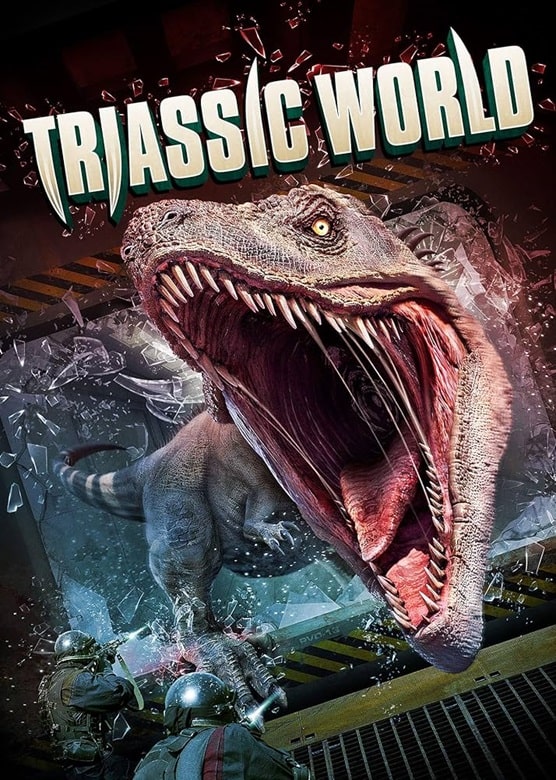

Triassic World (The Asylum, 2018), and The Dinosaur Experiment (Nu Imagination, 2012)
Just how bad is the CG? Not utterly terrible.
Sexy scientist? Yep.
Mumbo jumbo? Cloning smart dinos for organs.
Jurassic World: Fallen Kingdom was all the rage, so The Asylum stepped up to the plate with this slice of hokum. Actually, for an Asylum flick, it’s not too bad. It’s played straight and everyone in it is very earnest. It brings nothing new to the table, as various morsels find themselves trapped in a lab with a clever lizard, and they don’t take long to turn on each other. Dr. Perky McTrankdart tries to keep it all together, but some terrible decisions quickly lead to messy nom noms courtesy of the sometimes practical gojirasaurus, all shot in gory close up. I didn’t hate it.
6/10
The Dinosaur Experiment aka Raptor Ranch (2012) TubiJust how bad is the CG? Not the worst.
Sexy scientist? Nope. Sexy everything but.
Mumbo jumbo? Resurrected dinosaurs.
There are only two phrases that are able to strike terror into the hearts of B-movie purveyors: ‘horror-comedy’ and ‘Uncork’d Pictures’. For this offering, the premise is simple; gather a random collection of cartoonish stereotypes in a backwater location, and let the animals loose. By now you should know what to expect, so let’s highlight some details. The name attached to this is the stalwart Lorenzo Lamas, who did about two days of filming as an X-files type. The lead is a Grammy and Nammy nominated Native American singer, Jana Mashonee, and she’s pretty good, but she ultimately serves the same purpose as every other female character, eye candy for the redneck horndogs and frat boy cyphers.
It’s rubbish, but it’s occasionally entertaining rubbish, and I’ll take that as a win.
5/10
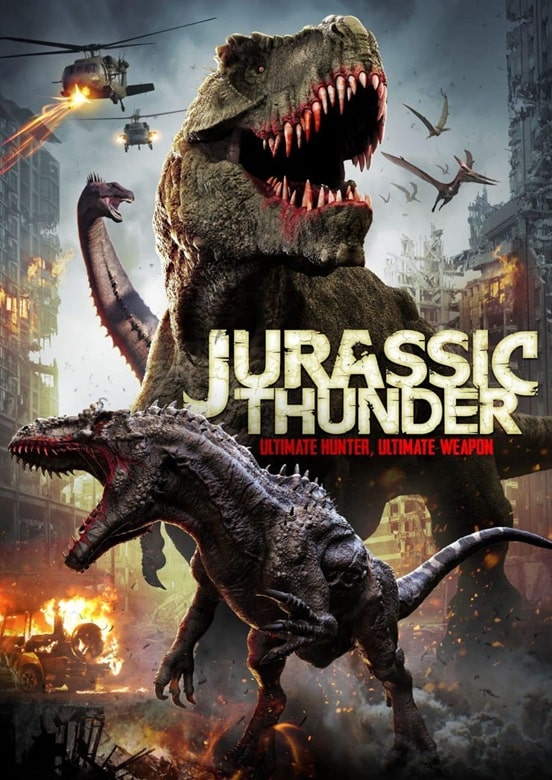
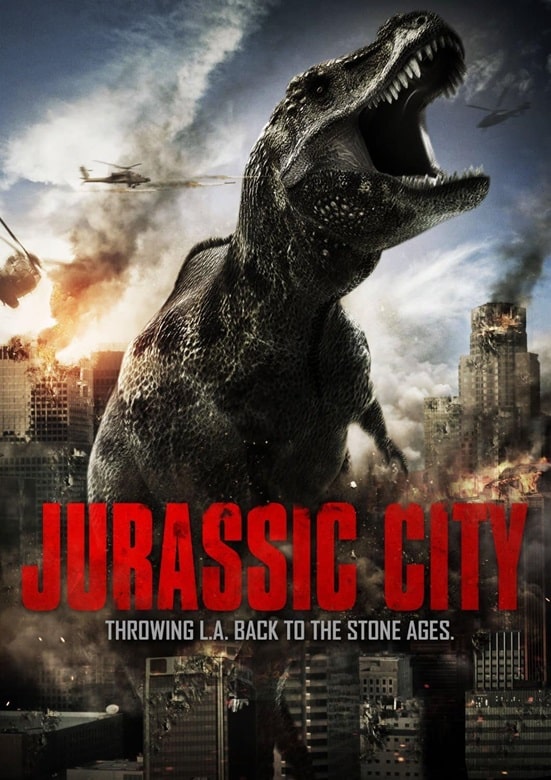
Jurassic Thunder (High Octane Studios, 2019), and Jurassic City (Vertical Entertainment, 2015)
Just how bad is the CG? Shockingly bad.
Sexy scientist? Nope.
Mumbo jumbo? Comic books, zombies, weaponized dinosaurs.
Utter shite.
0/10
Jurassic City (2015) TubiJust how bad is the CG? Pretty bad.
Sexy scientist? Nope.
Mumbo jumbo? Cloning.
Stop me if you’ve heard this: secret lab breeds dinosaurs for nefarious purposes, dinosaurs get out, inept military types try to stop them, girls in hot tubs get eaten.
Another regrettable entry in a long list of regrettable entries, JC is at least competently shot and acted (for the most part), and there are a couple of shots of dinos that almost work, but for the most part the CG is horribly lit and composited, and the over-reliance on digital blood is annoying. There was one moment when a girl in a bikini and furry vest is tripping and hallucinates a giant, glowing bunny, instead of the raptor that is about to bite her head off, that made me laugh. However, that’s the only entertaining moment in a film that asks us to root for a multiple rapist and murderer. The opening credits looked good though, so there’s that.
5/10
Previous Murkey Movie surveys from Neil Baker include:
Prehistrionics, Part I
Jumping the Shark
Alien Overlords
Biggus Footus
I Like Big Bugs and I Cannot Lie
The Weird, Weird West
Warrior Women Watch-a-thon
Neil Baker’s last article for us was Prehistrionics, Part I. Neil spends his days watching dodgy movies, most of them terrible, in the hope that you might be inspired to watch them too. He is often asked why he doesn’t watch ‘proper’ films, and he honestly doesn’t have a good answer. He is an author, illustrator, outdoor educator and owner of April Moon Books (AprilMoonBooks.com).
Action, Intrigue, and Glorious Battles: William R. Forstchen’s The Lost Regiment
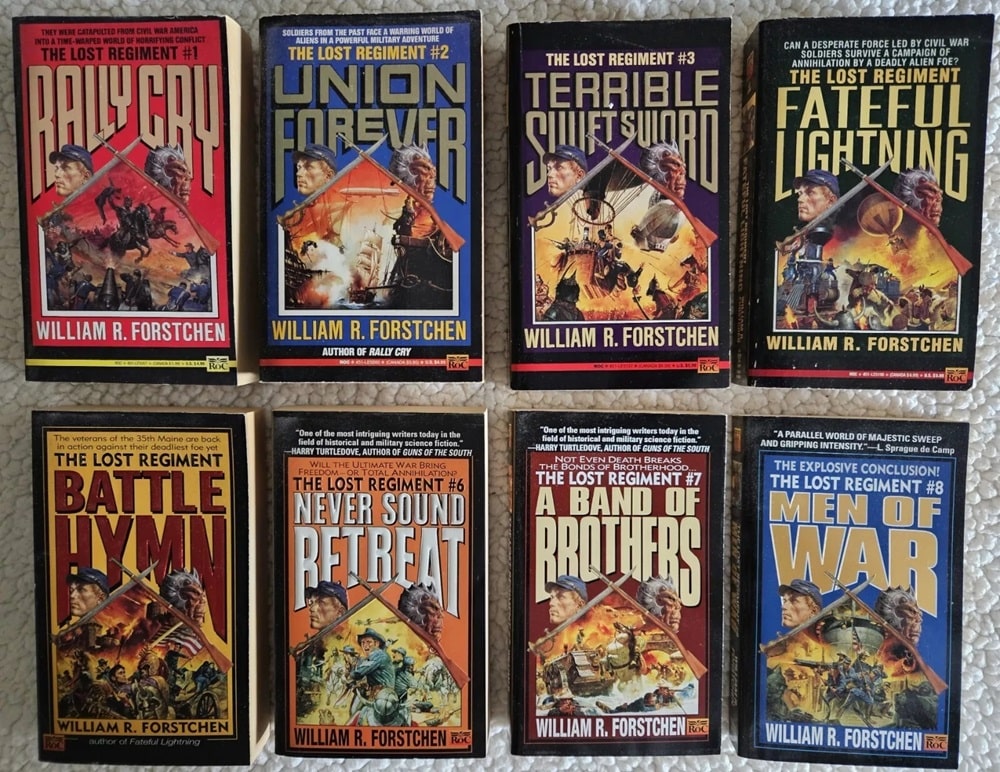 The Lost Regiment, by William R. Forstchen (Roc Books, 1990-99). Covers by Sanjulian
The Lost Regiment, by William R. Forstchen (Roc Books, 1990-99). Covers by Sanjulian
William R. Forstchen was born on October 11th, 1950, eight years and three days before my birthday. He earned a Ph.D. in history, specializing in the American Civil War, and teaches at Montreat College in North Carolina. He’s one of my favorite authors. He isn’t quite Sword & Planet but has a series that is adjacent with lots of S&P elements. It’s called The Lost Regiment and ran to 8 books. He later wrote a 9th book that took place 20 years after the end of the original series, but has not written any more.
All were published by Roc Science Fiction. Sanjulian is credited with the covers for books 6, 7, and 8, and if he did those I’m pretty sure he did all the previous ones as well, which clearly have the same style. However, book 9’s cover is credited to Edwin Herder. The Sanjulian covers are great but are quite small on the books and should have been larger.
[Click the images for regimental versions.]
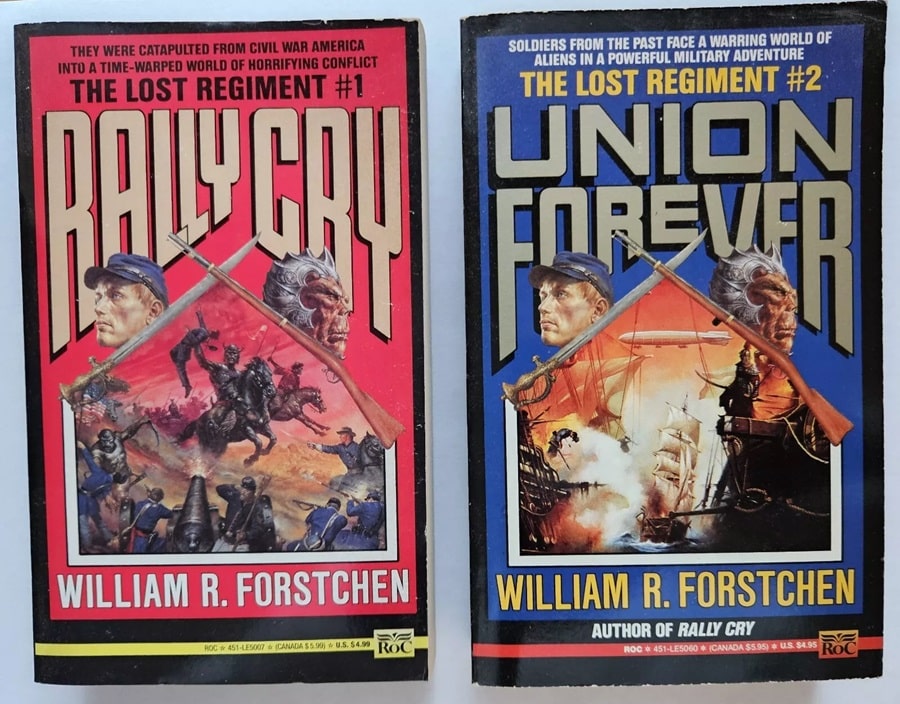
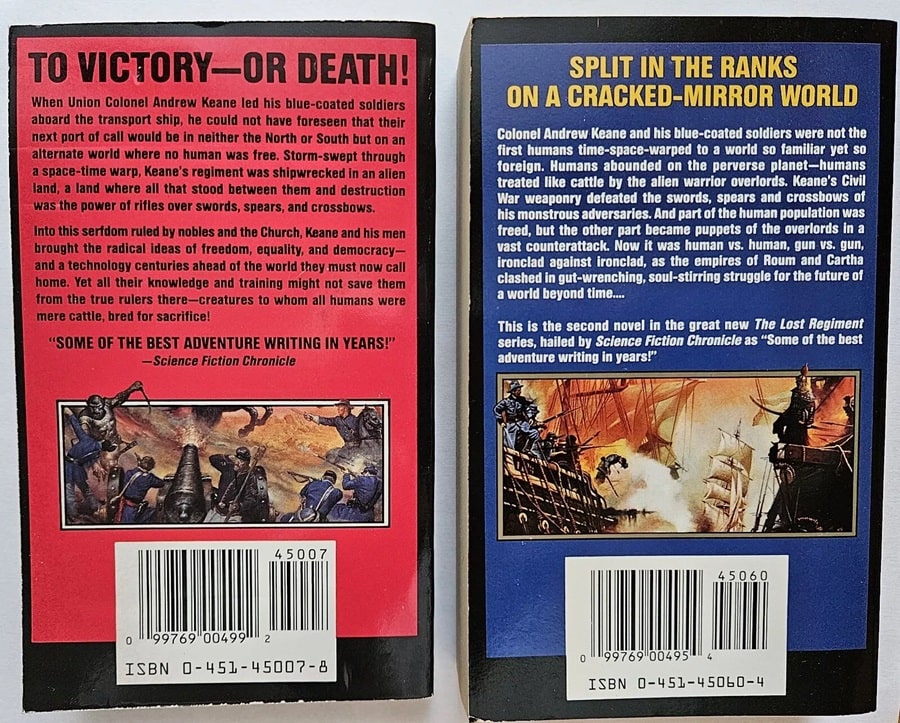
Rally Cry and Union Forever (Roc, May 1990 and February 1991). Covers by Sanjulian
The series consists of:
1. Rally Cry, 1990
2. Union Forever, 1991
3. Terrible Swift Sword, 1992
4. Fateful Lightning, 1992
5. Battle Hymn, 1997
6. Never Sound Retreat, 1998
7. A Band of Brothers, 1999
8. Men of War, 1999
9. Down to the Sea, 2000
Note: there are some mild spoilers ahead.
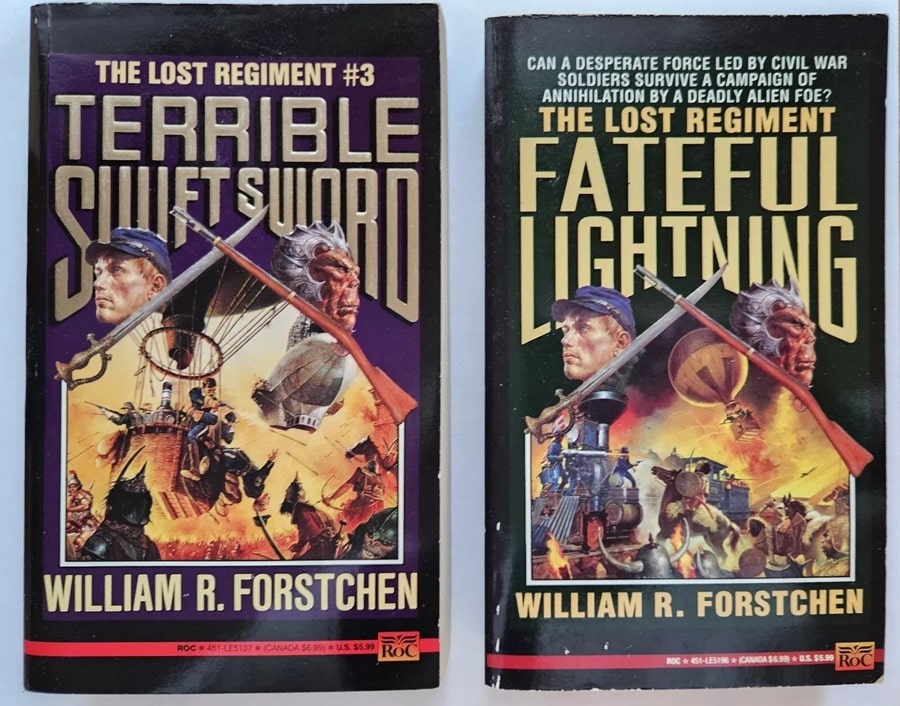
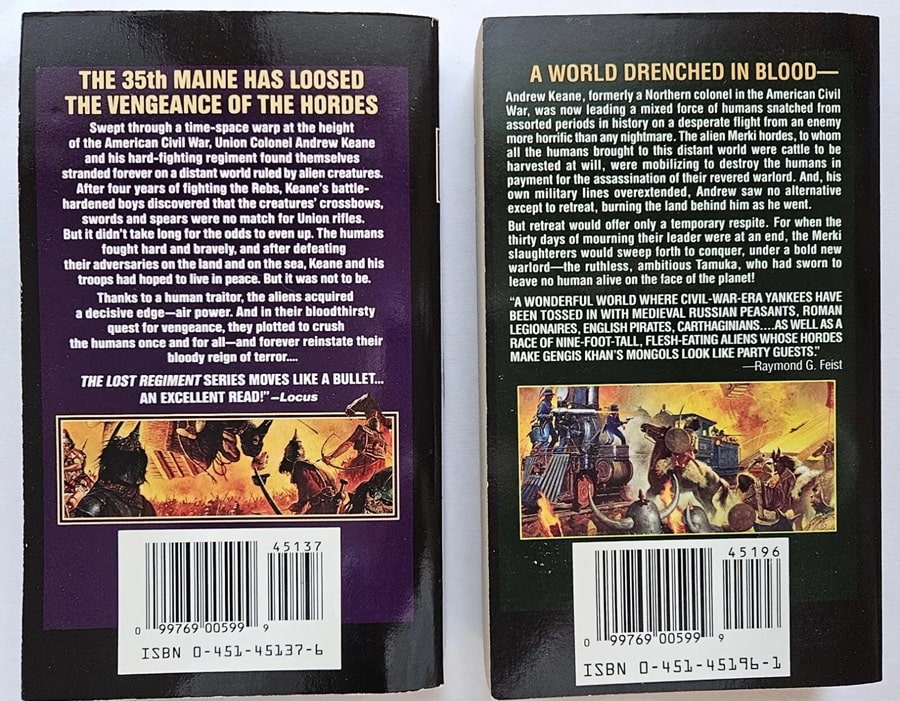
Terrible Swift Sword and Fateful Lightning (Roc, February 1992 and January 1993). Covers by Sanjulian
The first book, Rally Cry, starts out in good S&P fashion when two regiments of Union Soldiers from the Civil War board a transport ship to be taken to a battle against the Confederacy. While in the “Bermuda Triangle,” a storm hits and a tremendously bright light envelops them. They lose consciousness and wake up on another world, which they learn is called Valdennia. Other human groups have been previously transported to the world, including some Medieval Russians, Romans, and Carthaginians.
There is also an alien race of humanoids 8 to 10 feet tall and of massive build. These are called “Tugars” by most people, although we find out later there are different hordes of them. They are nomadic and ride huge horses bred from Earth stock, and use only primitive weaponry such as swords, lances and powerful bows. In fact, they reject anything resembling guns. The Tugars “eat” humans, and as they pass through the lands of human settlements they take a tithe of 20 percent of the people living there, but their territory is very large so they don’t pass too often. The Tugars also come from another world and it turns out their ancestors built the Light Gates, although the current Tugars don’t know how they work.
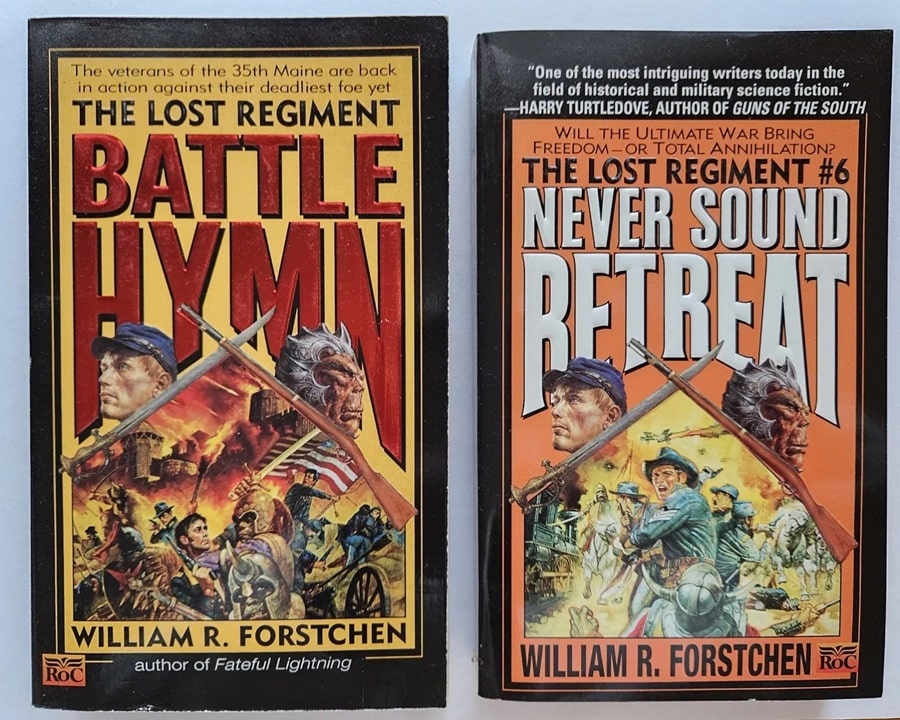

Battle Hymn and Never Sound Retreat (Roc, January 1997 and January 1998). Covers by Sanjulian
The series consists of the two Union Regiments allying with the humans of Valdennia to stop the horde. Their guns and cannon make a big difference and they decimate the Tugars. But then another horde, the Merki, step in, and behind them is a third horde called the Bantang. The Merki began to make use of gunpowder themselves and start to train human slaves to fight for them. The Union regiments and their allies must industrialize and advance in weaponry in order to survive.
These are thick books but scarcely a word is wasted. They are full of action and intrigue, but really have glorious battles. The characters are interesting and sympathetic. This was the first series like this I ever read, although a writer named Taylor Anderson, another historian, used the same concept in his Destroyermen series. I don’t believe these books would have existed without the influence of Sword & Planet works like ERB’s Barsoom tales.
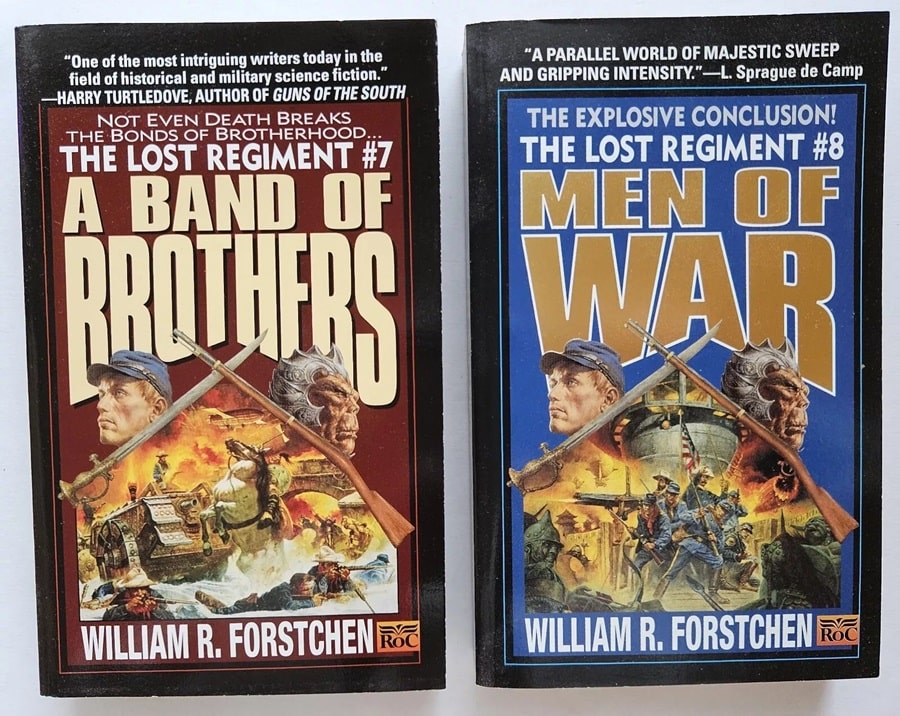
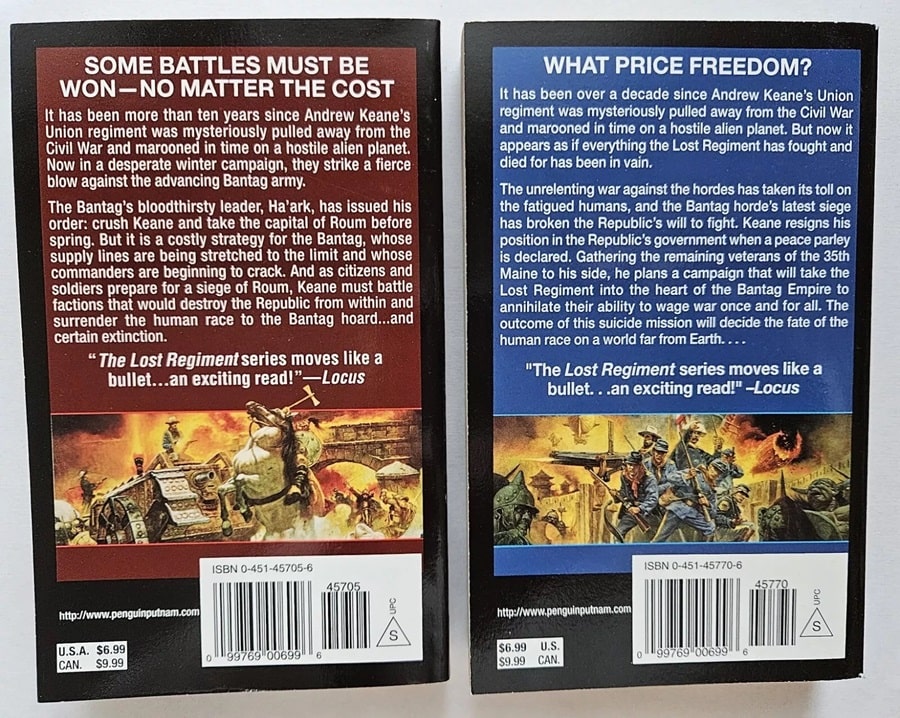
A Band of Brothers and Men of War (Roc, January 1999 and December 1999). Covers by Sanjulian
William Forstchen’s first book was published in 1983 and called Ice Prophet, with a cool cover by Darrell Sweet. It’s a post-apocalyptic fantasy set on a future, frozen Earth, similar to the setting for Michael Moorcock’s Ice Schooner. Rival religions rule the remnants of humanity but a new prophet arrives. There’s kind of a Dune vibe to the tale. It spawned two sequels but I haven’t read those. The book is good but it doesn’t have the quality of many of his later books. Forstchen’s clear strength is in using historical settings and historical types of characters.
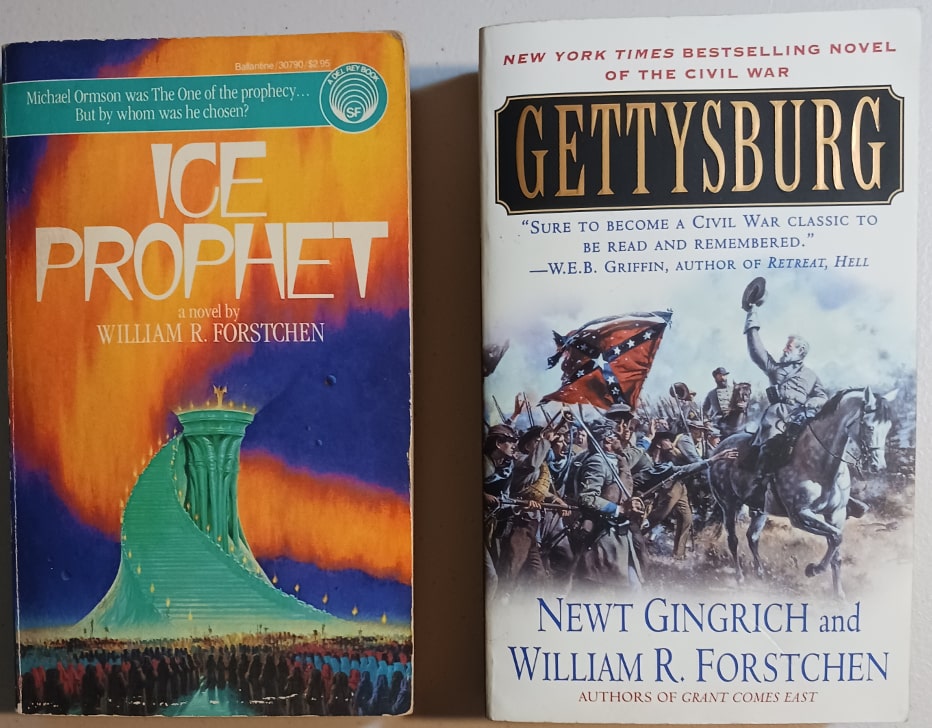 Ice Prophet by William R. Forstchen (Del Rey, August 1983) and Gettysburg by William R. Forstchen and Newt Gingrich (Thomas Dunne Books, June 2003). Covers by Darrell K. Sweet and Don Troiani
Ice Prophet by William R. Forstchen (Del Rey, August 1983) and Gettysburg by William R. Forstchen and Newt Gingrich (Thomas Dunne Books, June 2003). Covers by Darrell K. Sweet and Don Troiani
The next book I read from Forstchen after The Lost Regiment series was Gettysburg, (2003), which he wrote supposedly with Newt Gingrich. I personally don’t believe Gingrich had much to do with it. Everything in it seems to be Forstchen through and through, and there are even some characters and situations that are virtual rewrites of scenes from The Lost Regiment series. It was very good and there are two sequels that I will likely read at some point. Forstchen can really capture the heroism of men at war. The excellent cover is by Don Troiani.
He started a trilogy in 2009 with One Second After, followed by One Year After in 2015 and The Final Day in 2017. I actually suspect he meant the first book to be a standalone but it was so popular he came back to write two more some six years later. One Second After is one of the most memorable books I’ve ever read. I literally wept at the end.
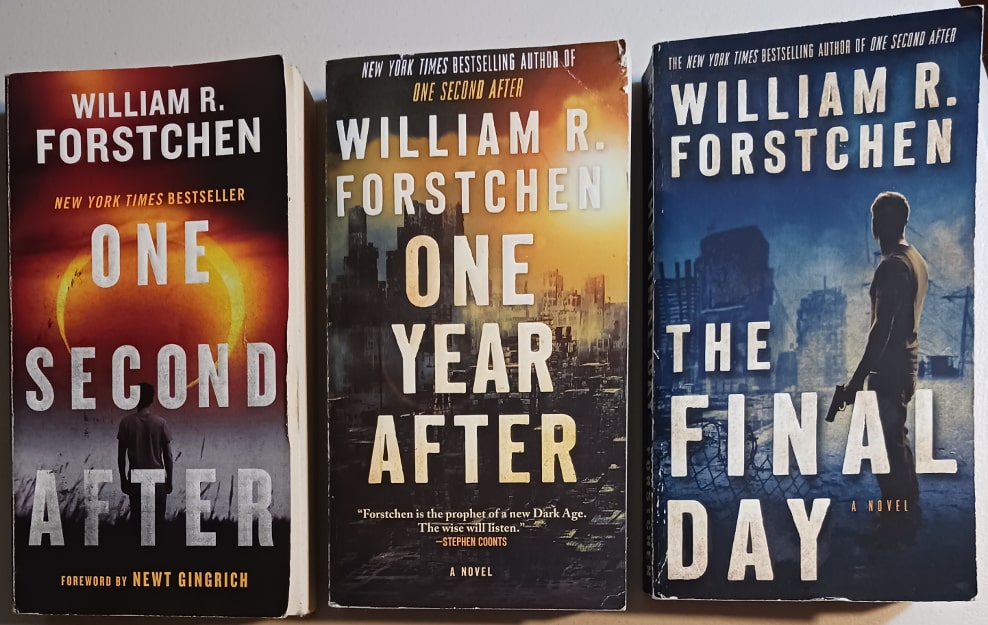 The One Second After trilogy: One Second After, One Year After, and The Final Day (Forge, March 2009, September 2015, and January 2017). Cover art: Trevillion and Thinkstock
The One Second After trilogy: One Second After, One Year After, and The Final Day (Forge, March 2009, September 2015, and January 2017). Cover art: Trevillion and Thinkstock
The two sequels are not as strong and are a little wordy in places, but they are still very good reads. The basic premise is what happens to a small town and its people after an EMP attack (electromagnetic pulse) on the US that wipes out all our electricity, bringing down our entire economy. This certainly isn’t the first time this kind of phenomenon has been used in fiction. S. M. Stirling’s Dies the Fire series posits a strange even that stops all electricity from working worldwide.
But Forstchen’s take is very well done and — I think — gives a pretty realistic, though perhaps optimistic view of what would happen. It chronicles the attempt by this one small town to hold onto their civilization and their humanity. One Year After looks back at the same folks a year later, and The Final Day takes place after a more general recovery has begun but is being corrupted from the inside.
Quite possibly because of his association with Newt Gingrich, who wrote the Foreword of One Second After, Forstchen has been criticized for holding overly right-wing views. After reading many of his books, I do believe that he is probably a political conservative, which I am not. However, his views seem nuanced to me. What he has created are very real seeming characters who hold certain conservative viewpoints. I know and get along with plenty of people who share such viewpoints and I would not consider them to be “right-wingers” in the pejorative sense of that word. Ultimately, these are good stories.
Charles Gramlich administers The Swords & Planet League group on Facebook, where this post first appeared. His last article for Black Gate was The Sword & Planet Fiction of Robert Moore Williams.
Goth Chick News: Celebrating Our 666th Black Gate Article with an Exclusive Announcement
 Dirk and yours truly, Chicago Comic and Entertainment Expo 2014
Dirk and yours truly, Chicago Comic and Entertainment Expo 2014
A couple years back, my long-time friend comic writer/creator Dirk Manning called dibs. He let me know that when the time came for me to publish my 666th article for Black Gate that he wanted to be my subject.
I first introduced Manning to all of you in 2011 during his nationwide tour promoting his horror comic series, Nightmare World. As a fan of horror comics since they were contraband for my young self, I loved how Manning’s work reminded me of everything I enjoyed about the genre. His most recent project has been a collaboration with the estate of legendary actor Lon Chaney to bring the lost classic horror film London After Midnight back to life in graphic novel form. Since 2011, Manning has made multiple appearances in GCN marking his many projects and his ever-growing fan base.
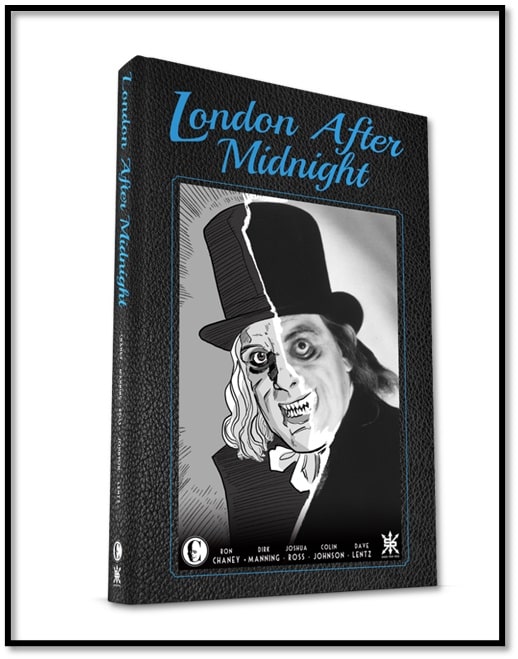 London After Midnight: The Official Graphic Novel Adaptation by Ron Chaney, Dirk Manning, Joshua Ross, and Colin Johnson (Chaney Entertainment and Source Point Press, 2025)
London After Midnight: The Official Graphic Novel Adaptation by Ron Chaney, Dirk Manning, Joshua Ross, and Colin Johnson (Chaney Entertainment and Source Point Press, 2025)
However, laying claim to a Goth Chick New milestone article would require a monumental announcement, and Dirk promised to deliver. Our agreement included holding this news until early January 2025 due to various NDAs, which in turn meant a lot of leeway from BG Big Cheese John O allowing me to skip writing on various weeks throughout 2024, enabling my 666th GCN to align with Dirk’s timing.
So, without further ado, allow me to present Goth Chick News’ 666th article for Black Gate Magazine.
Buckle up readers, here we go…
 Dirk Manning
Dirk Manning
GC: We are sitting with Dirk Manning and Josh Malerman, New York Times best-selling author of Bird Box and Incidents Around the House for an exclusive about their upcoming collaboration. Tell us how you came to partner up for this exciting new graphic novel RSVP E.S.P.?
DIRK MANNING: Thank you so much for allowing us to give you this Black Gate exclusive interview about this project! We’ve both been waiting to be able to talk about this new graphic novel for a while now! As for how it started, I first met Josh Malerman after a mutual friend at the time foisted a copy of Bird Box into my hands, citing that he thought it would be up my alley as a fellow horror writer. This was back in late 2015, well before the movie and the following cultural phenomenon surrounding it had happened, so I went into it fairly blind, intrigued by the Lovecraftian concept of a creature that drove you mad the moment you made eye contact with it. Well, once I started the book, I legitimately had a hard time putting it down, and upon finishing it I was so blown away that I circled back and asked if I could meet Josh, just to tell him face-to-face what a fan I was of the book. I was genuinely already a super-fan, ha-ha! The meeting happened over a hot dog and tacos dinner on February 12th, 2016, and I immediately became a fan of Josh as a person that night, too… and we’ve remained both colleagues and pals ever since.
 Josh Malerman
Josh Malerman
JOSH MALERMAN: The older we get (and none of us are that old), the more I understand how rare it is to become immediate friends with someone. Not because any of us are so cynical, but because we’re busy, because we have friends, because we have passions and we’re spending so much time with those. But when it does happen, when you cross paths with someone who is either in your field or doing what they do for the same reasons you are… it’s impossible to miss. I think it took all of ten seconds for me to recognize an immediate friend and like-minded soul in Dirk Manning. The way he presented himself, his work, the people in his life… his sense of humor, his tastes, his intelligence… it was all on display in everything he says. I knew right away I wanted to work with him on something. What that was wouldn’t present itself for a minute… and once it did, it was clear as day.
DIRK: Fast forward to September 2022. By this point Josh had released several more books and had achieved well-earned superstardom as one of the best horror novelists of this generation (at least), and I had recently taken a position as Special Projects Manager with Michigan-based comic publisher Source Point Press. This meant, along with publishing my own creator-owned work, I was shepherding projects with various high-profile talents outside the world of comics, such as musicians Twiztid and Blaze Ya Dead Homie and professional wrestling personalities Tony Schiavone and Arn Anderson… so the idea of bringing Josh Malerman into the fold in a similar fashion was of course a no-brainer to me. Well, Josh always does these cool book release party events for his novels, and for Daphne the event was taking place on a high school basketball court since the main character was a high school basketball player. How cool, right? Given the setting – and despite my lack of sport skills – I decided to ‘shoot my shot’ on this, asking him – literally on the court in front of the hoop (where we was nailing several free throws, I might add), ‘Hey, have you ever thought about writing a graphic novel?’ Without missing a beat he immediately fired back ‘Only if you’ll write it with me.’”
 Bird Box (Ecco, February 10, 2015)
Bird Box (Ecco, February 10, 2015)
JOSH: I have a long history of collaborating with my fellow bandmates in The High Strung. For years now, Mark and I write the songs, then we hand them over to the band and they make their music. We don’t tell them what to play. That would be counterintuitive to everything fun about the process. When the movie Bird Box was made, I felt I’d written the song (the book) and then Netflix and Sandra Bullock made their music. Fantastic. Perfect. So! When Dirk asked about working on a graphic novel, I immediately thought: “omg yes.” I had a story idea that I hoped would work, we talked about it some, and then Dirk… well, then Dirk made his music.
DIRK: After mulling things over a bit, Josh presented me with a story idea originally titled Two Gods in the House (and since renamed RSVP E.S.P. – which is a story in itself for another time, haha!) about a scientist who invites two potentially psychic children into his house to prove the existence of psychic powers… not realizing how powerful they really are or what he’s in for by doing so. He expressed to me that, while he loved the story (and rightfully so, as it was amazing) that he couldn’t quite make it work as a prose novel. Upon reviewing everything he gave me, I told him what I saw as both an obstacle and an opportunity: “I can see why, dude: This is a story that needs to be told visually.”
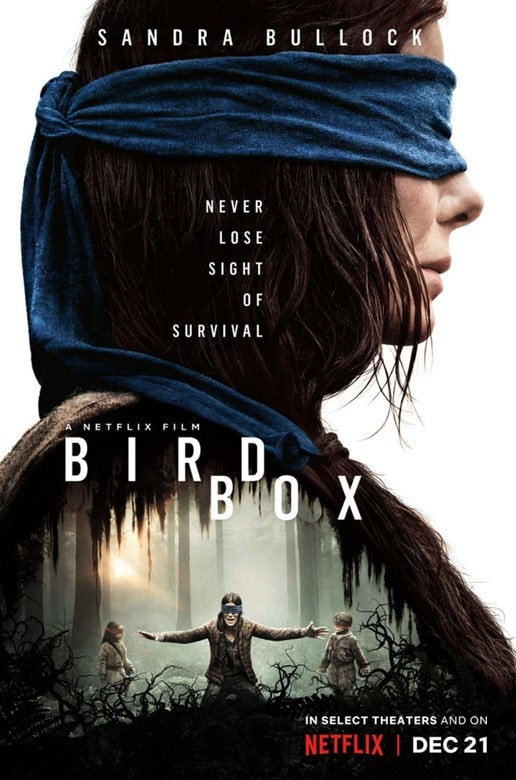 Bird Box (Netflix, December 14, 2018)
Bird Box (Netflix, December 14, 2018)
JOSH: I think it took somebody who worked in a more visual field to point out to me that RSVP E.S.P. was born to be a visual story. Everything about it was cinematic, to be seen, to be felt, and I’d been wrestling with it on a description level for that very reason. Think of your favorite scenes in a movie, the ones that move you to tears… often they are a simple change in somebody’s expression, a change in light, a change in color. Dirk saw this straight away in the story. He knew the arc, the peaks, the rhythm… but also… he knew the illustrator. This led to an incredible night at my house, in which Dirk, illustrator Joshua Ross and myself essentially cut the ribbon, slammed the shovel into the ground… we broke ground that night on the graphic novel. It was absolute magic.
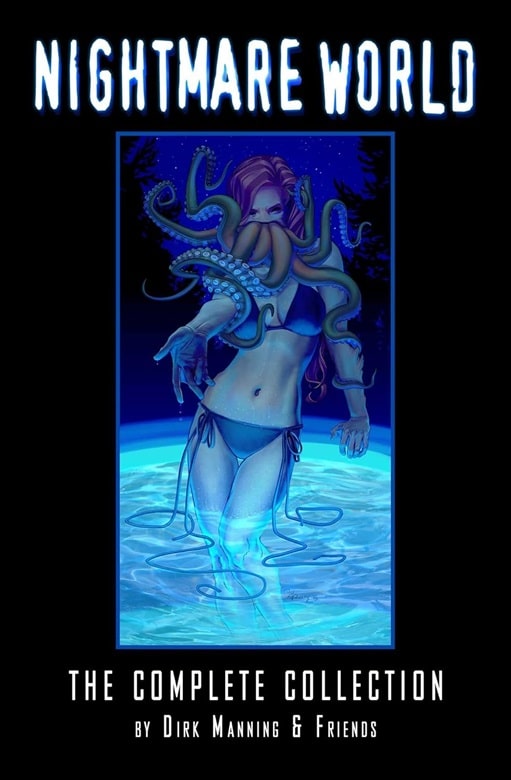 Nightmare World: The Complete Collection (Source Point Press, May 21, 2024)
Nightmare World: The Complete Collection (Source Point Press, May 21, 2024)
DIRK: From the beginning of the process, I knew only one illustrator could possibly do RSVP E.S.P. justice as a graphic novel, and that illustrator was Joshua Ross. Joshua had been one of my longest artistic collaborators in comics for my 20+ year career, stemming all the way back to the earliest days of Nightmare World and then being the artist I chose to work with to launch Tales of Mr. Rhee. Eventually Joshua stepped back from comics for a bit to work on the launch of his tattoo studio Raygun Samurai, but we still did occasional comic work together. Then in 2020 he wrote and fully illustrated his own first graphic novel Left Turns, which went on to be published by Source Point Press and also earned a Publishers Weekly review. As he finished that book I reached out to him and said “Listen, I can’t tell you any specific details yet, but I’m going to be involved with working on a graphic novel with a #1 New York Times Best-Selling horror author, and you’re the only person I know who would be able to illustrate this story. Would you be willing to jump back into doing a full graphic novel together for this one?’ To his credit, Joshua said “I trust you and I’m in” and that was that. I then brought in colorist Colin Johnson and letterer Dave Lentz, both of whom I’d worked with on Homestead as well as my longtime graphic novel editor Drena Jo, solidifying our team… and then the work on bringing RSVP E.S.P. to life as a 120 page graphic novel began in earnest!
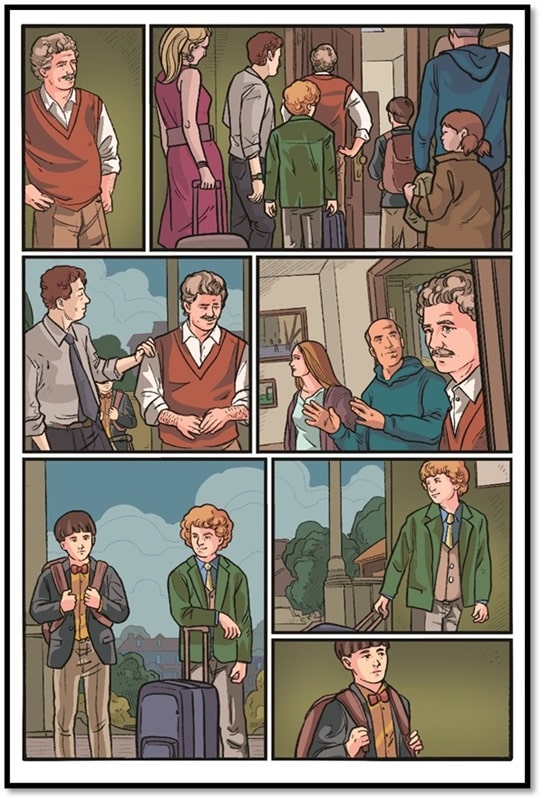 First look at unlettered art from the RSVP E.S.P. graphic novel
First look at unlettered art from the RSVP E.S.P. graphic novel
JOSH: I know I’m a writer, and I know I’m supposed to be able to articulate how I feel by nature, but it’s hard for me to express how far RSVP E.S.P. has surpassed my expectations. I was happy to be working with these people at all. But to watch them each take their turn (Dirk with writing, Joshua with illustrating, Colin with coloring) was like watching the best people at their best. It’s the reason I love collaboration in the first place: it’s not the pressure of wanting to live up to those around you… it’s the inspiration you get from them, the wind tunnel you all create together, the crest that only exists because you all said yes.
DIRK: The book is now fully illustrated and colored, lettering is about to begin, and we’ll be doing a presale launch on Kickstarter in February or March for a Limited Edition Kickstarter Exclusive Hardcover of the graphic novel before we then solicit a standard softcover edition through mass market retailers after that. Details on the upcoming release will be shared on my Instagram, Facebook, and BlueSky accounts at @dirkmanning as well as through my monthly newsletter which people can subscribe to at www.DirkManning.com.
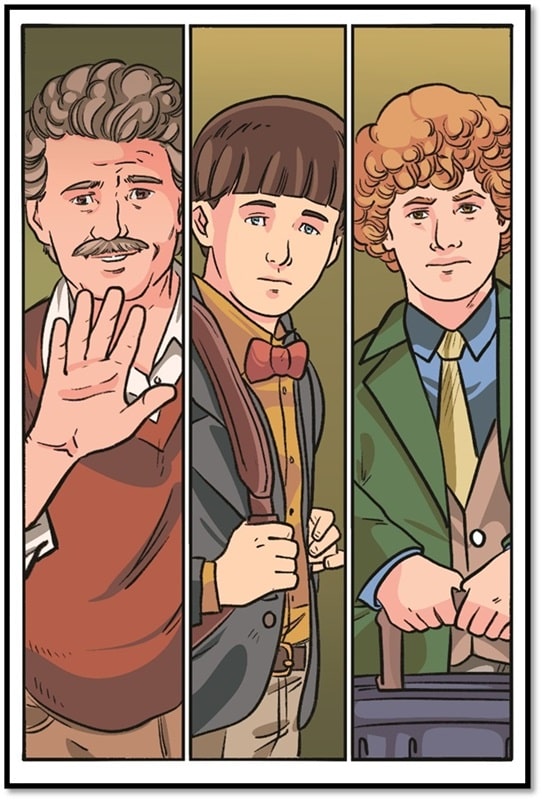 First look at unlettered art from the RSVP E.S.P. graphic novel
First look at unlettered art from the RSVP E.S.P. graphic novel
JOSH: RSVP E.S.P. has been one of the greatest artistic experiences of my life. I simply cannot wait for this to come out. For the world to hold it, to slip into the story of a doctor who has no idea the power that exists in his home and lab. I’m sure I’ll be talking about it all very soon on Facebook and Instagram (I’m just @JoshMalerman at all places online), as well as my website joshmalerman.com.
GC: Thank you both for dropping the news of this exciting project at Black Gate. We’ll be looking out for more in the coming months and hope you’ll sit down with us again near your publication date.
More of Dirk’s comic work includes Butts in Seats: The Tony Schiavone Story (a #1 Best-Selling Graphic Novel on Amazon), Buried But Not Dead (Ringo Award finalist for Best Original Graphic Novel in 2021), Twiztid Haunted High-Ons (Ringo Award finalist for Best Humor Comic in 2020 and 2022) among many others. He is also the author of the inspirational/how-to column turned book series Write or Wrong: A Writer’s Guide to Creating Comics and has contributed several short stories to the RPG game series Clockwork: Dominion for Reliquary Game Studios. His screenplay writing credits include the YouTube horror series BlackboxTV episode “The Hunger” directed by Drew Daywalt and featuring Bonnie Aarons (The Nun, I Know Who Killed Me) and Jon Gries (Napolean Dynamite, Men in Black).
When not at his desk writing, touring the comic convention circuit, and/or sampling his way across the best ice cream shops in the world, Dirk can be found online at www.DirkManning.com and on most social media platforms as @dirkmanning.
In addition to being a best-selling author, Josh Malerman is also one of two singer/songwriters for the Michigan rock band The High Strung, whose song “The Luck You Got” can be heard as the theme song for the Showtime show Shameless. He loves endless, enthusiastic conversations, shooting pool, and thinks Freddy Krueger is the most brilliant monster ever created. He lives in Michigan with his fiancée, the artist/musician Allison Laakko and their five hundred pets.
I would like to personally thank all of you for checking in on Goth Chick News each week and leaving your wonderful and beautifully sarcastic comments over these many years. I look forward to reading each one – especially the regulars. I must also give a shout to Black Gate Photog Chris Z who joined me for the first time in 2012 and whose hysterical snark has almost (but not quite) gotten our press credentials revoked on more than one occasion. And finally, my continual gratitude to Black Gate Big Cheese John O who first published me in Black Gate’s second print issue and whose encouragement turned this quirky side-hustle into a 20+ year passion.
Hal Clement Helped Launch My Writing Career
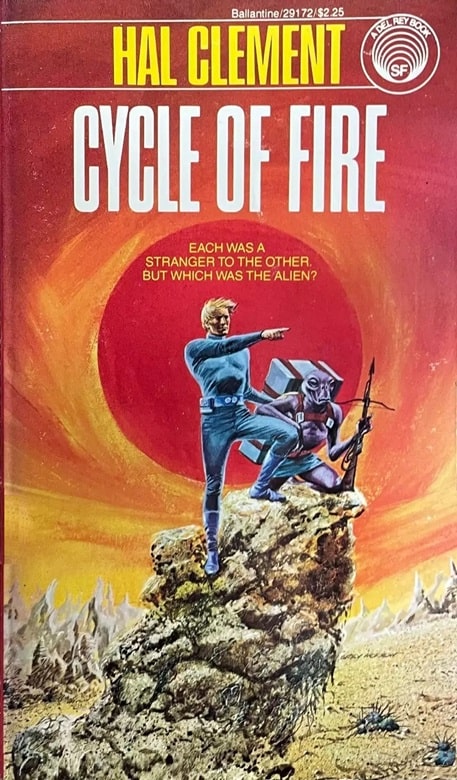
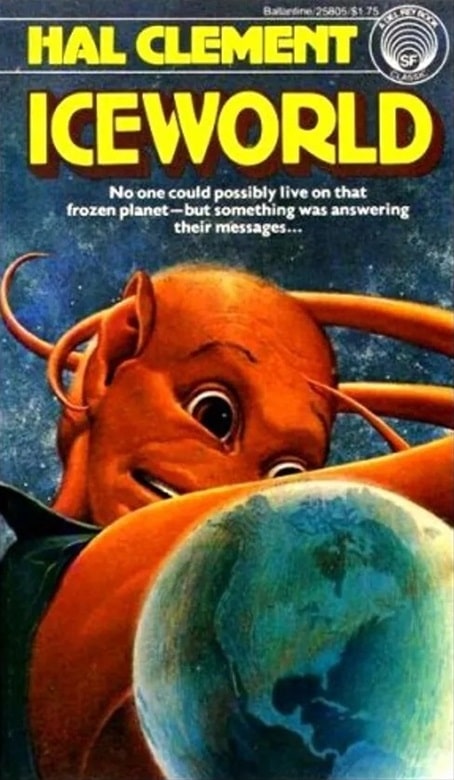
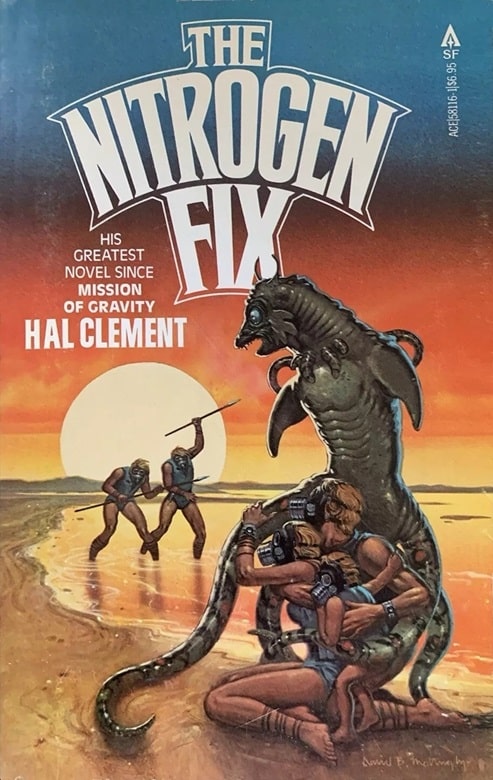
Novels by Hal Clement: Cycle of Fire (Del Rey, February 1975), Iceworld
(Del Rey, October 1977), and The Nitrogen Fix (Ace Books, September 1980).
Covers by Gray Morrow, H. R. Van Dongen, and David B. Mattingly
Hal Clement (real name, Harry Stubbs) was born in 1922 and passed away in 2003. He graduated from Harvard and held degrees in astronomy, chemistry and education. A former B-24 pilot, he worked for most of his life as a high-school science teacher at Milton Academy, in Milton, MA. He gained his reputation as a writer of hard science fiction, a pioneer of the genre. I have read his novels The Nitrogen Fix and Cycle of Fire, both of which I enjoyed immensely.
I got to meet Hal at a sci-fi convention about 30 years ago. I was a struggling young writer in my early 20s, working hard on a science fiction novel modeled in the styles of Edgar Rice Burroughs and Sir Arthur Conan Doyle. Hal was part of a panel discussion on how to break into the writing business. His fellow panelists were comprised of some Star Trek novelists and editors. I was thrilled to attend the panel; with all the youthful exuberance one could imagine.
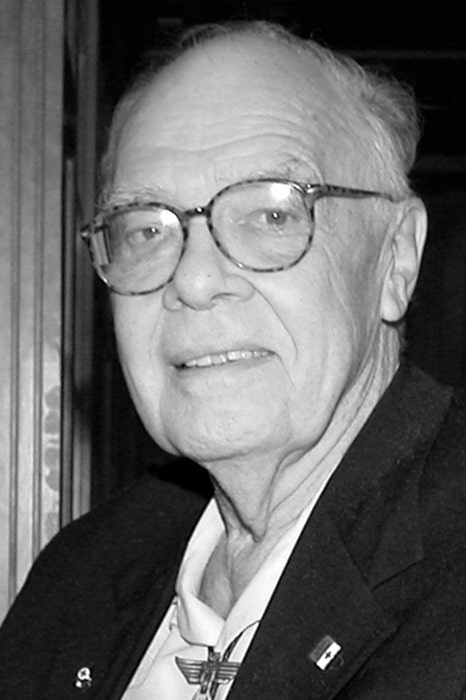 Hal Clement
Hal Clement
After the panel discussion was through and people were milling about, I approached the group of panelists, including Hal. I had five or six manilla envelopes, each containing the first few chapters of my novel. Frightened, yet determined, I introduced myself and asked the panelists if any of them would be willing to take a look at the first few chapters of my book and, if they were so inclined, let me know what they thought of it.
This offended one of the Star Trek novelists (or editors, wasn’t sure), and she tore me down, berating me, telling me that asking this of them was grossly inappropriate, in bad form, and completely unprofessional. Her peers were shaking their heads at me, in agreement with her assessment of my solicitation.
Except for Hal. As the Trek writers and editors walked away, leaving me stunned, Hal said to me, “I’d like to take a look at it.” I was happy but still upset that I’d committed some kind of inexcusable writer’s faux pas, so I awkwardly thanked him and walked away.
I never heard back from Hal, which is fine, but about an hour or so later, walking about the con, I saw him again, sitting in a chair, reading my manuscript.
That gave me hope to keep going, to keep writing. It meant a lot to me then, and it still does to this day.
Jeffrey P. Talanian’s last article for Black Gate was From Al-Qadim to The East Mark Gazetteer. He is the creator and publisher of the Hyperborea sword-and-sorcery and weird science-fantasy RPG from North Wind Adventures. He was the co-author, with E. Gary Gygax, of the Castle Zagyg releases, including several Yggsburgh city supplements, Castle Zagyg: The East Mark Gazetteer, and Castle Zagyg: The Upper Works. Read Gabe Gybing’s interview with Jeffrey here, and follow his latest projects on Facebook and at www.hyperborea.tv.
Reading Leigh Grossman’s Sense of Wonder, the Longest Science Fiction Anthology Ever
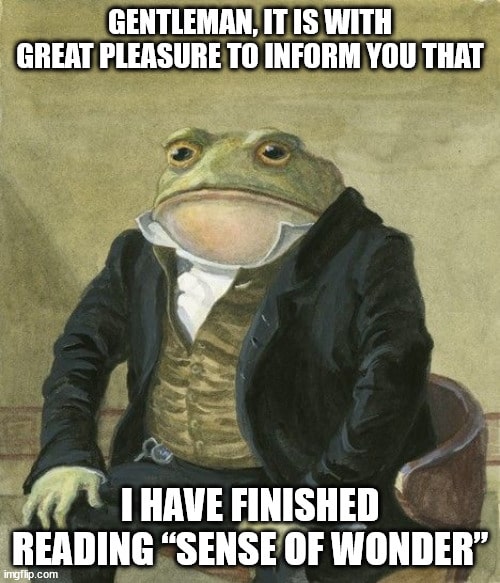 I have finished reading Sense of Wonder
I have finished reading Sense of Wonder
Having just finished reading arguably the longest anthology of science fiction, I’ve written down some notes and thoughts.
TL;DR It’s an insanely long book, worth buying but not necessarily reading cover-to-cover.
About the BookSense of Wonder: A Century of Science Fiction, edited by Leigh Grossman, is a massive single-volume anthology of science-fiction. Don’t be fooled by the 992 print pages because that is with a tiny font. I read the Kindle version for which Amazon gives an average reading time of 140 hours. That is about 5 times as long as Cryptonomicon by Neal Stephenson (itself a 1,200 page door-stopper). All in all, a huge dose of SF.
The book is classified and marketed as a textbook for teaching SF courses and rightly so. Besides over 150 stories (from short stories to novellas), it contains biographical entries about each author and additional essays about related topics. The appendices give advice to aspiring authors on writing and submitting SF stories.
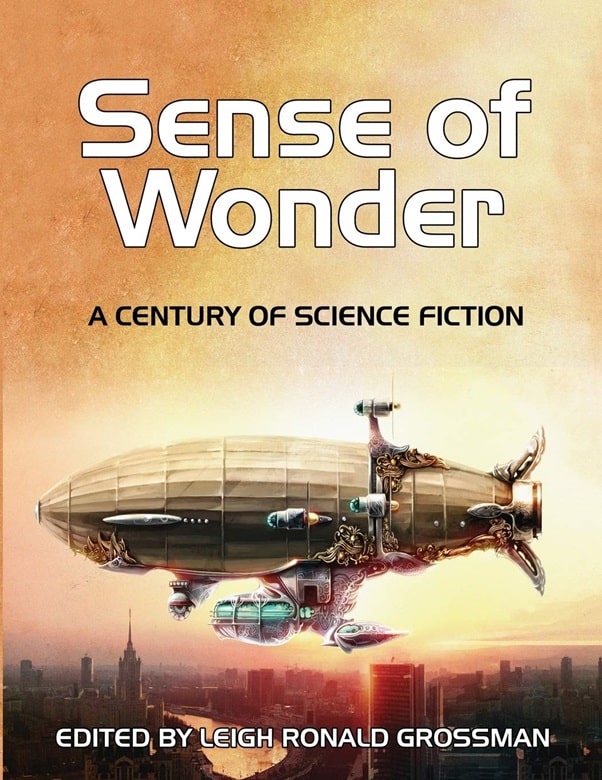

Sense of Wonder: A Century of Science Fiction (Wildside Press, June 1, 2011). Cover art uncredited
In terms of content, Sense of Wonder includes whole “books” like A Princess of Mars by Edgar Rice Burroughs and The Time Machine by H.G. Wells, both from The Classics of Science Fiction – Novels v5 list. It also has at least 34 entries from The Classics of Science Fiction – Short Stories v2 list. Apart from poems, each author appears with only one entry (story).
My OpinionThis book is a bargain! I bought it for $30 and definitely got my money’s worth in terms of content.
I wish it were more of a “best of” anthology. It comes close to that (as evidenced by the number of entries from the Classics list), but in some cases stories were unavailable or the authors had other suggestions. Here’s an example from the editor’s text:
Although he’s best known for his alternate history, when I contacted him about a contribution for this book, Turtledove correctly pointed out that I already had plenty of alternate history in the book, but sorely needed a baseball story.
The essays, each by a different contributor, were generally good, often discussing themes appearing in preceding stories. Some were quite academic (those went over my head) and one was so badly written I’m surprised it got included.
I also wish that the book was less American-centered. Not only in the way information is presented, but also in the selections. There are some by British, Canadian and Australian authors, but other than that only two stories are translated from foreign languages.
NotesI started reading this book in 2001, but at first, I jumped from story to story as I was finishing reading the Classics of Science Fiction – Short Stories v2 list.
Then, halfway through 2024, in an ongoing effort to clean out unread books on my Kindle, I started going through it from the start. I omitted what I had already read, so that helped. To further improve my progress I looked for audio versions of the stories (with a success rate of about 20%).
This lead me to some great finds, such as the production of Terry Bisson’s “They’re Made Out of Meat” by the This American Life podcast. I made a spreadsheet for each story (whether I’d read it before and whether it’s available in audio anywhere) and included a brief review. Filling out the spreadsheets was part of the appeal of this reading challenge.
Favorite StoriesApart from those that appear on the Classics list (and which we know to be good), I gave 5 stars to these stories.
- “Dogwalker” by Orson Scott Card — Great theme (cyberpunk, cracking passwords), fun style, and great audio narration all made this story kick!
- “Soldier, Ask Not” by Gordon R. Dickson — Awesome story of military conflict, loss and revenge. Noticeably well written!
- “Rat Race” by Frank Herbert — Great, like a precursor to X Files.
- “Good with Rice” by John Brunner — Wonderfully written story about modified food set in China.
- “For I Have Touched the Sky” by Mike Resnick — Great Kiringaya story about freedom and choosing the lesser evil.
Of course, there were also stories which I didn’t enjoy, but that’s inevitable with such a large collection.
If you’re interested in short form SF, I would recommend buying Sense of Wonder and starting out by reading the 34 stories already identified as among the best in the field.
The Public Life of Sherlock Holmes: Death (of a Detective) in Paradise
 And we kick off 2025 with the return of the column that earned me regular gig here at Black Gate. I’m ostensibly the in-house mystery guy around here, though I’m way beyond all over the place. Death in Paradise is a police procedural (it is not, however, a buddy cop show) with a fair amount of humor, and it debuted on BBC1 on October 25, 2011. The show started airing a Christmas special a few years ago, and episode number 109 just aired on December 22, 2024.
And we kick off 2025 with the return of the column that earned me regular gig here at Black Gate. I’m ostensibly the in-house mystery guy around here, though I’m way beyond all over the place. Death in Paradise is a police procedural (it is not, however, a buddy cop show) with a fair amount of humor, and it debuted on BBC1 on October 25, 2011. The show started airing a Christmas special a few years ago, and episode number 109 just aired on December 22, 2024.
The basic premise is that Scotland Yard assigns a DCI (Detective Chief Inspector) to duty on the island of Saint Marie (pronounced ‘San Marie’), located in the Lesser Antilles. Saint Marie was turned over to the British by the French roughly forty years before the show starts. So, it still has a French-Caribbean culture.
There is a four-person police unit, with the DCI (Richard Poole) joined by a local Detective Sergeant (Camille), and two local uniform ‘beat cops’ (Dwayne, and Fidel). There are two other regulars: the female owner of a local bar (Catherine, who is Camille’s mother), and the Police Superintendent (Patterson). Five of the six main characters are island natives, so this is a classic fish-out-of-water scenario.
DCI Richard Poole is played by Ben Miller, who was great as Rowan Atkinson’s competent helper-agent in the Johnny English spoofs (the first one is a classic). Miller refuses to take off his jacket or loosen his tie while barely enduring the heat: Stiff upper lip and appearances and all that. He’s constantly miserable, and I love him in the part.
Episodes are an hour long, and the plots are complex. The fictional Saint Marie is near the real-life archipelago (isn’t that a fun word?) of Guadeloupe, which is where it’s actually filmed. The island and its culture are as much a fixture on the show as the actors are.
MINI SPOILER!!! – Just move down to the next paragraph if you don’t want to learn something about the cast. You have been warned.
This show changes cast members more frequently than the Pittsburgh Steelers win a playoff game (though that ain’t saying much). The four main police characters turn over nearly a dozen times. With one notable exception, the new characters brought in work well. Nine actors have appeared in at least 30 episodes (which is about three-plus seasons). Two more actors should break that mark in 2025. So, you get attached to a character at your own risk.
END SPOILER
I think that this is a terrific police show. The British DCI, the local officers, the island setting – it all works. Seasons are short in the typical British fashion (the idea of a 26-episode season must put British TV-makers in shock). It’s also one of several British dramas that has taken to airing a one-off Christmas episode (sometimes sort of a mini-preview of the upcoming season), and I look forward to this one every year now.
BritBox has all seasons, and I recommend going back to the pilot and watching from the beginning. It’s worth every minute.
HERE BE DRAGONS! (and Spoilers)
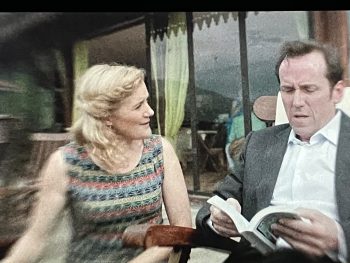 If you haven’t seen the first two seasons, and this episode, you should probably stop reading this, if you plan to do so. There’s a major cast change in the opener of this episode. I wouldn’t want to ruin the surprise. Read on at your peril.
If you haven’t seen the first two seasons, and this episode, you should probably stop reading this, if you plan to do so. There’s a major cast change in the opener of this episode. I wouldn’t want to ruin the surprise. Read on at your peril.
Since the episode is titled Death of a Detective, you might be able to guess what happens. The actor playing the British DI of the moment spends a significant part of their year in Guadalupe, filming. Ben Miller (DI Richard Poole) wanted to be back home in England. It was rumored he would be leaving after season two. The season finale had him escorting a prisoner back to England, and Camille was certain he couldn’t resist remaining there. It looked like he was off the show, but he reappeared at the very end of the episode.
So, I was excited to see him start off the next episode. I thought he would be around for at least one more season. Except, in the first segment, they found him on a chaise on the deck at a college reunion party on the island; with an ice pick in his chest. They killed him off!!! This episode still is a kick in the nuts for me. When they show the body; and there’s a silent, slow-mo montage with the other police there with the body. It’s a really powerful scene.
Now, they set the tone for main characters of the show in the pilot, with two main characters being removed (this wasn’t recasting after testing the pilot – it’s plot). But Poole had been the center of the show for the first two seasons, and I took this as quite a blow.
So we will move on from DCI Richard Poole, but his death scene remains etched in my TV-viewing memory. Don Warrington plays Commissioner Selwyn Patterson. He’s the boss, though he mostly runs things from afar. He sometimes weighs in with the ‘political and social realities’ of things. He’s rather humorless, and he isn’t enthralled with misfit Scotland Yard inspectors, but he’s a good guy overall, if rather stiff.
He comes into the station and we meet Poole’s replacement, DCI Humphrey Goodman, played by Kris Marshall. Humphrey is a different kind of fish out-of-water. He takes awkward to nearly epic levels. His first scene, arriving at the Honore police station in a cab, as the Commissioner and team watch him from the portico, really captures his essence.
There’s a really well-done scene in which he walks over to Richard’s empty desk and says “Uh. This is me, is it?.” It’s set apart, and kind of ‘looks out over’ the rest of the room, including the other three officers’ desks.
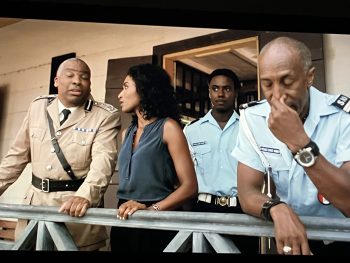 He stops and looks back as they watch him. Clearly seeing another DI about to sit at Richard’s desk is raw at this point. The scene is extended for a second or two and it’s quite poignant.
He stops and looks back as they watch him. Clearly seeing another DI about to sit at Richard’s desk is raw at this point. The scene is extended for a second or two and it’s quite poignant.
He clears his throat awkwardly a few times (everything about him is awkward, constantly), and instead walks to a small desk at the far side of the room. He sits down and says, “Actually, this will be great.”
The chair clicks down and you can only partially see him behind his bag on the desk. He lifts it back up and sits there…yes, awkwardly. I’m not over-emphasizing this, trust me. The team is clearly not impressed with this introduction.
But we have absolutely captured the essence of Humphrey. You’ve got the awkward part by now. Both physically and we’re guessing, socially (though Richard was reserved British socially inept). He’s thoughtful and not brash. He won’t be aggressively confronting suspects. His good nature is built on throughout this episode. The Commissioner has said that London touts him as a good detective, and we will see about that shortly.
Humphrey is constantly looking in his pockets for some scrap of paper to take notes on. I recall he is given a notebook or has one a time or two, but it simply doesn’t work for him. Early on, he pours the coffee out of a cup, flattens it, and starts taking notes on the cup. It is odd to watch. It’s a little thing, but it’s so him.
Fidel and Dwayne try to give him the benefit of the doubt. It’s not easy to do, as Humphrey tries to sit on a ledge at the crime scene and falls out the window while talking!
As the scene ends, with a disapproving look on his face, Dwayne says “Am I seeing things, or did he fall out of the window?”
Fidel looks resigned and says “Yes. Yes he did.” Dwayne shakes his head and walks away. A little later, Dwayne is complaining about Humphrey, and Fidel is telling him that Richard would want them to give him a chance. Even though Fidel is trying to get around how unimpressive the new man has been.
Camille wants nothing to do with him, and she’s a far cry from friendly. The next scene is Humphrey and Camille walking on the beach, and Humphrey can’t stop uncomfortably talking, and being a goober.
He finally says, “You really don’t want me here do you?
“No.”
Humphrey stops walking. “I’m not here to take his place. I’m not here to be him. I don’t expect anything. Any consideration. I’m just here. And while I’m here I promise I will do everything I can to find out what happened to your friend. ‘Cause that’s what he was. Not just your colleague. I’m sorry for your loss. I truly am.”
It’s sincere, and he may be a goober, but we like him. It’s impossible not to.
“But the thing is, I have a feeling I may need some help, and a great deal of it. You can decide if you like me afterwards.”
Camille is not exactly thawing. “And if I don’t?”
Humphrey has a good smile, which even conveys self-deprecation. “Good point. I don’t even have an answer for that.”
He looks down and sees that the surf has come up and his shoes are immersed. It fits his lack of ‘cool’.
“There’s a whole list of things I’m not very good at. But, I am a good detective And right now more than anything, I want to catch the person who murdered your friend. So maybe, just for now, it’s enough that we both want the same thing.”
Camille is looking at him like a surly teenager who has to listen to a parent. But she looks down and says You’re wet”
“Yes I am.”
“Your shoes will dry as we walk.” She says this with maybe the slightest hint of a smile (I’m honestly not sure), turns, and they go on.
 There’s a lot of humor around the British CDIs not fitting in. Though one, who is Irish, actually seems like a rather normal person! But this episode really leverages the emotional impact of Richard’s death, in multiple ways. This is a pretty compelling scene that helps us adopt Humphrey quickly.
There’s a lot of humor around the British CDIs not fitting in. Though one, who is Irish, actually seems like a rather normal person! But this episode really leverages the emotional impact of Richard’s death, in multiple ways. This is a pretty compelling scene that helps us adopt Humphrey quickly.
The assigned CDIs have their different hangups. Along with a marked SUV, the other official vehicle is a motorcycle with a sidecar. Dwayne drives. Richard hated being in the sidecar. But Humphrey finds it “splendid.” This just makes Dwayne shake his head.
If you follow me on FB, you know that I periodically play ‘I Know that Actor,’ where I snap a pic of some actor I know from another show or a movie. I started this years ago with all the great cameos on Columbo. And I do it with shows like Pysch, Monk, and other episodic ones I watch. Murdoch Mysteries is great for Canadian actors, and I do it with Death in Paradise. In this episode, one of the four suspects is Helen Baxendale. She was’ Ross’ British wife Emily, on Friends. She also had the lead on Curtain, the final Hercule Poirot story. I’ve talked about the FANTASTIC series with David Suchet, here.
I’m not going to give away the solution. This is one of those shows where the main detective solves the case without revealing anything, and the suspects are then gathered together for the denouement. This was established with Richard, but Humphrey is put off by the approach. “In front of everyone??” He doesn’t want to do it, but he likes it!
The solution reveals that Richard’s keen intellect, observational skills, and ability to solve a puzzle, led to his murder. It’s a nice farewell to the show’s star.
They actually brought Miller back for a sort-of-dream sequence, in season ten, as he gives advice to a character. It’s a very low-key, powerful scene. I only picked up on one neat element when I re-watched these first two seasons.
Back at the station, Humphrey finds his desk bare. He’s puzzled, looking for his stuff. Camille has set him up at Richard’s old desk. He is the new DCI. It’s nice closure. Humphrey does not join the gathering at the bar. He feels an intruder as they say goodbye to Richard in their own way. He takes a taxi home, but he and Camille have a bond.
The show ends with a voice mail from his wife, who is still behind in England wrapping things up. She is divorcing him. This episode has packed SO much emotion in one hour, from start to finish.
Marshall would stay on the show for three seasons, before the inevitable casting change. I’m not exaggerating when I talk about the turnover. The latest DCI was introduced in the new Christmas special.
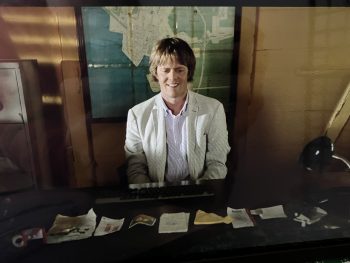 In 2023, a new spinoff show was created, Beyond Paradise. Humphrey is in Devon (Southwest England). He’s still ‘himself’ (another fitting opening scene). The show is as much about his relationship with his girlfriend, as about the crimes. I like it well enough, and it’s been renewed for a third season (they just had a new Christmas special), but I’m not that invested in it.
In 2023, a new spinoff show was created, Beyond Paradise. Humphrey is in Devon (Southwest England). He’s still ‘himself’ (another fitting opening scene). The show is as much about his relationship with his girlfriend, as about the crimes. I like it well enough, and it’s been renewed for a third season (they just had a new Christmas special), but I’m not that invested in it.
I NEVER solve the case on Death in Paradise (which i always a murder, I believe). It’s always convoluted. I think they do a decent job with fair play, but I don’t even try to figure it out anymore. I just enjoy the show.
Series creator Robert Thorogood wrote three Death in Paradise novels, set in the Richard Poole era. I just finished the first, and started the second. They’re okay. No surprise that he has the characters down, and he plays out Richard’s characteristics and his hating living there. But they read slooooow. It took me awhile to complete the first one. It was good enough to continue on, but these aren’t the Monk novels. Or even the Psych ones.
I 100% recommend watching Death in Paradise. It has remained a good show, with no shark jumping. The cast changes work (though there was one police officer I was hoping would be shot in the line of duty – beyond annoying). I hope this keeps rolling along. Check it out.
UPDATE!I did not mention a recent Australian spin-off, Return to Paradise. I haven’t seen it, and from what I could tell, it didn’t actually have anything to do with the original show.
However, I see that DI Jack Mooney (the Irish CDI for four seasons on Death), appeared in two of the six episodes. YAY!!!! I need to watch this show now.
Some previous entries on things to watch:What I’m Watching: October 2024 (What We Do in the Shadows, The Bay, Murder in a Small Town)
What I’m Watching – November 2023 (Brooklyn Nine-Nine, The Caine Mutiny Court Martial, A Haunting in Venice)
What I’m Watching – April 2023 (Florida Man, Picard – season three, The Mandalorian)
The Pale Blue Eye, and The Glass Onion: Knives Out
Tony Hillerman’s Dark Winds
The Rings of Power (Series I wrote on this show – all links at this one post)
What I’m Watching – December 2022 (Frontier, Leverage: Redemption)
What I’m Watching – November 2022 (Tulsa King, Andor, Fire Country, and more)
What I’m Watching – September 2022 (Galavant, Fire Fly, She-Hulk, and more)
What I’m Watching- April 2022 (Outer Range, Halo, Why Didn’t They Ask Evans, and more)
When USA Network was Kicking Major Butt (Monk, Psych, Burn Notice)
You Should be Streaming These Shows (Corba Kai, The Expanse, Bosch, and more)
What I’m BritBoxing – December 2021 (Death in Paradise, Shakespeare & Hathaway, The Blake Mysteries, and more)
To Boldly Go – Star Treking – (Various Star Trek incarnations)
What I’ve Been Watching – August 2021 (Monk, The Tomorrow War, In Plain Sight, and more)
What I’m Watching – June 2021 (Get Shorty, Con Man, Thunder in Paradise, and more)
Tucker and Dale vs. Evil
What I’ve Been Watching – June 2021 (Relic Hunter, Burn Notice, Space Force, and more)
Appaloosa
Psych of the Dead
The Mandalorian
What I’m Watching: 2020 – Part Two (My Name is Bruce, Sword of Sherwood Forest, Isle of Fury, and more)
What I’m Watching 2020: Part One (The Adventures of Brisco County Jr, Poirot, Burn Notice, and more)
Philip Marlowe: Private Eye
Leverage
Nero Wolfe – The Lost Pilot
David Suchet’s ‘Poirot’
Sherlock Holmes (over two dozen TV shows and movies)

Bob Byrne’s ‘A (Black) Gat in the Hand’ made its Black Gate debut in 2018 and has returned every summer since.
His ‘The Public Life of Sherlock Holmes’ column ran every Monday morning at Black Gate from March, 2014 through March, 2017. And he irregularly posts on Rex Stout’s gargantuan detective in ‘Nero Wolfe’s Brownstone.’ He is a member of the Praed Street Irregulars, founded www.SolarPons.com (the only website dedicated to the ‘Sherlock Holmes of Praed Street’).
He organized Black Gate’s award-nominated ‘Discovering Robert E. Howard’ series, as well as the award-winning ‘Hither Came Conan’ series. Which is now part of THE Definitive guide to Conan. He also organized 2023’s ‘Talking Tolkien.’
He has contributed stories to The MX Book of New Sherlock Holmes Stories — Parts III, IV, V, VI, XXI, and XXXIII.
He has written introductions for Steeger Books, and appeared in several magazines, including Black Mask, Sherlock Holmes Mystery Magazine, The Strand Magazine, and Sherlock Magazine.


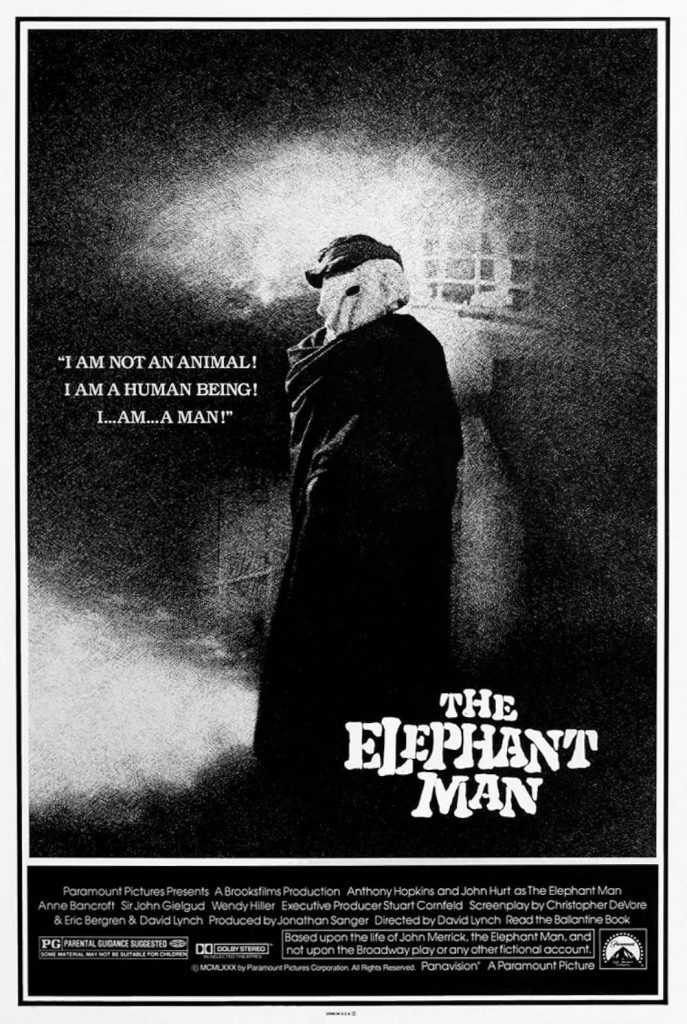
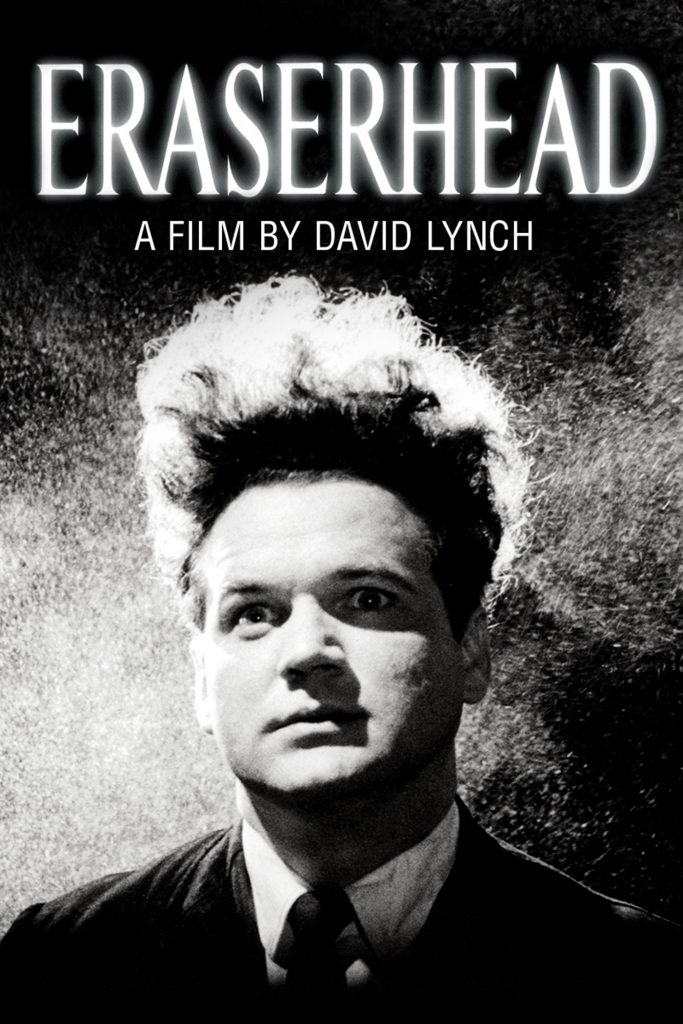
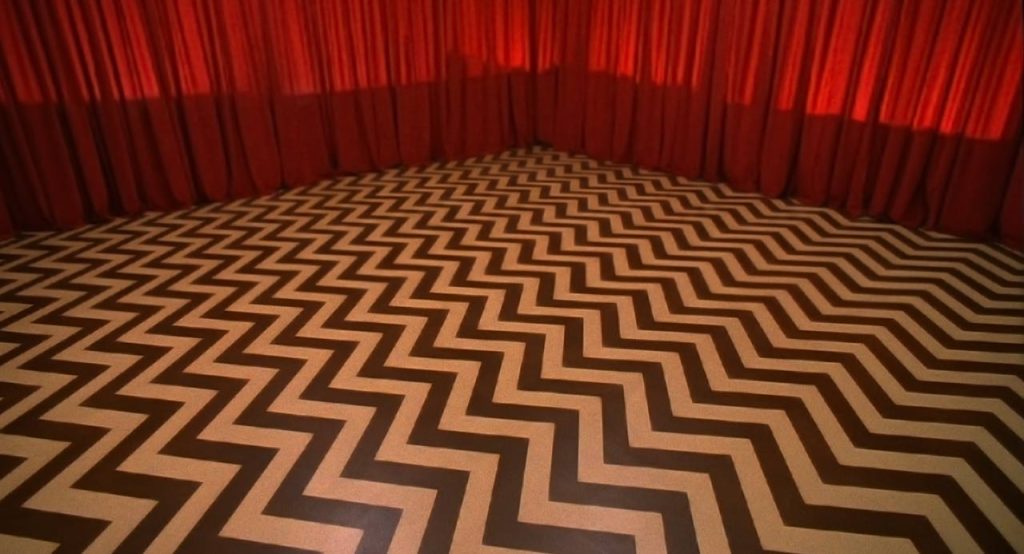


Recent comments